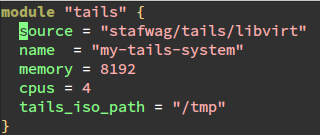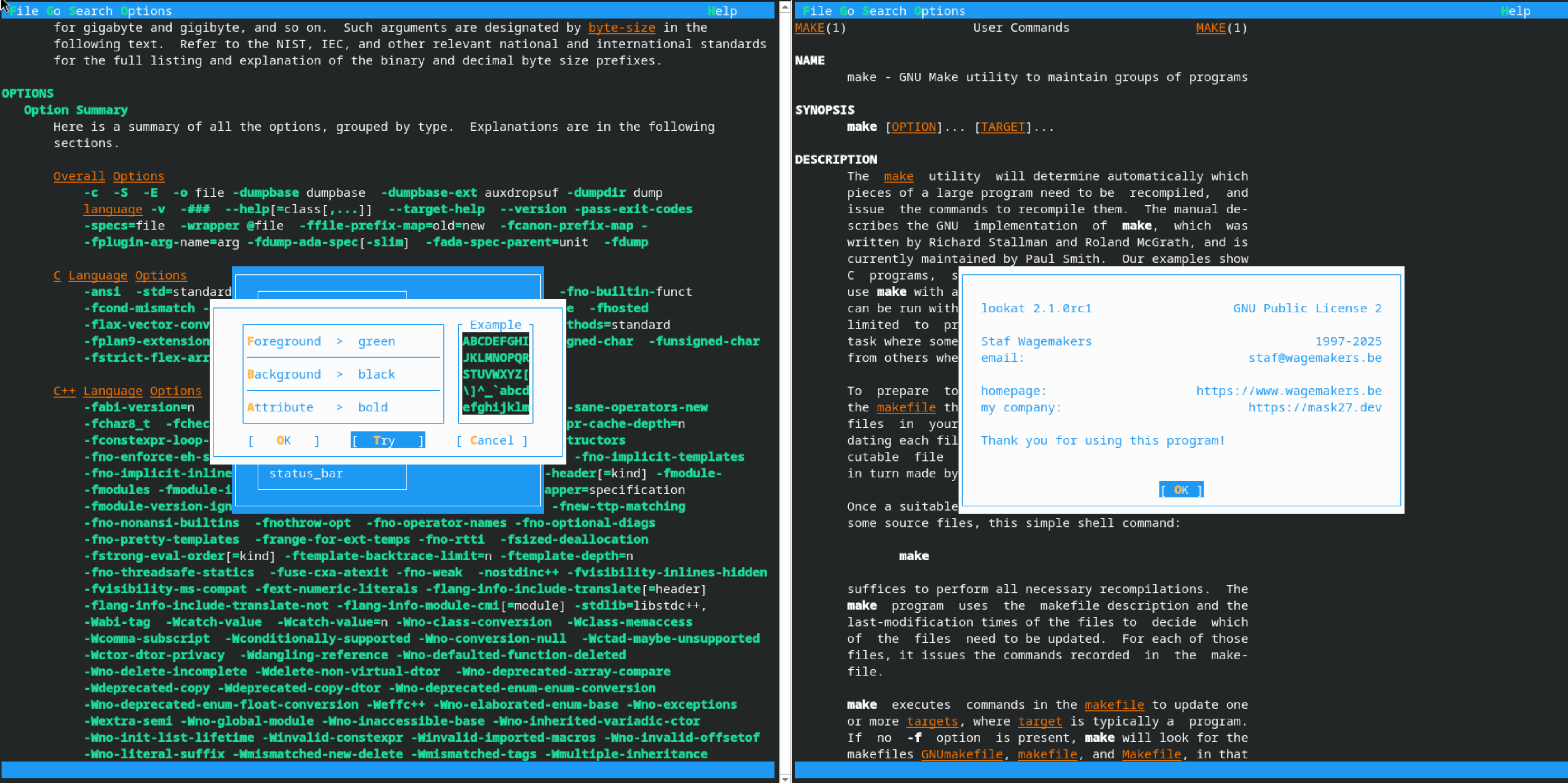July 17, 2025

July 16, 2025
We just got back from a family vacation exploring the Grand Canyon, Zion, and Bryce Canyon. As usual, I planned to write about our travels, but Vanessa, my wife, beat me to it.
She doesn't have a blog, but something about this trip inspired her to put pen to paper. When she shared her writing with me, I knew right away her words captured our vacation better than anything I could write.
Instead of starting from scratch, I asked if I could share her writing here. She agreed. I made light edits for publication, but the story and voice are hers. The photos and captions, however, are mine.
We just wrapped up our summer vacation with the boys, and this year felt like a real milestone. Axl graduated high school, so we let him have input on our destination. His request? To see some of the U.S. National Parks. His first pick was Yosemite, but traveling to California in July felt like gambling with wildfires. So we adjusted course, still heading west, but this time to the Grand Canyon, Zion and Bryce.
As it turned out, we didn't fully avoid the fire season. When we arrived at the Grand Canyon, we learned that wildfires had already been burning near Bryce for weeks. And by the time we were leaving Bryce, the Grand Canyon itself was under evacuation orders in certain areas due to its own active fires. We slipped through a safe window without disruption.
We kicked things off with a couple of nights in Las Vegas. The boys had never been, and it felt like a rite of passage. But after two days of blinking lights, slot machines, and entertainment, we were ready for something quieter. The highlight was seeing O by Cirque du Soleil at the Bellagio. The production had us wondering how many crew members it takes to make synchronized underwater acrobatics look effortless.
 When the Hoover Dam was built, they used an enormous amount of concrete. If they had poured it all at once, it would have taken over a century to cool and harden. Instead, they poured it in blocks and used cooling pipes to manage the heat. Even today, the concrete is still hardening through a process called hydration, so the dam keeps getting stronger over time.
When the Hoover Dam was built, they used an enormous amount of concrete. If they had poured it all at once, it would have taken over a century to cool and harden. Instead, they poured it in blocks and used cooling pipes to manage the heat. Even today, the concrete is still hardening through a process called hydration, so the dam keeps getting stronger over time.
On the Fourth of July, we picked up our rental car and headed to the Hoover Dam for a guided tour. We learned it wasn't originally built to generate electricity, but rather to prevent downstream flooding from the Colorado River. Built in the 1930s, it's still doing its job. And fun fact: the concrete is still curing after nearly a century. It takes about 100 years to fully cure.
While we were at the Hoover Dam, we got the news that Axl was admitted to study civil engineering. A proud moment in a special place centered on engineering and ambition.
From there, we drove to the South Rim of the Grand Canyon and checked into El Tovar. When we say the hotel sits on the rim, we mean right on the rim. Built in 1905, it has hosted an eclectic list of notable guests, including multiple U.S. presidents, Albert Einstein, Liz Taylor, and Paul McCartney. Standing on the edge overlooking the canyon, we couldn't help but imagine them taking in the same view, the same golden light, the same vast silence. That sense of shared wonder, stretched across generations, made the moment special. No fireworks in the desert this Independence Day, but the sunset over the canyon was its own kind of magic.
The next morning, we hiked the Bright Angel Trail to the 3-mile resthouse. Rangers, staff, and even Google warned us to start early. But with teenage boys and jet lag, our definition of "early" meant hitting the trail by 8:30am. By 10am, a ranger reminded us that hiking after that hour is not advised. We pressed on carefully, staying hydrated and dunking our hats and shirts at every water source. Going down was warm. Coming up? Brutal. But we made it, sweaty and proud. Our reward: showers, naps, and well-earned ice cream.
Next up: Zion. We stopped at Horseshoe Bend on the way, a worthy detour with dramatic views of the Colorado River. By the time we entered Zion National Park, we were in total disbelief. The landscape was so perfectly sculpted it didn't look real. Towering red cliffs, hanging gardens, and narrow slot canyons surrounded us. I told Dries, "It's like we're driving through Disneyland", and I meant that in the best way.
 We visited Horseshoe Bend, a dramatic curve in the Colorado River near the Grand Canyon. A quiet reminder of what time and a patient river can carve out together.
We visited Horseshoe Bend, a dramatic curve in the Colorado River near the Grand Canyon. A quiet reminder of what time and a patient river can carve out together.
After a long drive, we jumped in the shared pool at our rental house and met other first-time visitors who were equally blown away. That night, we celebrated our six year wedding anniversary with tacos and cocktails at a cantina inside a converted gas station. Nothing fancy, but a good memory.
One thing that stood out in Zion was the deer. They roamed freely through the neighborhoods and seemed unbothered by our presence. Every evening, a small group would quietly wander through our yard, grazing on grass and garden beds like they owned the place.
The next morning, we hiked The Narrows, wading through the Virgin River in full gear. Our guide shared stories and trail history, and most importantly, brought a charcuterie board. We hike for snacks, after all. Learning how indigenous communities thrived in these canyons for thousands of years gave us a deeper connection to the land, especially for me, as someone with Native heritage.
 We hiked 7.5 miles through the Narrows in Zion National Park. Most of the hike is actually in the river itself, with towering canyon walls rising all around you. One of my favorite hikes ever.
We hiked 7.5 miles through the Narrows in Zion National Park. Most of the hike is actually in the river itself, with towering canyon walls rising all around you. One of my favorite hikes ever.
 Taking a moment to look up and take it all in.
Taking a moment to look up and take it all in.
 Wading forward together through the Narrows in Zion.
Wading forward together through the Narrows in Zion.
The following day was for rappelling, scrambling, and hiking. The boys were hyped, memories of rappelling in Spain had them convinced there would be waterfalls. Spoiler: there weren't. It hadn't rained in Zion for months. But dry riverbeds didn't dull the excitement. We even found shell fossils embedded in the sandstone. Proof the area was once underwater.
 Time has a way of flipping the roles.
Time has a way of flipping the roles.
 Getting ready to rappel in Zion, and enjoying every moment of it.
Getting ready to rappel in Zion, and enjoying every moment of it.
 Making our way through the narrow slots in Zion.
Making our way through the narrow slots in Zion.
From Zion, we headed to Bryce Canyon. The forecast promised cooler temperatures, and we couldn't wait. We stayed at Under Canvas, a glamping site set in open range cattle territory. Canvas tents with beds and private bathrooms, but no electricity or WiFi. Cue the family debate: "Is this camping or hoteling?" Dries, Axl and Stan voted for "hoteling". I stood alone on "team camping". (Spoiler: it is camping when there are no outlets.) Without our usual creature comforts, we slowed down. We read. We played board games. We played cornhole. We watched sunsets and made s'mores.
 Glamping in the high desert outside Bryce, Utah. Even in summer, the high elevation brings cool evenings, and the fire felt perfect after a day on the trail.
Glamping in the high desert outside Bryce, Utah. Even in summer, the high elevation brings cool evenings, and the fire felt perfect after a day on the trail.
The next day, we hiked the Fairyland Loop, eight miles along the rim with panoramic views into Bryce's otherworldly amphitheater of hoodoos. The towering spires and sculpted rock formations gave the park an almost storybook quality, as if the landscape had been carved by imagination rather than erosion. Though the temperature was cooler, the sun still packed a punch, so we were glad to finish before the midday heat. At night, the temperature dropped quickly once the sun went down. We woke up to 45°F (about 7°C) mornings, layering with whatever warm clothes we had packed, which, given we planned for desert heat, wasn't much.
One of our most memorable mornings came with a 4:30 am wake-up call to watch the sunrise at Sunrise Point. We had done something similar with the boys at Acadia in 2018. It's a tough sell at that hour, but always worth it. As the sun broke over the canyon, the hoodoos lit up in shades of orange and gold unlike anything we'd seen the day before. Afterward, we hiked Navajo Loop and Queen's Garden and were ready for a big breakfast at the lodge.
 Up before sunrise to watch the hoodoos glow at Bryce Canyon in Utah. Cold and early, but unforgettable.
Up before sunrise to watch the hoodoos glow at Bryce Canyon in Utah. Cold and early, but unforgettable.
 Vanessa making her way down through the hoodoos on the Navajo Loop in Bryce Canyon.
Vanessa making her way down through the hoodoos on the Navajo Loop in Bryce Canyon.
Later that day, we visited Mossy Cave Trail. We followed the stream, poked around the waterfall, and hunted for fossils. Axl and I were on a mission, cracking open sandstone rocks in hopes of finding hidden treasures. Mostly, we just made a mess (of ourselves). I did stumble upon a tiny sliver of geode ... nature's way of rewarding persistence, I suppose.
Before heading to Salt Lake City for laundry (yes, that's a thing after hiking in the desert for a week), we squeezed in one more thrill: whitewater rafting on the Sevier River. Our guide, Ryan, was part comedian, part chaos agent. His goal was to get the boys drenched! The Class II and III rapids were mellow but still a blast, especially since the river was higher than expected for July. We all stayed in the raft, mostly wet, mostly laughing.
Incredibly, throughout the trip, none of us got sunburned, despite hiking in triple digit heat, rappelling down canyon walls, and rafting under a cloudless sky. We each drank about 4 to 6 liters of water a day, and no one passed out, so we're calling it a win.
On our final evening, during dinner, I pulled out a vacation questionnaire I had created without telling anyone. Since the boys aren't always quick to share what they loved, I figured it was a better way to ask everyone to rate their experience. What did they love? What would they skip next time? What do they want more of, less of, or never again? It was a simple way to capture the moment, create conversation, reflect on what stood out, and maybe even help shape the next trip. Turns out, teens do have opinions, especially when sunrises and physical exertion are involved.
This trip was special. When I was a kid, I thought hiking and parks were boring. Now, it's what Dries and I seek out. We felt grateful we could hike, rappel, raft, and laugh alongside the boys. We created memories we hope they'll carry with them, long after this summer fades. We're proud of the young men they're becoming, and we can't wait for the next chapter in our family adventures.
File deduplication isn’t just for massive storage arrays or backup systems—it can be a practical tool for personal or server setups too. In this post, I’ll explain how I use hardlinking to reduce disk usage on my Linux system, which directories are safe (and unsafe) to link, why I’m OK with the trade-offs, and how I automated it with a simple monthly cron job using a neat tool called hadori.
 What Is Hardlinking?
What Is Hardlinking?
In a traditional filesystem, every file has an inode, which is essentially its real identity—the data on disk. A hard link is a different filename that points to the same inode. That means:
- The file appears to exist in multiple places.
- But there’s only one actual copy of the data.
- Deleting one link doesn’t delete the content, unless it’s the last one.
Compare this to a symlink, which is just a pointer to a path. A hardlink is a pointer to the data.
So if you have 10 identical files scattered across the system, you can replace them with hardlinks, and boom—nine of them stop taking up extra space.
 Why Use Hardlinking?
Why Use Hardlinking?
My servers run a fairly standard Ubuntu install, and like most Linux machines, the root filesystem accumulates a lot of identical binaries and libraries—especially across /bin, /lib, /usr, and /opt.
That’s not a problem… until you’re tight on disk space, or you’re just a curious nerd who enjoys squeezing every last byte.
In my case, I wanted to reduce disk usage safely, without weird side effects.
Hardlinking is a one-time cost with ongoing benefits. It’s not compression. It’s not archival. But it’s efficient and non-invasive.
 Which Directories Are Safe to Hardlink?
Which Directories Are Safe to Hardlink?
Hardlinking only works within the same filesystem, and not all directories are good candidates.
 Safe directories:
Safe directories:
/bin,/sbin– system binaries/lib,/lib64– shared libraries/usr,/usr/bin,/usr/lib,/usr/share,/usr/local– user-space binaries, docs, etc./opt– optional manually installed software
These contain mostly static files: compiled binaries, libraries, man pages… not something that changes often.
 Unsafe or risky directories:
Unsafe or risky directories:
/etc– configuration files, might change frequently/var,/tmp– logs, spools, caches, session data/home– user files, temporary edits, live data/dev,/proc,/sys– virtual filesystems, do not touch
If a file is modified after being hardlinked, it breaks the deduplication (the OS creates a copy-on-write scenario), and you’re back where you started—or worse, sharing data you didn’t mean to.
That’s why I avoid any folders with volatile, user-specific, or auto-generated files.
 Risks and Limitations
Risks and Limitations
Hardlinking is not magic. It comes with sharp edges:
- One inode, multiple names: All links are equal. Editing one changes the data for all.
- Backups: Some backup tools don’t preserve hardlinks or treat them inefficiently.
➤ Duplicity, which I use, does not preserve hardlinks. It backs up each linked file as a full copy, so hardlinking won’t reduce backup size. - Security: Linking files with different permissions or owners can have unexpected results.
- Limited scope: Only works within the same filesystem (e.g., can’t link
/and/mntif they’re on separate partitions).
In my setup, I accept those risks because:
- I’m only linking read-only system files.
- I never link config or user data.
- I don’t rely on hardlink preservation in backups.
- I test changes before deploying.
In short: I know what I’m linking, and why.
 What the Critics Say About Hardlinking
What the Critics Say About Hardlinking
Not everyone loves hardlinks—and for good reasons. Two thoughtful critiques are:
The core arguments:
- Hardlinks violate expectations about file ownership and identity.
- They can break assumptions in software that tracks files by name or path.
- They complicate file deletion logic—deleting one name doesn’t delete the content.
- They confuse file monitoring and logging tools, since it’s hard to tell if a file is “new” or just another name.
- They increase the risk of data corruption if accidentally modified in-place by a script that assumes it owns the file.
Why I’m still OK with it:
These concerns are valid—but mostly apply to:
- Mutable files (e.g., logs, configs, user data)
- Systems with untrusted users or dynamic scripts
- Software that relies on inode isolation or path integrity
In contrast, my approach is intentionally narrow and safe:
- I only deduplicate read-only system files in
/bin,/sbin,/lib,/lib64,/usr, and/opt. - These are owned by root, and only changed during package updates.
- I don’t hardlink anything under
/home,/etc,/var, or/tmp. - I know exactly when the cron job runs and what it targets.
So yes, hardlinks can be dangerous—but only if you use them in the wrong places. In this case, I believe I’m using them correctly and conservatively.
 Does Hardlinking Impact System Performance?
Does Hardlinking Impact System Performance?
Good news: hardlinks have virtually no impact on system performance in everyday use.
Hardlinks are a native feature of Linux filesystems like ext4 or xfs. The OS treats a hardlinked file just like a normal file:
- Reading and writing hardlinked files is just as fast as normal files.
- Permissions, ownership, and access behave identically.
- Common tools (
ls,cat,cp) don’t care whether a file is hardlinked or not. - Filesystem caches and memory management work exactly the same.
The only difference is that multiple filenames point to the exact same data.
Things to keep in mind:
- If you edit a hardlinked file, all links see that change because there’s really just one file.
- Some tools (backup, disk usage) might treat hardlinked files differently.
- Debugging or auditing files can be slightly trickier since multiple paths share one inode.
But from a performance standpoint? Your system won’t even notice the difference.
 Tools for Hardlinking
Tools for Hardlinking
There are a few tools out there:
fdupes– finds duplicates and optionally replaces with hardlinksrdfind– more sophisticated detectionhardlink– simple but limitedjdupes– high-performance fork of fdupes
 About Hadori
About Hadori
From the Debian package description:
This might look like yet another hardlinking tool, but it is the only one which only memorizes one filename per inode. That results in less memory consumption and faster execution compared to its alternatives. Therefore (and because all the other names are already taken) it’s called “Hardlinking DOne RIght”.
Advantages over other tools:
- Predictability: arguments are scanned in order, each first version is kept
- Much lower CPU and memory consumption compared to alternatives
This makes hadori especially suited for system-wide deduplication where efficiency and reliability matter.
 How I Use Hadori
How I Use Hadori
I run hadori once per month with a cron job. I used Ansible to set it up, but that’s incidental—this could just as easily be a line in /etc/cron.monthly.
Here’s the actual command:
/usr/bin/hadori --verbose /bin /sbin /lib /lib64 /usr /opt
This scans those directories, finds duplicate files, and replaces them with hardlinks when safe.
And here’s the crontab entry I installed (via Ansible):
roles:
- debops.debops.cron
cron__jobs:
hadori:
name: Hardlink with hadori
special_time: monthly
job: /usr/bin/hadori --verbose /bin /sbin /lib /lib64 /usr /opt
Which then created the file /etc/cron.d/hadori:
#Ansible: Hardlink with hadori
@monthly root /usr/bin/hadori --verbose /bin /sbin /lib /lib64 /usr /opt
 What Are the Results?
What Are the Results?
After the first run, I saw a noticeable reduction in used disk space, especially in /usr/lib and /usr/share. On my modest VPS, that translated to about 300–500 MB saved—not huge, but non-trivial for a small root partition.
While this doesn’t reduce my backup size (Duplicity doesn’t support hardlinks), it still helps with local disk usage and keeps things a little tidier.
And because the job only runs monthly, it’s not intrusive or performance-heavy.
 Final Thoughts
Final Thoughts
Hardlinking isn’t something most people need to think about. And frankly, most people probably shouldn’t use it.
But if you:
- Know what you’re linking
- Limit it to static, read-only system files
- Automate it safely and sparingly
…then it can be a smart little optimization.
With a tool like hadori, it’s safe, fast, and efficient. I’ve read the horror stories—and decided that in my case, they don’t apply.
 This post was brought to you by a monthly cron job and the letters i-n-o-d-e.
This post was brought to you by a monthly cron job and the letters i-n-o-d-e.
July 09, 2025
A few weeks ago, I was knee-deep in CSV files. Not the fun kind. These were automatically generated reports from Cisco IronPort, and they weren’t exactly what I’d call analysis-friendly. Think: dozens of columns wide, thousands of rows, with summary data buried in awkward corners.
I was trying to make sense of incoming mail categories—Spam, Clean, Malware—and the numbers that went with them. Naturally, I opened the file in Excel, intending to wrangle the data manually like I usually do. You know: transpose the table, delete some columns, rename a few headers, calculate percentages… the usual grunt work.
But something was different this time. I noticed the “Get & Transform” section in Excel’s Data ribbon. I had clicked it before, but this time I gave it a real shot. I selected “From Text/CSV”, and suddenly I was in a whole new environment: Power Query Editor.
 Wait, What Is Power Query?
Wait, What Is Power Query?
For those who haven’t met it yet, Power Query is a powerful tool in Excel (and also in Power BI) that lets you import, clean, transform, and reshape data before it even hits your spreadsheet. It uses a language called M, but you don’t really have to write code—although I quickly did, of course, because I can’t help myself.
In the editor, every transformation step is recorded. You can rename columns, remove rows, change data types, calculate new columns—all through a clean interface. And once you’re done, you just load the result into Excel. Even better: you can refresh it with one click when the source file updates.
 From Curiosity to Control
From Curiosity to Control
Back to my IronPort report. I used Power Query to:
- Transpose the data (turn columns into rows),
- Remove columns I didn’t need,
- Rename columns to something meaningful,
- Convert text values to numbers,
- Calculate the percentage of each message category relative to the total.
All without touching a single cell in Excel manually. What would have taken 15+ minutes and been error-prone became a repeatable, refreshable process. I even added a “Percent” column that showed something like 53.4%—formatted just the way I wanted.
 The Geeky Bit (Optional)
The Geeky Bit (Optional)
I quickly opened the Advanced Editor to look at the underlying M code. It was readable! With a bit of trial and error, I started customizing my steps, renaming variables for clarity, and turning a throwaway transformation into a well-documented process.
This was the moment it clicked: Power Query is not just a tool; it’s a pipeline.
 Lessons Learned
Lessons Learned
- Sometimes it pays to explore what’s already in the software you use every day.
- Excel is much more powerful than most people realize.
- Power Query turns tedious cleanup work into something maintainable and even elegant.
- If you do something in Excel more than once, Power Query is probably the better way.
 What’s Next?
What’s Next?
I’m already thinking about integrating this into more of my work. Whether it’s cleaning exported logs, combining reports, or prepping data for dashboards, Power Query is now part of my toolkit.
If you’ve never used it, give it a try. You might accidentally discover your next favorite tool—just like I did.
Have you used Power Query before? Let me know your tips or war stories in the comments!
July 02, 2025
Lately, I’ve noticed something strange happening in online discussions: the humble em dash (—) is getting side-eyed as a telltale sign that a text was written with a so-called “AI.” I prefer the more accurate term: LLM (Large Language Model), because “artificial intelligence” is a bit of a stretch — we’re really just dealing with very complicated statistics 
 .
.

Now, I get it — people are on high alert, trying to spot generated content. But I’d like to take a moment to defend this elegant punctuation mark, because I use it often — and deliberately. Not because a machine told me to, but because it helps me think  .
.
A Typographic Tool, Not a Trend 
The em dash has been around for a long time — longer than most people realize. The oldest printed examples I’ve found are in early 17th-century editions of Shakespeare’s plays, published by the printer Okes in the 1620s. That’s not just a random dash on a page — that’s four hundred years of literary service  . If Shakespeare’s typesetters were using em dashes before indoor plumbing was common, I think it’s safe to say they’re not a 21st-century LLM quirk.
. If Shakespeare’s typesetters were using em dashes before indoor plumbing was common, I think it’s safe to say they’re not a 21st-century LLM quirk.
 The Tragedy of Othello, the Moor of Venice, with long dashes (typeset here with 3 dashes)
The Tragedy of Othello, the Moor of Venice, with long dashes (typeset here with 3 dashes)
A Dash for Thoughts 
In Dutch, the em dash is called a gedachtestreepje — literally, a thought dash. And honestly? I think that’s beautiful. It captures exactly what the em dash does: it opens a little mental window in your sentence. It lets you slip in a side note, a clarification, an emotion, or even a complete detour — just like a sudden thought that needs to be spoken before it disappears. For someone like me, who often thinks in tangents, it’s the perfect punctuation.
Why I Use the Em Dash (And Other Punctuation Marks)
I’m autistic, and that means a few things for how I write. I tend to overshare and infodump — not to dominate the conversation, but to make sure everything is clear. I don’t like ambiguity. I don’t want anyone to walk away confused. So I reach for whatever punctuation tools help me shape my thoughts as precisely as possible:
- Colons help me present information in a tidy list — like this one.
- Brackets let me add little clarifications (without disrupting the main sentence).
- And em dashes — ah, the em dash — they let me open a window mid-sentence to give you extra context, a bit of tone, or a change in pace.
They’re not random. They’re intentional. They reflect how my brain works — and how I try to bridge the gap between thoughts and words  .
.
It’s Not Just a Line — It’s a Rhythm 
There’s also something typographically beautiful about the em dash. It’s not a hyphen (-), and it’s not a middling en dash (–). It’s long and confident. It creates space for your eyes and your thoughts. Used well, it gives writing a rhythm that mimics natural speech, especially the kind of speech where someone is passionate about a topic and wants to take you on a detour — just for a moment — before coming back to the main road  .
.
I’m that someone.
Don’t Let the Bots Scare You
Yes, LLMs tend to use em dashes. So do thoughtful human beings. Let’s not throw centuries of stylistic nuance out the window because a few bots learned how to mimic good writing. Instead of scanning for suspicious punctuation, maybe we should pay more attention to what’s being said — and how intentionally  .
.
So if you see an em dash in my writing, don’t assume it came from a machine. It came from me — my mind, my style, my history with language. And I’m not going to stop using it just because an algorithm picked up the habit  .
.
July 01, 2025

AI is rewriting the rules of how we work and create. Expert developers can now build faster, non-developers can build software, research is accelerating, and human communication is improving. In the next 10 years, we'll probably see a 1,000x increase in AI demand. That is why Drupal is investing heavily in AI.
But at the same time, AI companies are breaking the web's fundamental economic model. This problem demands our attention.
The AI extraction problem
For 25 years, we built the Open Web on an implicit agreement: search engines could index our content because they sent users back to our websites. That model helped sustain blogs, news sites, and even open source projects.
AI companies broke that model. They train on our work and answer questions directly in their own interfaces, cutting creators out entirely. Anthropic's crawler reportedly makes 70,000 website requests for every single visitor it sends back. That is extraction, not exchange.
This is the Makers and Takers problem all over again.
The damage is real:
- Chegg, an online learning platform, filed an antitrust lawsuit against Google, claiming that AI-powered search answers have crushed their website traffic and revenue.
- Stack Overflow has seen a significant drop in daily active users and new questions (about 25-50%), as more developers turn to ChatGPT for faster answers.
- I recently spoke with a recipe blogger who is a solo entrepreneur. With fewer visitors, they're earning less from advertising. They poured their heart, craft, and sweat into creating a high-quality recipe website, but now they believe their small business won't survive.
None of this should surprise us. According to Similarweb, since Google launched "AI Overviews", the number of searches that result in no click-throughs has increased from 56% in May 2024 to 69% in May 2025, meaning users get their answers directly on the results page.
This "zero-click" phenomenon reinforces the shift I described in my 2015 post, "The Big Reverse of the Web". Ten years ago, I argued that the web was moving away from sending visitors out to independent sites and instead keeping them on centralized platforms, all in the name of providing a faster and more seamless user experience.
However, the picture isn't entirely negative. Some companies find that visitors from AI tools, while small in volume, convert at much higher rates. At Acquia, the company I co-founded, traffic from AI chatbots makes up less than 1 percent of total visitors but converts at over 6 percent, compared to typical rates of 2 to 3 percent. We are still relatively early in the AI adoption cycle, so time will tell how this trend evolves, how marketers adapt, and what new opportunities it might create.
Finding a new equilibrium
There is a reason this trend has taken hold: users love it. AI-generated answers provide instant, direct information without extra clicks. It makes traditional search engines look complicated by comparison.
But this improved user experience comes at a long-term cost. When value is extracted without supporting the websites and authors behind it, it threatens the sustainability of the content we all rely on.
I fully support improving the user experience. That should always come first. But it also needs to be balanced with fair support for creators and the Open Web.
We should design systems that share value more fairly among users, AI companies, and creators. We need a new equilibrium that sustains creative work, preserves the Open Web, and still delivers the seamless experiences users expect.
Some might worry it is already too late, since large AI companies have massive scraped datasets and can generate synthetic data to fill gaps. But I'm not so sure. The web will keep evolving for decades, and no model can stay truly relevant without fresh, high-quality content.
From voluntary rules to enforcement
We have robots.txt, a simple text file that tells crawlers which parts of a website they can access. But it's purely voluntary. Creative Commons launched CC Signals last week, allowing content creators to signal how AI can reuse their work. But both robots.txt and CC Signals are "social contracts" that are hard to enforce.
Today, Cloudflare announced they will default to blocking AI crawlers from accessing content. This change lets website owners decide whether to allow access and whether to negotiate compensation. Cloudflare handles 20% of all web traffic. When an AI crawler tries to access a website protected by Cloudflare, it must pass through Cloudflare's servers first. This allows Cloudflare to detect crawlers that ignore robots.txt directives and block them.
This marks a shift from purely voluntary signals to actual technical enforcement. Large sites could already afford their own infrastructure to detect and block crawlers or negotiate licensing deals directly. For example, Reddit signed a $60 million annual deal with Google to license its content for AI training.
However, most content creators, like you and I, can do neither.
Cloudflare's actions establish a crucial principle: AI training data has a price, and creators deserve to share in the value AI generates from their work.
The missing piece: content licensing marketplaces
Accessible enforcement infrastructure is step one, and Cloudflare now provides that. Step two would be a content licensing marketplace that helps broker deals between AI companies and content creators at any scale. This would move us from simply blocking to creating a fair economic exchange.
To the best of my knowledge, such marketplaces do not exist yet, but the building blocks are starting to emerge. Matthew Prince, CEO of Cloudflare, has hinted that Cloudflare may be working on building such a marketplace, and I think it is a great idea.
I don't know what that will look like, but I imagine something like Shutterstock for AI training data, combined with programmatic pricing like Google Ads. On Shutterstock, photographers upload images, set licensing terms, and earn money when companies license their photos. Google Ads automatically prices and places millions of ads without manual negotiations. A future content licensing marketplace could work in a similar way: creators would set licensing terms (like they do on Shutterstock), while automated systems manage pricing and transactions (as Google Ads does).
Today, only large platforms like Reddit can negotiate direct licensing deals with AI companies. A marketplace with programmatic pricing would make licensing accessible to creators of all sizes. Instead of relying on manual negotiations or being scraped for free, creators could opt into fair, programmatic licensing programs.
This would transform the dynamic from adversarial blocking to collaborative value creation. Creators get compensated. AI companies get legal, high-quality training data. Users benefit from better AI tools built on ethically sourced content.
Making the Open Web sustainable
We built the Open Web to democratize access to knowledge and online publishing. AI advances this mission of democratizing knowledge. But we also need to ensure the people who write, record, code, and share that knowledge aren't left behind.
The issue is not that AI exists. The problem is that we have not built economic systems to support the people and organizations that AI relies on. This affects independent bloggers, large media companies, and open source maintainers whose code and documentation train coding assistants.
Call me naive, but I believe AI companies want to work with content creators to solve this. Their challenge is that no scalable system exists to identify, contact, and pay millions of content creators.
Content creators lack tools to manage and monetize their rights. AI companies lack systems to discover and license content at scale. Cloudflare's move is a first step. The next step is building content licensing marketplaces that connect creators directly with AI companies.
The Open Web needs economic systems that sustain the people who create its content. There is a unique opportunity here: if content creators and AI companies build these systems together, we could create a stronger, more fair, and more resilient Web than we have had in 25 years. The jury is out on that, but one can dream.
Disclaimer: Acquia, my company, has a commercial relationship with Cloudflare, but this perspective reflects my long-standing views on sustainable web economics, not any recent briefings or partnerships.
June 25, 2025
Soms zit het mee, soms nét niet. Het herenhuis waar we helemaal verliefd op waren, is helaas aan iemand anders verhuurd. Jammer, maar we blijven niet bij de pakken zitten. We zoeken verder — en hopelijk kan jij ons daarbij helpen!
Wij zijn drie mensen die samen een huis willen delen in Gent. We vormen een warme, bewuste en respectvolle woongroep, en we dromen van een plek waar we rust, verbinding en creativiteit kunnen combineren.
Wie zijn wij?
 Amedee (48): IT’er, balfolkdanser, amateurmuzikant, houdt van gezelschapsspelletjes en wandelen, auti en sociaal geëngageerd
Amedee (48): IT’er, balfolkdanser, amateurmuzikant, houdt van gezelschapsspelletjes en wandelen, auti en sociaal geëngageerd Chloë (bijna 52): Kunstenares, ex-Waldorfleerkracht en permacultuurontwerpster, houdt van creativiteit, koken en natuur
Chloë (bijna 52): Kunstenares, ex-Waldorfleerkracht en permacultuurontwerpster, houdt van creativiteit, koken en natuur Kathleen (54): Doodle-artiest met sociaal-culturele achtergrond, houdt van gezelligheid, buiten zijn en schrijft graag
Kathleen (54): Doodle-artiest met sociaal-culturele achtergrond, houdt van gezelligheid, buiten zijn en schrijft graag
We willen samen een huis vormen waar communicatie, zorgzaamheid en vrijheid centraal staan. Een plek waar je je thuis voelt, en waar ruimte is voor kleine activiteiten zoals een spelavond, een workshop, een creatieve sessie of gewoon rustig samen zijn.
Wat zoeken we?
 Een huis (géén appartement) in Gent, op max. 15 minuten fietsen van station Gent-Sint-Pieters
Een huis (géén appartement) in Gent, op max. 15 minuten fietsen van station Gent-Sint-Pieters Energiezuinig: EPC B of beter
Energiezuinig: EPC B of beter Minstens 3 ruime slaapkamers van ±20m²
Minstens 3 ruime slaapkamers van ±20m² Huurprijs:
Huurprijs:
- tot €1650/maand voor 3 slaapkamers
- tot €2200/maand voor 4 slaapkamers
Extra ruimtes zoals een zolder, logeerkamer, atelier, bureau of hobbyruimte zijn heel welkom. We houden van luchtige, multifunctionele plekken die mee kunnen groeien met onze noden.
 Beschikbaar: vanaf nu, ten laatste oktober
Beschikbaar: vanaf nu, ten laatste oktober
Heeft het huis 4 slaapkamers? Dan verwelkomen we graag een vierde huisgenoot die onze waarden deelt. Maar meer dan 4 bewoners willen we bewust vermijden — kleinschalig wonen werkt voor ons het best.
Ken jij iets? Laat van je horen!
Ken je een huis dat past in dit plaatje?
We staan open voor tips via immokantoren, vrienden, buren, collega’s of andere netwerken — alles helpt!
 Contact: amedee@vangasse.eu
Contact: amedee@vangasse.eu
Dankjewel om mee uit te kijken — en delen mag altijd 
June 24, 2025

In my post about digital gardening and public notes, I shared a principle I follow: "If a note can be public, it should be". I also mentioned using Obsidian for note-taking. Since then, various people have asked about my Obsidian setup.
I use Obsidian to collect ideas over time rather than to manage daily tasks or journal. My setup works like a Commonplace book, where you save quotes, thoughts, and notes to return to later. It is also similar to a Zettelkasten, where small, linked notes build deeper understanding.
What makes such note-taking systems valuable is how they help ideas grow and connect. When notes accumulate over time, connections start to emerge. Ideas compound slowly. What starts as scattered thoughts or quotes becomes the foundation for blog posts or projects.
Why plain text matters
One of the things I appreciate most about Obsidian is that it stores notes as plain text Markdown files on my local filesystem.
Plain text files give you full control. I sync them with iCloud, back them up myself, and track changes using Git. You can search them with command-line tools, write scripts to process them outside of Obsidian, or edit them in other applications. Your notes stay portable and usable any way you want.
Plus, plain text files have long-term benefits. Note-taking apps come and go, companies fold, subscription models shift. But plain text files remain accessible. If you want your notes to last for decades, they need to be in a format that stays readable, editable, and portable as technology changes. A Markdown file you write today will open just fine in 2050.
All this follows what Obsidian CEO Steph Ango calls the "files over apps" philosophy: your files should outlast the tools that create them. Don't lock your thinking into formats you might not be able to access later.
My tools
Before I dive into how I use Obsidian, it is worth mentioning that I use different tools for different types of thinking. Some people use Obsidian for everything – task management, journaling, notes – but I prefer to separate those.
For daily task management and meeting notes, I rely on my reMarkable Pro. A study titled The Pen Is Mightier Than the Keyboard by Mueller and Oppenheimer found that students who took handwritten notes retained concepts better than those who typed them. Handwriting meeting notes engages deeper cognitive processing than typing, which can improve understanding and memory.
For daily journaling and event tracking, I use a custom iOS app I built myself. I might share more about that another time.
Obsidian is where I grow long-term ideas. It is for collecting insights, connecting thoughts, and building a knowledge base that compounds over time.
How I capture ideas
In Obsidian, I organize my notes around topic pages. Examples are "Coordination challenges in Open Source", "Solar-powered websites", "Open Source startup lessons", or "How to be a good dad".
I have hundreds of these topic pages. I create a new one whenever an idea feels worth tracking.
Each topic page grows slowly over time. I add short summaries, interesting links, relevant quotes, and my own thoughts whenever something relevant comes up. The idea is to build a thoughtful collection of notes that deepens and matures over time.
Some notes stay short and focused. Others grow rich with quotes, links, and personal reflections. As notes evolve, I sometimes split them into more specific topics or consolidate overlapping ones.
I do not schedule formal reviews. Instead, notes come back to me when I search, clip a new idea, or revisit a related topic. A recent thought often leads me to something I saved months or years ago, and may prompt me to reorganize related notes.
Obsidian's core features help these connections deepen. I use tags, backlinks and graph view, to connect notes and reveal patterns between notes.
How I use notes
The biggest challenge with note-taking is not capturing ideas, but actually using them. Most notes get saved and then forgotten.
Some of my blog posts grow directly from these accumulated notes. Makers and Takers, one of my most-read blog posts, pre-dates Obsidian and did not come from this system. But if I write a follow-up, it will. I have a "Makers and Takers" note where relevant quotes and ideas are slowly accumulating.
As my collection of notes grows, certain notes keep bubbling up while others fade into the background. The ones that resurface again and again often signal ideas worth writing about or projects worth pursuing.
What I like about this process is that it turns note-taking into more than just storage. As I've said many times, writing is how I think. Writing pushes me to think, and it is the process I rely on to flesh out ideas. I do not treat my notes as final conclusions, but as ongoing conversations with myself. Sometimes two notes written months apart suddenly connect in a way I had not noticed before.
My plugin setup
Obsidian has a large plugin ecosystem that reminds me of Drupal's. I mostly stick with core plugins, but use the following community ones:
-
Dataview – Think of it as SQL queries for your notes. I use it to generate dynamic lists like
TABLE FROM #chess AND #opening AND #blackto see all my notes on chess openings for Black. It turns your notes into a queryable database. -
Kanban – Visual project boards for tracking progress on long-term ideas. I maintain Kanban boards for Acquia, Drupal, improvements to dri.es, and more. Unlike daily task management, these boards capture ideas that evolve over months or years.
-
Linter – Automatically formats my notes: standardizes headings, cleans up spacing, and more. It runs on save, keeping my Markdown clean.
-
Encrypt – Encrypts specific notes with password protection. Useful for sensitive information that I want in my knowledge base but need to keep secure.
-
Pandoc – Exports notes to Word documents, PDFs, HTML, and other formats using Pandoc.
-
Copilot – I'm still testing this, but the idea of chatting with your own knowledge base is compelling. You can also ask AI to help organize notes more effectively.
The Obsidian Web Clipper
The tool I'd actually recommend most isn't a traditional Obsidian plugin: it's the official Obsidian Web Clipper browser extension. I have it installed on my desktop and phone.
When I find something interesting online, I highlight it and clip it directly into Obsidian. This removes friction from the process.
I usually save just a quote or a short section of an article, not the whole article. Some days I save several clips. Other days, I save none at all.
Why this works
For me, Obsidian is not just a note-taking tool. It is a thinking environment. It gives me a place to collect ideas, let them mature, and return to them when the time is right. I do not aim for perfect organization. I aim for a system that feels natural and helps me notice connections I would otherwise miss.
June 22, 2025

OpenTofu
Terraform or OpenTofu (the open-source fork supported by the Linux Foundation) is a nice tool to setup the infrastructure on different cloud environments. There is also a provider that supports libvirt.
If you want to get started with OpenTofu there is a free training available from the Linux foundation:
I also joined the talk about OpenTofu and Infrastructure As Code, in general, this year in the Virtualization and Cloud Infrastructure DEV Room at FOSDEM this year:
I’ll not start to explain “Declarative” vs “Imperative” in this blog post, there’re already enough blog posts or websites that’re (trying) to explain this in more detail (the links above are a good start).
The default behaviour of OpenTofu is not to try to update an existing environment. This makes it usable to create disposable environments.
Tails
Tails is a nice GNU/Linux distribution to connect to the Tor network.
Personally, I’m less into the “privacy” aspect of the Tor network (although being aware that you’re tracked and followed is important), probably because I’m lucky to live in the “Free world”.
For people who are less lucky (People who live in a country where freedom of speech isn’t valued) or journalists for example, there’re good reasons to use the Tor network and hide their internet traffic.
tails/libvirt Terraform/OpenTofu module
To make it easier to spin up a virtual machine with the latest tail environment I created a Terraform/OpenTofu module to spin up a virtual machine with the latest Tails version on libvirt.
There’re security considerations when you run tails in a virtual machine. See
for more information.
The source code of the module is available at the git repository:
The module is published on the Terraform Registry and the OpenTofu Registry.
Have fun!
June 18, 2025
Heb jij altijd al willen samenwonen met fijne mensen in een warme, open en respectvolle sfeer? Dan is dit misschien wel iets voor jou.
Samen met twee vrienden ben ik een nieuwe cohousing aan het opstarten in Gent. We hebben een prachtig gerenoveerd herenhuis op het oog, en we zijn op zoek naar een vierde persoon om het huis mee te delen.
Het huis
Het gaat om een ruim en karaktervol herenhuis met energielabel B+. Het beschikt over:
Vier volwaardige slaapkamers van elk 18 à 20 m²
Eén extra kamer die we kunnen inrichten als logeerkamer, bureau of hobbyruimte
Twee badkamers
Twee keukens
Een zolder met stevige balken — de creatieve ideeën borrelen al op!
De ligging is uitstekend: aan de Koning Albertlaan, op amper 5 minuten fietsen van station Gent-Sint-Pieters en 7 minuten van de Korenmarkt. De huurprijs is €2200 in totaal, wat neerkomt op €550 per persoon bij vier bewoners.
Het huis is al beschikbaar vanaf 1 juli 2025.
Wie zoeken we?
We zoeken iemand die zich herkent in een aantal gedeelde waarden en graag deel uitmaakt van een respectvolle, open en bewuste leefomgeving. Concreet betekent dat voor ons:
Je staat open voor diversiteit in al haar vormen
Je bent respectvol, communicatief en houdt rekening met anderen
Je hebt voeling met thema’s zoals inclusie, mentale gezondheid, en samenleven met aandacht voor elkaar
Je hebt een rustig karakter en draagt graag bij aan een veilige, harmonieuze sfeer in huis
Leeftijd is niet doorslaggevend, maar omdat we zelf allemaal 40+ zijn, zoeken we eerder iemand die zich in die levensfase herkent
Iets voor jou?
Voel je een klik met dit verhaal? Of heb je vragen en wil je ons beter leren kennen? Aarzel dan niet om contact op te nemen via amedee@vangasse.eu.
Is dit niets voor jou, maar ken je iemand die perfect zou passen in dit plaatje? Deel dan zeker deze oproep — dank je wel!
Samen kunnen we van dit huis een warme thuis maken.
A few years ago, I quietly adopted a small principle that has changed how I think about publishing on my website. It's a principle I've been practicing for a while now, though I don't think I've ever written about it publicly.
The principle is: If a note can be public, it should be.
It sounds simple, but this idea has quietly shaped how I treat my personal website.
I was inspired by three overlapping ideas: digital gardens, personal memexes, and "Today I Learned" entries.
Writers like Tom Critchlow, Maggie Appleton, and Andy Matuschak maintain what they call digital gardens. They showed me that a personal website does not have to be a collection of polished blog posts. It can be a living space where ideas can grow and evolve. Think of it more as an ever-evolving notebook than a finished publication, constantly edited and updated over time.
I also learned from Simon Willison, who publishes small, focused Today I Learned (TIL) entries. They are quick, practical notes that capture a moment of learning. They don't aim to be comprehensive; they simply aim to be useful.
And then there is Cory Doctorow. In 2021, he explained his writing and publishing workflow, which he describes as a kind of personal memex. A memex is a way to record your knowledge and ideas over time. While his memex is not public, I found his approach inspiring.
I try to take a lot of notes. For the past four years, my tool of choice has been Obsidian. It is where I jot things down, think things through, and keep track of what I am learning.
In Obsidian, I maintain a Zettelkasten system. It is a method for connecting ideas and building a network of linked thoughts. It is not just about storing information but about helping ideas grow over time.
At some point, I realized that many of my notes don't contain anything private. If they're useful to me, there is a good chance they might be useful to someone else too. That is when I adopted the principle: If a note can be public, it should be.
So a few years ago, I began publishing these kinds of notes on my site. You might have seen examples like Principles for life, PHPUnit tests for Drupal, Brewing coffee with a moka pot when camping or Setting up password-free SSH logins.
These pages on my website are not blog posts. They are living notes. I update them as I learn more or come back to the topic. To make that clear, each note begins with a short disclaimer that says what it is. Think of it as a digital notebook entry rather than a polished essay.
Now, I do my best to follow my principle, but I fall short more than I care to admit. I have plenty of notes in Obsidian that could have made it to my website but never did.
Often, it's simply inertia. Moving a note from Obsidian to my Drupal site involves a few steps. While not difficult, these steps consume time I don't always have. I tell myself I'll do it later, and then 'later' often never arrives.
Other times, I hold back because I feel insecure. I am often most excited to write when I am learning something new, but that is also when I know the least. What if I misunderstood something? The voice of doubt can be loud enough to keep a note trapped in Obsidian, never making it to my website.
But I keep pushing myself to share in public. I have been learning in the open and sharing in the open for 25 years, and some of the best things in my life have come from that. So I try to remember: if notes can be public, they should be.
June 11, 2025
I am excited to share some wonderful news—Sibelga and Passwerk have recently published a testimonial about my work, and it has been shared across LinkedIn, Sibelga’s website, and even on YouTube!
 LinkedIn Post:
LinkedIn Post:
Sibelga – Testimonial with Passwerk
A brief but impactful post summarizing the collaboration. Article on Sibelga.be (Dutch):
Article on Sibelga.be (Dutch):
Wanneer anders zijn een sterkte wordt
The full article dives deeper into the story and the value of inclusive hiring. YouTube Video:
YouTube Video:
Passwerk @ Sibelga – Testimonial
A short video in which I talk about my experience working at Sibelga through Passwerk.
What Is This All About?
Passwerk is an organisation that matches talented individuals on the autism spectrum with roles in IT and software testing, creating opportunities based on strengths and precision. I have been working with them as a consultant, currently placed at Sibelga, Brussels’ electricity and gas distribution network operator.
The article and video highlight how being “different” does not have to be a limitation—in fact, it can be a real asset in the right context. It means a lot to me to be seen and appreciated for who I am and the quality of my work.
Why This Matters
For many neurodivergent people, the professional world can be full of challenges that go beyond the work itself. Finding the right environment—one that values accuracy, focus, and dedication—can be transformative.
I am proud to be part of a story that shows what is possible when companies look beyond stereotypes and embrace neurodiversity as a strength.
Thank you to Sibelga, Passwerk, and everyone who contributed to this recognition. It is an honour to be featured, and I hope this story inspires more organisations to open up to diverse talents.
 Want to know more? Check out the article or watch the video!
Want to know more? Check out the article or watch the video!
June 09, 2025
Imagine a marketer opening Drupal and with a clear goal in mind: launch a campaign for an upcoming event.
They start by uploading a brand kit to Drupal CMS: logos, fonts, and color palette. They define the campaign's audience as mid-sized business owners interested in digital transformation. Then they create a creative guide that outlines the event's goals, key messages, and tone.
With this in place, AI agents within Drupal step in to assist. Drawing from existing content and media, the agents help generate landing pages, each optimized for a specific audience segment. They suggest headlines, refine copy based on the creative guide, create components based on the brand kit, insert a sign-up form, and assemble everything into cohesive, production-ready pages.
Using Drupal's built-in support for the Model Context Protocol (MCP), the AI agents connect to analytics tools and monitor performance. If a page is not converting well, the system makes overnight updates. It might adjust layout, improve clarity, or refine the calls to action.
Every change is tracked. The marketer can review, approve, revert, or adjust anything. They stay in control, even as the system takes on more of the routine work.
Why it matters
AI is changing how websites are built and managed faster than most people expected. The digital experience space is shifting from manual workflows to outcome-driven orchestration. Instead of building everything from scratch, users will set goals, and AI will help deliver results.
This future is not about replacing people. It is about empowering them. It is about freeing up time for creative and strategic work while AI handles the rest. AI will take care of routine tasks, suggest improvements, and respond to real-time feedback. People will remain in control, but supported by powerful new tools that make their work easier and faster.
The path forward won't be perfect. Change is never easy, and there are still many lessons to learn, but standing still isn't an option. If we want AI to head in the right direction, we have to help steer it. We are excited to move fast, but just as committed to doing it thoughtfully and with purpose.
The question is not whether AI will change how we build websites, but how we as a community will shape that change.
A coordinated push forward
Drupal already has a head start in AI. At DrupalCon Barcelona 2024, I showed how Drupal's AI tools help a site creator market wine tours. Since then, we have seen a growing ecosystem of AI modules, active integrations, and a vibrant community pushing boundaries. Today, about 1,000 people are sharing ideas and collaborating in the #ai channel on Drupal Slack.
At DrupalCon Atlanta in March 2025, I shared our latest AI progress. We also brought together key contributors working on AI in Drupal. Our goal was simple: get organized and accelerate progress. After the event, the group committed to align on a shared vision and move forward together.
Since then, this team has been meeting regularly, almost every day. I've been working with the team to help guide the direction. With a lot of hard work behind us, I'm excited to introduce the Drupal AI Initiative.
The Drupal AI Initiative builds on the momentum in our community by bringing structure and shared direction to the work already in progress. By aligning around a common strategy, we can accelerate innovation.
What we're launching today
The Drupal AI Initiative is closely aligned with the broader Drupal CMS strategy, particularly in its focus on making site building both faster and easier. At the same time, this work is not limited to Drupal CMS. It is also intended to benefit people building custom solutions on Drupal Core, as well as those working with alternative distributions of Drupal.
To support this initiative, we are announcing:
- A clear strategy to guide Drupal's AI vision and priorities (PDF mirror).
- A Drupal AI leadership team to drive product direction, fundraising, and collaboration across work tracks.
- A funded delivery team focused on execution, with the equivalent of several full-time roles already committed, including technical leads, UX and project managers, and release coordination.
- Active work tracks covering areas like AI Core, AI Products, AI Marketing, and AI UX.
- USD $100,000 in operational funding, contributed by the initiative's founding companies.
For more details, read the full announcement on the Drupal AI Initiative page on Drupal.org.
Founding members and early support
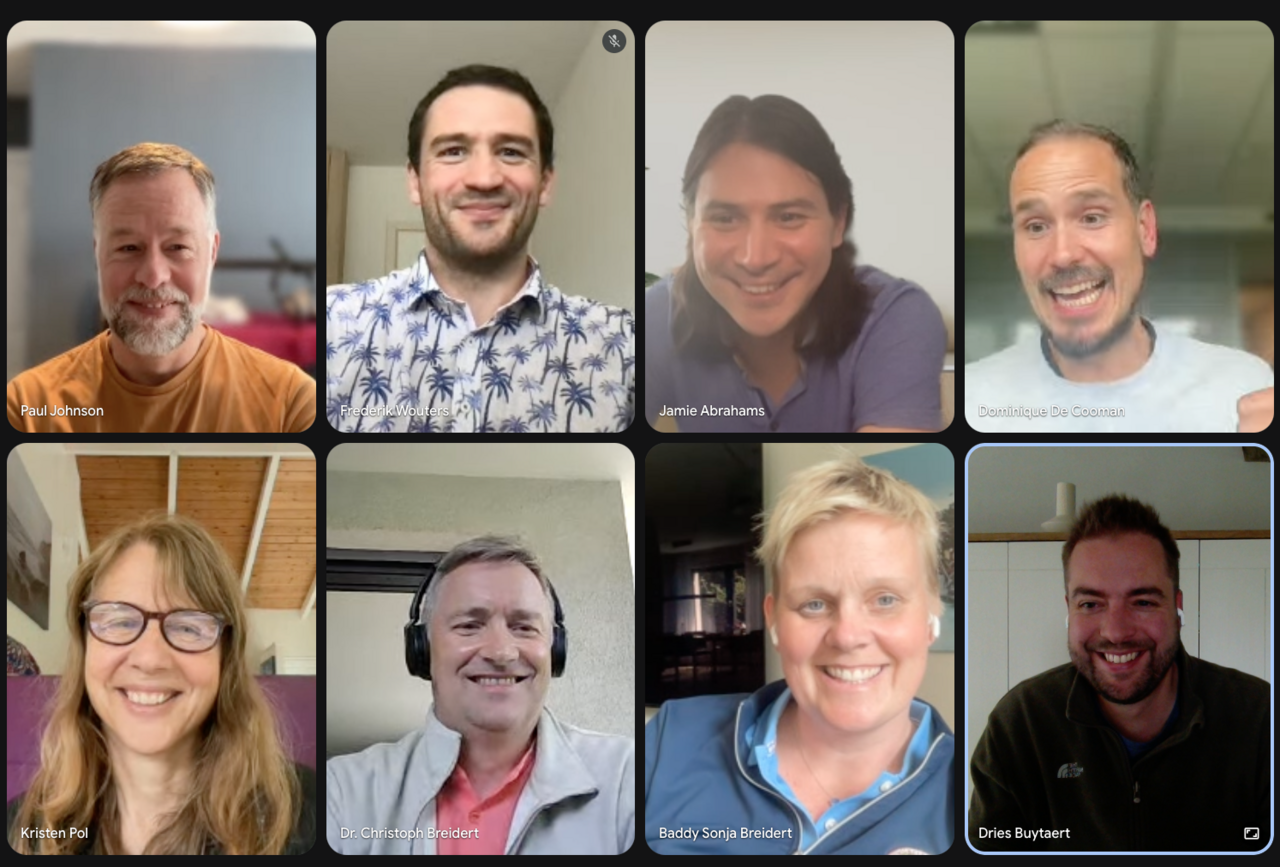 Some of the founding members of the Drupal AI initiative during our launch call on Google Hangouts.
Some of the founding members of the Drupal AI initiative during our launch call on Google Hangouts.
Over the past few months, we've invested hundreds of hours shaping our AI strategy, defining structure, and taking first steps.
I want to thank the founding members of the Drupal AI Initiative. These individuals and organizations played a key role in getting things off the ground. The list is ordered alphabetically by last name to recognize all contributors equally:
- Jamie Abrahams (FreelyGive) – Innovation and AI architecture
- Baddý Breidert (1xINTERNET) – Governance, funding, and coordination
- Christoph Breidert (1xINTERNET) – Product direction and roadmap
- Dries Buytaert (Acquia / Drupal) – Strategic oversight and direction
- Dominique De Cooman (Dropsolid) – Fundraising and business alignment
- Marcus Johansson (FreelyGive) – Technical leadership
- Paul Johnson (1xINTERNET) – Marketing and outreach
- Kristen Pol (Salsa Digital) – Cross-team alignment and contributor engagement
- Lauri Timmanee (Acquia) – Experience Builder AI integration
- Frederik Wouters (Dropsolid) – Communications and outreach
These individuals, along with the companies supporting them, have already contributed significant time, energy, and funding. I am grateful for their early commitment.
I also want to thank the staff at the Drupal Association and the Drupal CMS leadership team for their support and collaboration.
What comes next
I'm glad the Drupal AI Initiative is now underway. The Drupal AI strategy is published, the structure is in place, and multiple work tracks are open and moving forward. We'll share more details and updates in the coming weeks.
With every large initiative, we are evolving how we organize, align, and collaborate. The Drupal AI Initiative builds on that progress. As part of that, we are also exploring more ways to recognize and reward meaningful contributions.
We are creating ways for more of you to get involved with Drupal AI. Whether you are a developer, designer, strategist, or sponsor, there is a place for you in this work. If you're part of an agency, we encourage you to step forward and become a Maker. The more agencies that contribute, the more momentum we build.
Update: In addition to the initiative's founding members, Amazee.io already stepped forward with another commitment of USD $20,000 and one full-time contributor. Thank you! This brings the total operating budget to USD $120,000. Please consider joining as well.
AI is changing how websites and digital experiences are built. This is our moment to be part of the change and help define what comes next.
Join us in the #ai-initiative channel on Drupal Slack to get started.
June 08, 2025

Lookat 2.1.0rc1 is the latest development release of Lookat/Bekijk, a user-friendly Unix file browser/viewer that supports colored man pages.
The focus of the 2.1.0 release is to add ANSI Color support.
News
8 Jun 2025 Lookat 2.1.0rc1 Released
Lookat 2.1.0rc1 is the first release candicate of Lookat 2.1.0
ChangeLog
Lookat / Bekijk 2.1.0rc1
- ANSI Color support
Lookat 2.1.0rc1 is available at:
- https://www.wagemakers.be/english/programs/lookat/
- Download it directly from https://download-mirror.savannah.gnu.org/releases/lookat/
- Or at the Git repository at GNU savannah https://git.savannah.gnu.org/cgit/lookat.git/
Have fun!
June 04, 2025
A few weeks ago, I set off for Balilas, a balfolk festival in Janzé (near Rennes), Brittany (France). I had never been before, but as long as you have dance shoes, a tent, and good company, what more do you need?
 Bananas for scale
Bananas for scale
From Ghent to Brittany… with Two Dutch Strangers
My journey began in Ghent, where I was picked up by Sterre and Michelle, two dancers from the Netherlands. I did not know them too well beforehand, but in the balfolk world, that is hardly unusual — de balfolkcommunity is één grote familie — one big family.
We took turns driving, chatting, laughing, and singing along. Google Maps logged our total drive time at 7 hours and 39 minutes.
 Google knows everything
Google knows everything
 Péage – one of the many
Péage – one of the many
Along the way, we had the perfect soundtrack: French Road Trip
French Road Trip 
 — 7 hours and 49 minutes of French and Francophone tubes.
— 7 hours and 49 minutes of French and Francophone tubes.
 https://open.spotify.com/playlist/3jRMHCl6qVmVIqXrASAAmZ?si=746a7f78ca30488a
https://open.spotify.com/playlist/3jRMHCl6qVmVIqXrASAAmZ?si=746a7f78ca30488a
 A Tasty Stop in Pré-en-Pail-Saint-Samson
A Tasty Stop in Pré-en-Pail-Saint-Samson
Somewhere around dinner time, we stopped at La Sosta, a cozy Italian restaurant in Pré-en-Pail-Saint-Samson (2300 inhabitants). I had a pizza normande — base tomate, andouille, pomme, mozzarella, crème, persil . A delicious and unexpected regional twist — definitely worth remembering!
 pizza normande
pizza normande
The pizzas wereexcellent, but also generously sized — too big to finish in one sitting. Heureusement, ils nous ont proposé d’emballer le reste à emporter. That was a nice touch — and much appreciated after a long day on the road.
 Just to much to eat it all
Just to much to eat it all
 Arrival Just Before Dark
Arrival Just Before Dark
We arrived at the Balilas festival site five minutes after sunset, with just enough light left to set up our tents before nightfall. Trugarez d’an heol — thank you, sun, for holding out a little longer.
There were two other cars filled with people coming from the Netherlands, but they had booked a B&B. We chose to camp on-site to soak in the full festival atmosphere.
 Enjoy the view!
Enjoy the view!
 Banana pancakes!
Banana pancakes!
Balilas itself was magical: days and nights filled with live music, joyful dancing, friendly faces, and the kind of warm atmosphere that defines balfolk festivals.
 Photo: Poppy Lens
Photo: Poppy Lens
More info and photos: balilas.lesviesdansent.bzh
balilas.lesviesdansent.bzh @balilas.balfolk on Instagram
@balilas.balfolk on Instagram
Balfolk is more than just dancing. It is about trust, openness, and sharing small adventures with people you barely know—who somehow feel like old friends by the end of the journey.
Tot de volgende — à la prochaine — betek ar blez a zeu!

Thank you Maï for proofreading the Breton expressions. 
May 28, 2025
In the world of DevOps and continuous integration, automation is essential. One fascinating way to visualize the evolution of a codebase is with Gource, a tool that creates animated tree diagrams of project histories.
Recently, I implemented a GitHub Actions workflow in my ansible-servers repository to automatically generate and deploy Gource visualizations. In this post, I will walk you through how the workflow is set up and what it does.
But first, let us take a quick look back…
 Back in 2013: Visualizing Repos with Bash and XVFB
Back in 2013: Visualizing Repos with Bash and XVFB
More than a decade ago, I published a blog post about Gource (in Dutch) where I described a manual workflow using Bash scripts. At that time, I ran Gource headlessly using xvfb-run, piped its output through pv, and passed it to ffmpeg to create a video.
It looked something like this:
#!/bin/bash -ex
xvfb-run -a -s "-screen 0 1280x720x24" \
gource \
--seconds-per-day 1 \
--auto-skip-seconds 1 \
--file-idle-time 0 \
--max-file-lag 1 \
--key -1280x720 \
-r 30 \
-o - \
| pv -cW \
| ffmpeg \
-loglevel warning \
-y \
-b:v 3000K \
-r 30 \
-f image2pipe \
-vcodec ppm \
-i - \
-vcodec libx264 \
-preset ultrafast \
-pix_fmt yuv420p \
-crf 1 \
-threads 0 \
-bf 0 \
../gource.mp4
This setup worked well for its time and could even be automated via cron or a Git hook. However, it required a graphical environment workaround and quite a bit of shell-fu.
 From Shell Scripts to GitHub Actions
From Shell Scripts to GitHub Actions
Fast forward to today, and things are much more elegant. The modern Gource workflow lives in .github/workflows/gource.yml and is:
 Reusable through
Reusable through workflow_call Manually triggerable via
Manually triggerable via workflow_dispatch Integrated into a larger CI/CD pipeline (
Integrated into a larger CI/CD pipeline (pipeline.yml) Cloud-native, with video output stored on S3
Cloud-native, with video output stored on S3
Instead of bash scripts and virtual framebuffers, I now use a well-structured GitHub Actions workflow with clear job separation, artifact management, and summary reporting.
 What the New Workflow Does
What the New Workflow Does
The GitHub Actions workflow handles everything automatically:
 Decides if a new Gource video should be generated, based on time since the last successful run.
Decides if a new Gource video should be generated, based on time since the last successful run. Generates a Gource animation and a looping thumbnail GIF.
Generates a Gource animation and a looping thumbnail GIF. Uploads the files to an AWS S3 bucket.
Uploads the files to an AWS S3 bucket. Posts a clean summary with links, preview, and commit info.
Posts a clean summary with links, preview, and commit info.
It supports two triggers:
workflow_dispatch(manual run from the GitHub UI)workflow_call(invoked from other workflows likepipeline.yml)
You can specify how frequently it should run with the skip_interval_hours input (default is every 24 hours).
 Smart Checks Before Running
Smart Checks Before Running
To avoid unnecessary work, the workflow first checks:
- If the workflow file itself was changed.
- When the last successful run occurred.
- Whether the defined interval has passed.
Only if those conditions are met does it proceed to the generation step.
 Building the Visualization
Building the Visualization
 Step-by-step:
Step-by-step:
- Checkout the Repo
Usesactions/checkoutwithfetch-depth: 0to ensure full commit history. - Generate Gource Video
Usesnbprojekt/gource-actionwith configuration for avatars, title, and resolution. - Install FFmpeg
UsesAnimMouse/setup-ffmpegto enable video and image processing. - Create a Thumbnail
Extracts preview frames and assembles a looping GIF for visual summaries. - Upload Artifacts
Usesactions/upload-artifactto store files for downstream use.
 Uploading to AWS S3
Uploading to AWS S3
In a second job:
- AWS credentials are securely configured via
aws-actions/configure-aws-credentials. - Files are uploaded using a commit-specific path.
- Symlinks (
gource-latest.mp4,gource-latest.gif) are updated to always point to the latest version.
 A Clean Summary for Humans
A Clean Summary for Humans
At the end, a GitHub Actions summary is generated, which includes:
- A thumbnail preview
- A direct link to the full video
- Video file size
- Commit metadata
This gives collaborators a quick overview, right in the Actions tab.
 Why This Matters
Why This Matters
Compared to the 2013 setup:
| 2013 Bash Script | 2025 GitHub Actions Workflow |
|---|---|
| Manual setup via shell | Fully automated in CI/CD |
| Local only | Cloud-native with AWS S3 |
| Xvfb workaround required | Headless and clean execution |
| Script needs maintenance | Modular, reusable, and versioned |
| No summaries | Markdown summary with links and preview |
Automation has come a long way — and this workflow is a testament to that progress.
 Final Thoughts
Final Thoughts
This Gource workflow is now a seamless part of my GitHub pipeline. It generates beautiful animations, hosts them reliably, and presents the results with minimal fuss. Whether triggered manually or automatically from a central workflow, it helps tell the story of a repository in a way that is both informative and visually engaging. 

Would you like help setting this up in your own project? Let me know — I am happy to share.
May 27, 2025
Four months ago, I tested 10 local vision LLMs and compared them against the top cloud models. Vision models can analyze images and describe their content, making them useful for alt-text generation.
The result? The local models missed important details or introduced hallucinations. So I switched to using cloud models, which produced better results but meant sacrificing privacy and offline capability.
Two weeks ago, Ollama released version 0.7.0 with improved support for vision models. They added support for three vision models I hadn't tested yet: Mistral 3.1, Qwen 2.5 VL and Gemma 3.
I decided to evaluate these models to see whether they've caught up to GPT-4 and Claude 3.5 in quality. Can local models now generate accurate and reliable alt-text?
| Model | Provider | Release date | Model size |
|---|---|---|---|
| Gemma 3 (27B) | Google DeepMind | March 2025 | 27B |
| Qwen 2.5 VL (32B) | Alibaba | March 2025 | 32B |
| Mistral 3.1 (24B) | Mistral AI | March 2025 | 24B |
Updating my alt-text script
For my earlier experiments, I created an open-source script that generates alt-text descriptions. The script is a Python wrapper around Simon Willison's llm tool, which provides a unified interface to LLMs. It supports models from Ollama, Hugging Face and various cloud providers.
To test the new models, I added 3 new entries to my script's models.yaml, which defines each model's prompt, temperature, and token settings. Once configured, generating alt-text is simple. Here is an example using the three new vision models:
$ ./caption.py test-images/image-1.jpg –model mistral-3.1-24b gemma3-27b qwen2.5vl-32bWhich outputs something like:
{
"image": "test-images/image-1.jpg",
"captions": {
"mistral-3.1-24b": "A bustling intersection at night filled with pedestrians crossing in all directions."
"gemma3-27b": "A high-angle view shows a crowded Tokyo street filled with pedestrians and brightly lit advertising billboards at night.",
"qwen2.5vl-32b": "A bustling city intersection at night, crowded with people crossing the street, surrounded by tall buildings with bright, colorful billboards and advertisements.",
}
}Evaluating the models
To keep the results consistent, I used the same test images and the same evaluation method as in my earlier blog post. The details results are in this Google spreadsheet.
Each alt-text was scored from 0 to 5 based on three criteria: how well it identified the most important elements in the image, how effectively it captured the mood or atmosphere, and whether it avoided repetition, grammar issues or hallucinated details. I then converted each score into a letter grade from A to F.
For comparison, the cloud models received the following scores: GPT-4o earned an average of 4.8 out of 5 (grade A), and Claude 3.5 Sonnet received a perfect 5 out of 5 (grade A).
Test image 1: Shibuya Crossing, Tokyo

| Model | Description | Grade |
|---|---|---|
| Mistral 3.1 (24B) | A bustling intersection at night filled with pedestrians crossing in all directions. | C |
| Gemma 3 (27B) | A high-angle view shows a crowded Tokyo street filled with pedestrians and brightly lit advertising billboards. | B |
| Qwen 2.5 VL (32B) | A bustling city intersection at night, crowded with people crossing the street, surrounded by brightly lit billboards and tall buildings. | B |
None earned an A because they failed to identify this as Shibuya Crossing in Tokyo, while cloud models do. Mistral also missed the billboards.
Test image 2: Isabella Stewart Gardner Museum, Boston

| Model | Description | Grade |
|---|---|---|
| Mistral 3.1 (24B) | An ornate wall features a large empty picture frame. | B |
| Gemma 3 (27B) | An empty, ornate gold frame hangs on a patterned green wall between two framed portraits and a candle sconce. | A |
| Qwen 2.5 VL (32B) | A vintage-style room features ornate wallpaper, a framed empty canvas, a lit candelabra, and a decorative vase on a table, with portraits on either side. | A |
The vision models in my previous post often mistook the empty frame for a framed painting. All three models in this test correctly identified it as empty. Gemma and Qwen captured valuable details about the scene, while Mistral's description felt sparse.
Test image 3: wakeboarding in Vermont, USA

| Model | Description | Grade |
|---|---|---|
| Mistral 3.1 (24B) | Two shirtless men on a boat watch another person water skiing on a lake. | B |
| Gemma 3 (27B) | Two people on a boat watch a waterskier speeding across the lake on a sunny day. | B |
| Qwen 2.5 VL (32B) | Two shirtless men on a boat watch a person water skiing in the distance on a calm lake. | B |
All three described a wakeboarding scene as "water skiing", while the cloud models correctly identified it as wakeboarding.
Test image 4: hiking in the Dolomites, Italy

| Model | Description | Grade |
|---|---|---|
| Mistral 3.1 (24B) | A wooden statue of a saint is mounted on a post with directional signs pointing to various locations. | C |
| Gemma 3 (27B) | A small wooden shrine with a statue of Mary stands beside a signpost indicating hiking trails in a grassy field. | B |
| Qwen 2.5 VL (32B) | A wooden shrine with a statue of a figure stands on a tree stump, surrounded by a scenic mountain landscape with directional signs in the foreground. | B |
Only Gemma recognized the statue as Mary. Both Mistral and Gemma missed the mountains in the background, which seems important.
Test image 5: backgammon by candlelight

| Model | Description | Grade |
|---|---|---|
| Mistral 3.1 (24B) | A lit candle and a glass of liquid are on a wooden table next to a wooden board game. | B |
| Gemma 3 (27B) | A lit candle and glass votive sit on a wooden table, creating a warm, inviting glow in a dimly lit space. | B |
| Qwen 2.5 VL (32B) | A cozy scene with a lit candle on a wooden table, next to a backgammon board and a glass of liquid, creating a warm and inviting atmosphere. | A |
Neither Mistral nor Gemma recognized the backgammon board. Only Qwen identified it correctly. Mistral also failed to capture the photo's mood.
Model accuracy
| Model | Repetitions | Hallucinations | Moods | Average score | Grade |
|---|---|---|---|---|---|
| Mistral 3.1 (24B) | Never | Never | Fair | 3.4/5 | C |
| Gemma 3 (27B) | Never | Never | Good | 4.2/5 | B |
| Qwen 2.5 VL (32B) | Never | Never | Good | 4.4/5 | B |
Qwen 2.5 VL performed best overall, with Gemma 3 not far behind.
Needless to say, these results are based on a small set of test images. And while I used a structured scoring system, the evaluation still involves subjective judgment. This is not a definitive ranking, but it's enough to draw some conclusions.
It was nice to say that all three LLMs avoided repetition and hallucinations, and generally captured the mood of the images.
Local models still make mistakes. All three described wakeboarding as "water skiing", most failed to recognize the statue as Mary or place the intersection in Japan. Cloud models get these details right, as I showed in my previous blog post.
Conclusion
I ran my original experiment four months ago, and at the time, none of the models I tested felt accurate enough for large-scale alt-text generation. Some, like Llama 3, showed promise but still fell short in overall quality.
Newer models like Qwen 2.5 VL and Gemma 3 have matched the performance I saw earlier with Llama 3. Both performed well in my latest test. They produced relevant, grounded descriptions without hallucinations or repetition, which earlier local models often struggled with.
Still, the quality is not yet at the level where I would trust these models to generate thousands of alt-texts without human review. They make more mistakes than GPT-4 or Claude 3.5.
My main question was: are local models now good enough for practical use? While Qwen 2.5 VL performed best overall, it still needs human review. I've started using it for small batches where manual checking is manageable. For large-scale, fully automated use, I continue using cloud models as they remain the most reliable option.
That said, local vision-language models continue to improve. My long-term goal is to return to a 100% local-first workflow that gives me more control and keeps my data private. While we're not there yet, these results show real progress.
My plan is to wait for the next generation of local vision models (or upgrade my hardware to run larger models). When those become available, I'll test them and report back.
May 23, 2025

Reducing the digital clutter of chats
I hate modern chats. They presuppose we are always online, always available to chat. They force us to see and think about them each time we get our eyes on one of our devices. Unlike mailboxes, they are never empty. We can’t even easily search through old messages (unlike the chat providers themselves, which use the logs to learn more about us). Chats are the epitome of the business idiot: they make you always busy but prevent you from thinking and achieving anything.
It is quite astonishing to realise that modern chat systems use 100 or 1000 times more resources (in size and computing power) than 30 years ago, that they are less convenient (no custom client, no search) and that they work against us (centralisation, surveillance, ads). But, yay, custom emojis!
Do not get me wrong: chats are useful! When you need an immediate interaction or a quick on-the-go message, chats are the best.
I needed to keep being able to chat while keeping the digital clutter to a minimal and preserving my own sanity. That’s how I came up with the following rules.
Rule 1: One chat to rule them all
One of the biggest problems of centralised chats is that you must be on many of them. I decided to make Signal my main chat and to remove others.
Signal was, for me, a good compromise of respecting my privacy, being open source and without ads while still having enough traction that I could convince others to join it.
Yes, Signal is centralised and has drawbacks like relying on some Google layers (which I worked around by using Molly-FOSS). I simply do not see XMPP, Matrix or SimpleX becoming popular enough in the short term. Wire and Threema had no advantages over Signal. I could not morally justify using Whatsapp nor Telegram.
In 2022, as I decided to use Signal as my main chat, I deleted all accounts but Signal and Whatsapp and disabled every notification from Whatsapp, forcing myself to open it once a week to see if I had missed something important. People who really wanted to reach me quickly understood that it was better to use Signal. This worked so well that I forgot to open Whatsapp for a whole month which was enough for Whatsapp to decide that my account was not active anymore.
Not having Whatsapp is probably the best thing which happened to me regarding chats. Suddenly, I was out of tenths or hundreds of group chats. Yes, I missed lots of stuff. But, most importantly, I stopping fearing missing them. Seriously, I never missed having Whatsapp. Not once. Thanks Meta for removing my account!
While travelling in Europe, it is now standard that taxi and hotels will chat with you using Whatsapp. Not anymore for me. Guess what? It works just fine. In fact, I suspect it works even better because people are forced to either do what we agreed during our call or to call me, which requires more energy and planning.
Rule 2: Mute, mute, mute!
Now that Signal is becoming more popular, some group chats are migrating to it. But I’ve learned the lesson : I’m muting them. This allows me to only see the messages when I really want to look at them. Don’t hesitate to mute vocal group chats and people with whom you don’t need day-to-day interaction.
I’m also leaving group chats which are not essential. Whatsapp deletion told me that nearly no group chat is truly essential.
Many times, I’ve had people sending me emails about what was told on a group chat because they knew I was not there. Had I been on that group, I would probably have missed the messages but nobody would have cared. If you really want to get in touch with me, send me an email!
Rule 3: No read receipts nor typing indicators
I was busy, walking in the street with my phone in hands for directions. A notification popped up with an important message. It was important but not urgent. I could not deal with the message at that moment. I wanted to take the time. One part of my brain told me not to open the message because, if I did, the sender would see a "read receipt". He would see that I had read the message but would not receive any answer.
For him, that would probably translate in "he doesn’t care". I consciously avoided to open Signal until I was back home and could deal with the message.
That’s when I realised how invasive the "read receipt" was. I disabled it and never regretted that move. I’m reading messages on my own watch and replying when I want to. Nobody needs to know if I’ve seen the message. It is wrong in every aspect.
 Signal preferences showing read receipts and typing indicator disabled
Signal preferences showing read receipts and typing indicator disabled
Rule 4: Temporary discussions only
The artist Bruno Leyval, who did the awesome cover of my novel Bikepunk, is obsessed with deletion and disappearance. He set our Signal chat so that every message is deleted after a day. At first, I didn’t see the point.
Until I understood that this was not only about privacy, it also was about decluttering our mind, our memories.
Since then, I’ve set every chat in Signal to delete messages after one week.
 Signal preferences showing disappearing messages set to one week
Signal preferences showing disappearing messages set to one week
This might seem like nothing but this changes everything. Suddenly, chats are not a long history of clutter. Suddenly, you see chats as transient and save things you want to keep. Remember that you can’t search in chats? This means that chats are transient anyway. With most chats, your history is not saved and could be lost by simply dropping your phone on the floor. Something important should be kept in a chat? Save it! But it should probably have been an email.
Embracing the transient nature of chat, making it explicit greatly reduce the clutter.
Conclusion
I know that most of you will say that "That’s nice Ploum but I can’t do that because everybody is on XXX" where XXX is most often Whatsapp in my own circles. But this is wrong: you believe everybody is on XXX because you are yourself using XXX as your main chat. When surveying my students this year, I’ve discovered that nearly half of them was not on Whatsapp. Not for some hard reason but because they never saw the need for it. In fact, they were all spread over Messenger, Instagram, Snap, Whatsapp, Telegram, Discord. And they all believed that "everybody is where I am".
In the end, the only real choice to make is between being able to get immediately in touch with a lot of people or having room for your mental space. I choose the latter, you might prefer the former. That’s fine!
I still don’t like chat. I’m well aware that the centralised nature of Signal makes it a short-term solution. But I’m not looking for the best sustainable chat. I just want fewer chats in my life.
If you want to get in touch, send me an email!
I’m Ploum, a writer and an engineer. I like to explore how technology impacts society. You can subscribe by email or by rss. I value privacy and never share your adress.
I write science-fiction novels in French. For Bikepunk, my new post-apocalyptic-cyclist book, my publisher is looking for contacts in other countries to distribute it in languages other than French. If you can help, contact me!
May 21, 2025

This spring was filled with music, learning, and connection. I had the opportunity to participate in three wonderful music courses, each offering something unique—new styles, deeper technique, and a strong sense of community. Here is a look back at these inspiring experiences.
 1. Fiddlers on the Move – Ghent (5–9 March)
1. Fiddlers on the Move – Ghent (5–9 March)
 Photo: Filip Verpoest
Photo: Filip Verpoest
In early March, I joined Fiddlers on the Move in Ghent, a five-day course packed with workshops led by musicians from all over the world. Although I play the nyckelharpa, I deliberately chose workshops that were not nyckelharpa-specific. This gave me the challenge and joy of translating techniques from other string traditions to my instrument.
Here is a glimpse of the week:
- Wednesday: Fiddle singing with Laura Cortese – singing while playing was new for me, and surprisingly fun.
- Thursday: Klezmer violin / Fiddlers down the roof with Amit Weisberger – beautiful melodies and ornamentation with plenty of character.
- Friday: Arabic music with Layth Sidiq – an introduction to maqams and rhythmic patterns that stretched my ears in the best way.
- Saturday: Swedish violin jamsession classics with Mia Marine – a familiar style, but always a joy with Mia’s energy and musicality.
- Sunday: Live looping strings with Joris Vanvinckenroye – playful creativity with loops, layering, and rhythm.
Each day brought something different, and I came home with a head full of ideas and melodies to explore further.
 2. Workshopweekend Stichting Draailier & Doedelzak – Sint-Michielsgestel, NL (18–21 April)
2. Workshopweekend Stichting Draailier & Doedelzak – Sint-Michielsgestel, NL (18–21 April)
 Photo: Arne de Laat
Photo: Arne de Laat
In mid-April, I traveled to Sint-Michielsgestel in the Netherlands for the annual Workshopweekend organized by Stichting Draailier & Doedelzak. This year marked the foundation’s 40th anniversary, and the event was extended to four days, from Friday evening to Monday afternoon, at the beautiful location of De Zonnewende.
I joined the nyckelharpa workshop with Rasmus Brinck. One of the central themes we explored was the connection between playing and dancing polska—a topic close to my heart. I consider myself a dancer first and a musician second, so it was especially meaningful to deepen the musical understanding of how movement and melody shape one another.
The weekend offered a rich variety of other workshops as well, including hurdy-gurdy, bagpipes, diatonic accordion, singing, and ensemble playing. As always, the atmosphere was warm and welcoming. With structured workshops during the day and informal jam sessions, concerts, and bals in the evenings, it was a perfect blend of learning and celebration.
 3. Swedish Music for Strings – Ronse (2–4 May)
3. Swedish Music for Strings – Ronse (2–4 May)
At the beginning of May, I took part in a three-day course in Ronse dedicated to Swedish string music. Although we could arrive on 1 May, teaching started the next day. The course was led by David Eriksson and organized by Amate Galli. About 20 musicians participated—two violinists, one cellist, and the rest of us on nyckelharpa.
The focus was on capturing the subtle groove and phrasing that make Swedish folk music so distinctive. It was a joy to be surrounded by such a rich soundscape and to play in harmony with others who share the same passion. The music stayed with me long after the course ended.
 Final Thoughts
Final Thoughts
Each of these courses gave me something different: new musical perspectives, renewed technical focus, and most importantly, the joy of making music with others. I am deeply grateful to all the teachers, organizers, and fellow participants who made these experiences so rewarding. I am already looking forward to the next musical adventure!
May 19, 2025

We landed late in Portland, slept off the jet lag, and had breakfast at a small coffee shop. The owner of the coffee shop challenged me to a game of chess. Any other day, I would have accepted. But after a year of waiting, not even Magnus Carlsen himself could delay us from meeting our van.
After more than a year of planning, designing, shipping gear, and running through every what-if, we were finally in Portland to pick up our new van. It felt surreal to be handed the keys after all that waiting.
The plan: a one-week "shakedown trip", testing our new van while exploring Oregon. We'd stay close to the builder for backup, yet sleep by the ocean, explore vineyards and hike desert trails.
Day 1–2: ocean air in Pacific City
After picking up the van and completing our onboarding, we drove just two hours west to Pacific City on the Oregon coast. I was nervous at first since I'd never driven anything this big, but it felt manageable within minutes.
For the first two nights, we stayed at Hart's Camp, also known as Cape Kiwanda RV Park. The campground had full hookups, a small grocery store, and a brewery just across the road. While the RV park felt more like a parking lot than a forest, it was exactly what we needed. Something easy and practical. A soft landing.
 Camping in Pacific City, a small surfer town on the Oregon coast. The main landmark is Haystack Rock, also known as Chief Kiawanda. It looks like a gorilla's head with a rat tail. Once you see it, you can't unsee it.
Camping in Pacific City, a small surfer town on the Oregon coast. The main landmark is Haystack Rock, also known as Chief Kiawanda. It looks like a gorilla's head with a rat tail. Once you see it, you can't unsee it.
That night, we cracked the windows and slept with the ocean air drifting in. People always ask how someone six foot four (or almost 2 meters) manages to sleep in a van. The truth? I slept better than I do in most hotel beds.
We spent most of the next day settling in. We organized, unpacked the gear we had shipped ahead, figured out what all the switches did, cleaned the dishes, and debated what to put in which cabinets.
Day 3–4: Wine tasting in Willamette Valley
From the coast, we headed inland into Oregon wine country. The drive to Champoeg State Park took about an hour and a half, winding through farmland and small towns.
Champoeg is a beautifully laid-out campground, quiet and easy to navigate, with wide sites and excellent showers. The surrounding area is a patchwork of vineyards, barns and backroads.
We visited several vineyards in the Willamette Valley. The Four Graces was our favorite. Their 2021 Windborn Pinot Noir stood out, and the inn next door looked tempting for a future non-camping trip. We also visited Ken Wright, Lemelson, and Dominio IV. We ended up buying 15 bottles of wine. One of the perks of van life: your wine cellar travels with you.
That evening, Vanessa cooked salmon in red curry, outside in the rain, over a wood fire. We ate inside the van, warm and dry, with music playing. We opened a 2023 Still Life Viognier from Dominio IV that we had liked so much during the tasting. There was something magical about being cozy in a small space while rain drums overhead.
 Laundry day in a small town in Oregon. We're camping in a van and stopped to wash some of our clothes. Life on the road!
Laundry day in a small town in Oregon. We're camping in a van and stopped to wash some of our clothes. Life on the road!
The next morning, we drove to McMinnville to do laundry. Laundry isn't exactly a bucket-list item for me, but Vanessa found it oddly satisfying. There was a coffee kiosk nearby, so we walked through the drive-thru on foot, standing between cars to order lattes while our clothes spun.
Day 5: Smith Rock and steep trails
 Arrived at Skull Hollow Campground. No power or water, but it's quiet and the sky is full of stars. It feels like we're exactly where we need to be.
Arrived at Skull Hollow Campground. No power or water, but it's quiet and the sky is full of stars. It feels like we're exactly where we need to be.
We left wine country behind and headed into Central Oregon, crossing over the mountains on a three-hour drive that was scenic the entire way. Pine forests, wide rivers and lakes came and went as we climbed and descended. We passed through small towns and stretches of open road that felt far from anywhere.
I kept wanting to stop to take photos, but didn't want to interrupt the rhythm of the road. Instead, we made mental notes about places to come back to someday.
That night we stayed at Skull Hollow Campground, a basic campground without hookups. Our first real test of off-grid capability. This was deliberate. We wanted to know how our solar panels and batteries would handle a full night of heating, and whether our water supply would last without refilling.
It was cold, down to 37°F, but the van handled it well. We kept the heat at 60°F and slept soundly under a heavy duvet. When we woke up, the solar panels were already soaking up sunlight.
 We hiked the Misery Ridge and River Trail in Smith Rock State Park. The steep switchbacks and rocky terrain made it a tough climb, but the panoramic views were worth it.
We hiked the Misery Ridge and River Trail in Smith Rock State Park. The steep switchbacks and rocky terrain made it a tough climb, but the panoramic views were worth it.
Smith Rock State Park was just fifteen minutes away. Vanessa wanted to drive the van somewhere more rural, and this was the perfect chance. She handled the van like a boss.
Day 6: Bend and our first HipCamp
We continued to Bend, just forty minutes from Skull Hollow. Bend is a small city in Central Oregon known for its outdoor lifestyle. We resupplied, filled our water tank and stopped by REI (think "camping supermarket").
We had dinner at Wild Rose, a Northern Thai restaurant that had been nominated for a James Beard award. The food was excellent. The service was not.
That night we stayed at our first HipCamp, a campsite on a working ranch with cattle just outside of Bend. A lone bull stood at the entrance, watching us with mild interest. We followed the long gravel driveway past grazing cows, getting our first real taste of ranch life.
 Our van's neighbor for the night was a beautifully rusted Ford. Retired but still stealing the spotlight.
Our van's neighbor for the night was a beautifully rusted Ford. Retired but still stealing the spotlight.
 I can't help but wonder what stories this truck could tell.
I can't help but wonder what stories this truck could tell.
The setup was simple: a grassy parking area, a 30-amp electrical outlet, a metal trash bin and a water pump with well water. We shared the space with an old Ford that had clearly been there longer than we planned to be. A pair of baby owls watched us from a tree. It was peaceful, with wide views and almost total quiet. Nothing fancy, but memorable.
Day 7: Camp Sherman and quiet rivers
 Parked at Camp Sherman Campground, next to the Metolius River in Oregon, USA.
Parked at Camp Sherman Campground, next to the Metolius River in Oregon, USA.
On our final full day, we drove about an hour and twenty minutes to Camp Sherman Campground, nestled along the Metolius River. The Metolius is a spring-fed river known for its crystal-clear waters and world-class fly fishing.
The campground is "first-come, first-serve", and we were lucky to find a site right by the water. This was our first time using an "Iron Ranger", the self-pay envelope system used in many public campgrounds. A refreshing throwback to simpler times.
We hiked a trail along the river, upstream through forests that had clearly burned in recent years. Signs along the path explained it was a prescribed burn area, which gave the charred trunks and new growth a different kind of meaning.
We watched a family of deer move through the trees at dusk very close to our van. They seemed as curious about us as we were about them.
Later that evening, we cooked, read, and talked. We sat by the fire, wrapped in the camping blankets we had picked up at REI. It was quiet in the way we needed it to be.
The next morning, it was time to move on. I had to get to Chicago for a Drupal Camp, even though neither of us felt ready to leave.
530 miles, one van and zero regrets
This loop, starting in Portland, heading to the coast, through wine country, over the mountains, and back again, turned out to be the perfect test run. Each stop offered something different, from ocean breezes to vineyard views to rugged high desert hikes. The drives were short enough to stay relaxed, ranging from 40 minutes to three hours. In total, we covered about 530 miles.
By the end of the trip, we had gone from full hookups to fully self-sufficient, using solar power and our onboard water supply. The van passed every test we threw at it. Now we knew we could take it anywhere.
May 17, 2025
It's been a while since I wrote about one of my favorite songs, but Counting Crows' "Round Here" is one that has always stuck with me.
I've listened to this song hundreds of times, and this non-standard version, where Adam Duritz stretches the lyrics and lets his emotions flow, hits even harder.
To me, it feels like a quiet cry about mental health. About someone feeling disconnected, uncertain of who they are, and not at home in their own life. There is something raw, honest, and deeply human in the way the song captures that struggle.
The song has only grown on me over time. I didn't fully understand or appreciate it in my twenties, but now that I'm in my forties, I've come to see more people around me carrying quiet struggles. If that is you, I hope you're taking care of yourself.
May 16, 2025

Petit manifeste low-tech
Ce samedi 17 mai, je pédalerai vers Massy en compagnie de Tristan Nitot pour parler "low-tech" et dédicacer Bikepunk lors du festival Parlons Vélo.
Attention, ce qui va suivre divulgâche une partie de ce que je dirai samedi midi à Massy. Si vous venez, arrêtez de lire ici, on se retrouve demain !
Qu’est-ce que la low-tech ?
Le terme low-tech nous fait intuitivement sentir une opposition contre l’excès technologique (le "high tech") tout en évitant l’extrémisme technophobique. Un terme qui enthousiasme, mais qu’il me semble important d’expliciter et dont je propose la définition suivante.
Une technologie est dite « low-tech » si les personnes interagissant avec cette technologie savent et peuvent en comprendre son fonctionnement.
Savoir comprendre. Pouvoir comprendre. Deux éléments essentiels (et difficiles à distinguer pour le Belge que je suis).
Savoir comprendre
Savoir comprendre une technologie implique d’avoir la possibilité de construire un modèle intellectuel de son fonctionnement interne.
Il est bien évident que tout le monde n’a pas la capacité de comprendre toutes les technologies. Mais il est possible de procéder par niveau. La majorité des automobilistes sait qu’une voiture à essence brûle le carburant qui explose dans un moteur, explosion qui entraine des pistons qui font tourner les roues. Le nom est un indice en soi : un moteur à explosion !
Si je n’en comprends pas plus sur le fonctionnement d’un moteur, j’ai la certitude qu’il existe des personnes qui comprennent mieux, souvent dans mon entourage direct. Au plus la compréhension est fine, au plus les personnes deviennent rares, mais chacun peut tenter de s’améliorer.
La technologie est simple sans être simpliste. Cela signifie que sa complexité peut être appréhendée graduellement. Et qu’il existe des experts qui appréhendent une technologie particulière dans sa globalité.
Par opposition, il est aujourd’hui humainement impossible de comprendre un smartphone moderne. Seuls quelques expert·e·s dans le monde maitrisent chacun·e un point particulier de l’objet : du dessin de l’antenne 5G au logiciel retouchant automatiquement les photos en passant par le chargement rapide de la batterie. Et aucun d’entre eux ne maitrise la conception d’un compilateur nécessaire à faire tourner le tout. Même un génie passant sa vie à démonter des smartphones serait dans l’incapacité totale de comprendre ce qui se passe à l’intérieur d’un engin que nous avons tous en permanence soit dans une poche, soit devant notre nez !
L’immense majorité des utilisateurs de smartphones n’ont pas le moindre modèle mental de son fonctionnement. Je ne parle pas d’un modèle erroné ou simpliste : non, il n’y en a pas du tout. L’objet est « magique ». Pourquoi affiche-t-il quelque chose plutôt qu’un autre ? Parce que c’est « magique ». Et comme pour la magie, il ne faut pas chercher à comprendre.
La low-tech peut être extrêmement complexe, mais l’existence même de cette complexité doit être compréhensible et justifiée. Une complexité transparente encourage naturellement les esprits curieux à se poser des questions.
Le temps de comprendre
Comprendre une technologie prend du temps. Cela implique une relation longue, une expérience qui se crée tout au long d’une vie, qui se partage, qui se transmet.
Par opposition, la high-tech impose un renouvellement, une mise à jour constante, des changements d’interface et de fonctionnalité permanents qui renforcent l’aspect « magique » et entraine le découragement de celleux qui tentent de se construire un modèle mental.
La low-tech doit donc nécessairement être durable. Pérenne. Elle doit s’enseigner et permettre une construction progressive de cet enseignement.
Cela implique parfois des efforts, des difficultés. Tout ne peut pas toujours être progressif : à un moment, il faut se lancer sur son vélo pour apprendre à garder l’équilibre.
Pouvoir comprendre
Historiquement, il semble évident que toute technologie a la possibilité d’être comprise. Les personnes interagissant avec la technologie étaient forcées de réparer, d’adapter et donc de comprendre. Une technologie était essentiellement matérielle, ce qui implique qu’elle pouvait être démontée.
Avec le logiciel apparait un nouveau concept : celui de cacher le fonctionnement. Et si, historiquement, tout logiciel est open source, l’invention du logiciel propriétaire rend difficile, voire impossible, de comprendre une technologie.
Le logiciel propriétaire n’a pu être inventé que grâce à la création d’un concept récent, au demeurant absurde, appelé « propriété intellectuelle ».
Cette propriété intellectuelle ayant permis la privatisation de la connaissance dans le logiciel, elle est ensuite étendue au monde matériel. Soudainement, il devient possible d’interdire à une personne de tenter de comprendre la technologie qu’elle utilise au quotidien. Grâce à la propriété intellectuelle, des fermiers se voient soudain interdits d’ouvrir le capot de leur propre tracteur.
La low-tech doit être ouverte. Elle doit pouvoir être réparée, modifiée, améliorée et partagée.
De l’utilisateur au consommateur
Grâce à la complexification, aux changements incessants et à l’imposition d’un régime strict de « propriété intellectuelle », les utilisateurs ont été transformés en consommateurs.
Ce n’est pas un hasard. Ce n’est pas une évolution inéluctable de la nature. Il s’agit d’un choix conscient. Toutes les écoles de commerce enseignent aux futurs entrepreneurs à se construire un marché captif, à priver autant que possible leur client de liberté, à construire ce qu’on appelle dans le jargon une "moat" (douve qui protège un château) afin d’augmenter la « rétention des utilisateurs ».
Les termes eux-mêmes deviennent flous pour renforcer ce sentiment de magie. On ne parle par exemple plus de transférer un fichier .jpg vers un ordinateur distant, mais de « sauvegarder ses souvenirs dans le cloud ».
Les marketeux nous ont fait croire qu’en supprimant les mots compliqués, ils simplifieraient la technologie. C’est évidemment le contraire. L’apparence de simplicité est une complexité supplémentaire qui emprisonne l’utilisateur. Toute technologie nécessite un apprentissage. Cet apprentissage doit être encouragé.
Pour une approche et une éthique low-tech
L’éthique low-tech consiste à se remettre au service de l’utilisateur en lui facilitant la compréhension de ses outils.
La high-tech n’est pas de la magie, c’est de la prestidigitation. Plutôt que de cacher les « trucs » sous des artifices, la low-tech cherche à montrer et à créer une utilisation en conscience de la technologie.
Cela n’implique pas nécessairement une simplification à outrance.
Prenons l’exemple d’une machine à laver le linge. Nous comprenons tous qu’une machine de base est un tambour qui tourne dans lequel est injecté de l’eau et du savon. C’est très simple et low-tech.
On pourrait arguer que l’ajout de capteurs et de contrôleurs électroniques permet de laver le linge plus efficacement et plus écologiquement en le pesant et adaptant la vitesse de rotation en fonction du type de linge.
Dans une optique low-tech, un boitier électronique est ajouté à la machine pour faire exactement cela. Si le boitier est retiré ou tombe en panne, la machine continue à fonctionner simplement. L’utilisateur peut choisir de débrancher le boitier ou de le remplacer. Il en comprend l’utilité et la justification. Il construit un modèle mental dans lequel le boitier ne fait qu’appuyer sur les boutons de réglage au bon moment. Et, surtout, il ne doit pas envoyer toute la machine à la casse parce que la puce wifi ne fonctionne plus et n’est plus mis à jour ce qui a bloqué le firmware (quoi ? Ma machine à laver dispose d’une puce wifi ?).
Pour une communauté low-tech
Une technologie low-tech encourage et donne l’occasion à l’utilisateur à la comprendre, à se l’approprier. Elle tente de rester stable dans le temps, se standardise. Elle ne cherche pas à cacher la complexité intrinsèque partant du principe que la simplicité provient de la transparence.
Cette compréhension, cette appropriation ne peut se faire que dans l’interaction. Une technologie low-tech va donc, par essence, favoriser la création de communautés et les échanges humains autour de cette même technologie.
Pour contribuer à l’humanité et aux communautés, une technologie low-tech se doit d’appartenir à tou·te·s, de faire partie des communs.
J’en arrive donc à cette définition, complémentaire et équivalente à la première :
Une technologie est dite « low-tech » si elle expose sa complexité de manière simple, ouverte, transparente et durable tout en appartenant aux communs.
Je suis Ploum et je viens de publier Bikepunk, une fable écolo-cycliste entièrement tapée sur une machine à écrire mécanique. Pour me soutenir, achetez mes livres (si possible chez votre libraire) !
Recevez directement par mail mes écrits en français et en anglais. Votre adresse ne sera jamais partagée. Vous pouvez également utiliser mon flux RSS francophone ou le flux RSS complet.
May 15, 2025

May 14, 2025
Maintaining documentation for Ansible roles can be a tedious and easily neglected task. As roles evolve, variable names change, and new tasks are added, it is easy for the README.md files to fall out of sync. To prevent this and keep documentation continuously up to date, I wrote a GitHub Actions workflow that automatically generates and formats documentation for all Ansible roles in my repository. Even better: it writes its own commit messages using AI.
Let me walk you through why I created this workflow, how it works, and what problems it solves.
 Why Automate Role Documentation?
Why Automate Role Documentation?
Ansible roles are modular, reusable components. Good roles include well-structured documentation—at the very least, variable descriptions, usage examples, and explanations of defaults.
However, writing documentation manually introduces several problems:
- Inconsistency: Humans forget things. Updates to a role do not always get mirrored in its documentation.
- Wasted time: Writing boilerplate documentation by hand is inefficient.
- Error-prone: Manually copying variable names and descriptions invites typos and outdated content.
Enter ansible-doctor: a tool that analyzes roles and generates structured documentation automatically. Once I had that, it made perfect sense to automate its execution using GitHub Actions.
 How the Workflow Works
How the Workflow Works
Here is the high-level overview of what the workflow does:
- Triggers:
- It can be run manually via
workflow_dispatch. - It is also designed to be reusable in other workflows via
workflow_call.
- It can be run manually via
- Concurrency and Permissions:
- Uses
concurrencyto ensure that only one documentation run per branch is active at a time. - Grants minimal permissions needed to write to the repository and generate OIDC tokens.
- Uses
- Steps:
 Check out the code.
Check out the code. Set up Python and install
Set up Python and install ansible-doctor. Generate documentation with
Generate documentation with ansible-doctor --recursive roles. Format the resulting Markdown using Prettier to ensure consistency.
Format the resulting Markdown using Prettier to ensure consistency. Configure Git with a bot identity.
Configure Git with a bot identity. Detect whether any
Detect whether any .mdfiles changed. Generate a commit message using AI, powered by OpenRouter.ai and a small open-source model (
Generate a commit message using AI, powered by OpenRouter.ai and a small open-source model (mistralai/devstral-small:free). Commit and push the changes if there are any.
Commit and push the changes if there are any.
 AI-Generated Commit Messages
AI-Generated Commit Messages
Why use AI for commit messages?
- I want my commits to be meaningful, concise, and nicely formatted.
- The AI model is given a
diffof the staged Markdown changes (up to 3000 characters) and asked to:- Keep it under 72 characters.
- Start with an emoji.
- Summarize the nature of the documentation update.
This is a small but elegant example of how LLMs can reduce repetitive work and make commits cleaner and more expressive.
Fallbacks are in place: if the AI fails to generate a message, the workflow defaults to a generic 📝 Update Ansible role documentation.
 A Universal Pattern for Automated Docs
A Universal Pattern for Automated Docs
Although this workflow is focused on Ansible, the underlying pattern is not specific to Ansible at all. You can apply the same approach to any programming language or ecosystem that supports documentation generation based on inline annotations, comments, or code structure.
The general steps are:
- Write documentation annotations in your code (e.g. JSDoc, Doxygen, Python docstrings, Rust doc comments, etc.).
- Run a documentation generator, such as:
- Generate a commit message from the diff using an LLM.
- Commit and push the updated documentation.
This automation pattern works best in projects where:
- Documentation is stored in version control.
- Changes to documentation should be traceable.
- Developers want to reduce the overhead of writing and committing docs manually.
 A Note on OpenRouter API Keys
A Note on OpenRouter API Keys
The AI step relies on OpenRouter.ai to provide access to language models. To keep your API key secure, it is passed via secrets.OPENROUTER_API_KEY, which is required when calling this workflow. I recommend generating a dedicated, rate-limited key for GitHub Actions use.
 Try It Yourself
Try It Yourself
If you are working with Ansible roles—or any codebase with structured documentation—and want to keep your docs fresh and AI-assisted, this workflow might be useful for you too. Feel free to copy and adapt it for your own projects. You can find the full source in my GitHub repository.
Let the robots do the boring work, so you can focus on writing better code.
 Feedback?
Feedback?
If you have ideas to improve this workflow or want to share your own automation tricks, feel free to leave a comment or reach out on Mastodon: @amedee@lou.lt.
Happy automating!

Comment l’université tue le livre (et les intellectuels)
Il faut sauver la bibliothèque de Louvain-la-Neuve
Menacée d’expulsion par l’université, la bibliothèque publique de Louvain-la-Neuve risque de disparaître. Il est urgent de signer la pétition pour tenter de la sauver.
Mais ce n’est pas un événement isolé, ce n’est pas un accident. Il ne s’agit que d’une escarmouche dans la longue guerre que la ville, l’université et la société de consommation mènent contre les livres et, à travers eux, contre l’intellectualisme.
Le livre, outil indispensable de l’intellectuel
L’une des tâches que je demande chaque année à mes étudiants avant l’examen est de lire un livre. Si possible de fiction ou un essai, mais un livre non technique.
Au choix.
Bien sûr, je donne des idées en rapport avec mon cours. Notamment « Little Brother » de Cory Doctorow qui est facile à lire, prenant, et tout à fait dans le sujet. Mais les étudiants sont libres.
Chaque année, plusieurs étudiants me glissent lors de l’examen qu’ils n’avaient plus lu un livre depuis l’école secondaire, mais que, en fait, c’était vraiment chouette et que ça fait vraiment réfléchir. Que sans moi, ils auraient fait toutes leurs études d’ingénieur sans lire un seul livre autre que des manuels.
Les livres, qui forcent une lecture sur un temps long, qui forcent une immersion, sont l’outil indispensable de l’intellectuel et de l’humaniste. Il est impossible de réfléchir sans livre. Il est impossible de prendre du recul, de faire de nouveaux liens et d’innover sans être baigné dans la diversité d’époques, de lieux et d’expériences humaines que sont les livres. On peut surnager pendant des années dans un domaine voire devenir compétent sans lire. Mais la compréhension profonde, l’expertise nécessite des livres.
Ceux qui ne lisent pas de livres sont condamnés à se satisfaire de superficialité, à se laisser manipuler, à obéir aveuglément. Et c’est peut-être ça l’objectif.
J’estime que l’université ne doit pas former de bons petits consultants obéissants et employables, mais des intellectuels humanistes. La mission première de l’université passe par la diffusion, la promotion, l’appropriation de la culture intellectuelle du livre.
Entre l’humanisme et le profit immobilier, l’université a choisi
Mais, à Louvain-la-Neuve, l’université semble se transformer en simple agence immobilière. La ville qui, en 50 ans, s’est créée autour de l’université est en train de se transformer pour n’offrir graduellement plus que deux choses : de la bouffe et des fringues.
En 2021, le bouquiniste de la place des Wallons, présent depuis 40 ans grâce à un bail historique, a vu son propriétaire, l’université, lui infliger une augmentation de loyer vertigineuse. Je l’ai vu, les yeux pleins de larmes, mettant en caisse les milliers de bandes dessinées de son stock afin de laisser la place à… un vendeur de gauffres !
Ce fut ensuite le tour du second bouquiniste de la ville, une minuscule échoppe aux murs noircis de livres de philosophie où nous nous retrouvions régulièrement entre habitués pour nous disputer quelques pièces rares. Le couple qui tenait la bouquinerie m’a confié que, devant le prix du loyer, également versé à l’université, il était plus rentable pour eux de devenir bouquinistes itinérants. « Ça ne va pas vous plaire ! » m’a confié la gérante lorsque j’ai demandé qui reprendrait son espace. Quelques semaines plus tard, en effet, surgissait une vitrine vendant des sacs à mains !
Quant à la librairie principale de la ville, l’historique librairie Agora, elle fut rachetée par le groupe Furet du Nord dont la section belge a fait faillite. Il faut dire que la librairie occupait un énorme espace appartenant en partie au promoteur immobilier Klépierre et à l’université. D’après mes sources, le loyer mensuel s’élevait à… 35.000€ !
De cette faillite, j’ai récupéré plusieurs meubles bibliothèques qui étaient à donner. L’ouvrier qui était en train de nettoyer le magasin me souffla, avec un air goguenard, que les étudiants allaient être contents du changement ! Il n’avait pas le droit de me dire ce qui remplacerait la librairie, mais, promis, ils allaient être contents.
En effet, il s’agissait d’un projet de… Luna Park ! (qui, bien que terminé, n’a pas obtenu l’autorisation d’ouvrir ses portes suite aux craintes des riverains concernant le tapage qu’un tel lieu engendre)
Mais l’université ne comptait pas en rester là. Désireuse de récupérer des locaux pourtant sans aucun potentiel commercial, elle a également mis dehors le centre de livres d’occasion Cerfaux Lefort. Une pétition pour tenter de le sauver a récolté 3000 signatures. Sans succès.
Puisque ça fonctionne, enfonçons le clou !
Pendant quelques mois, Louvain-la-Neuve, ville universitaire et intellectuelle, s’est retrouvée sans librairie ! Consciente que ça faisait désordre, l’université a offert des conditions correctes à une équipe motivée pour créer la librairie « La Page d’Après » dans une petite surface. La libraire est petite et, par conséquent, doit faire des choix (la littérature de genre, mon domaine de prédilection, occupe moins d’une demi-table).
Je me suis évidemment enthousiasmé pour le projet de la Page d’Après, dont je suis immédiatement devenu un fidèle. Je n’avais pas imaginé l’esprit retors du promoteur immobilier qu’est devenue l’université : le soutien à la Page d’Après (qui n’est que très relatif, la surface n’est pas offerte non plus) est devenu l’excuse à la moindre critique !
Car c’est aujourd’hui la bibliothèque publique de Louvain-la-Neuve elle-même qui est menacée à très court terme. La partie ludothèque et livres jeunesse est d’ores et déjà condamnée pour laisser la place à une extension du restaurant universitaire. Le reste de la bibliothèque est sur la sellette. L’université estime en effet qu’elle pourrait tirer 100.000€ par an de loyer et qu’elle n’a aucune raison d’offrir 100.000€ à une institution qui ne pourrait évidemment pas payer une telle somme. Précisons plutôt que l’université ne voit plus d’intérêt à cette bibliothèque qu’elle a pourtant désirée ardemment et qu’elle n’a obtenue que grâce à une convention signée en 1988, à l’époque où Louvain-la-Neuve n’était encore qu’un jeune assemblage d’auditoires et de logements étudiants.
À la remarque « Pouvez-vous imaginer une ville universitaire sans bibliothèque ? » posée par de multiples citoyens, la réponse de certains décideurs est sans ambiguïté : « Nous avons la Page d’Après ». Comme si c’était pareil. Comme si c’était suffisant. Mais, comme le glissent parfois à demi-mot certains politiques qui n’ont pas peur d’étaler leur déficience intellectuelle : « Le livre, c’est mort, l’avenir c’est l’IA. Et puis, si nécessaire, il y a Amazon ».
L’université propose à la bibliothèque de garder une fraction de l’espace actuel à la condition que les travaux d’aménagement soient pris en charge… par la bibliothèque publique elle-même (le résultat restant propriété de l’université). De bibliothèque, la section de Louvain-la-Neuve se transformerait en "antenne" avec un stock très faible et où l’on pourrait se procurer les livres commandés.
Mais c’est complètement se méprendre sur le rôle d’une bibliothèque. Un lieu où l’on peut flâner et faire des découvertes littéraires improbables, découvertes d’ailleurs encouragées par les initiatives du personnel (mise en évidence de titres méconnus, tirage aléatoire d’une suggestion de lecture …). Dans la bibliothèque de Louvain-la-Neuve, j’ai croisé des bénévoles aidant des immigrés adultes à se choisir des livres pour enfant afin d’apprendre le français. J’ai vu mon fils se mettre à lire spontanément les journaux quotidiens offerts à la lecture.
Une bibliothèque n’est pas un point d’enlèvement ou un commerce, une bibliothèque est un lieu de vie !
La bibliothèque doit subsister. Il faut la sauver. (et signer la pétition si ce n’est pas encore fait)
La disparition progressive de tout un secteur
Loin de se faire de la concurrence, les différents acteurs du livre se renforcent, s’entraident. Les meilleurs clients de l’un sont souvent les meilleurs clients de l’autre. Un achat d’un côté entraine, par ricochet, un achat de l’autre. La bibliothèque publique de Louvain-la-Neuve est le plus gros client du fournisseur de BD Slumberland (ou le second après moi, me siffle mon portefeuille). L’université pourrait faire le choix de participer à cet écosystème.
Slumberland, lieu mythique vers lequel se tournent mes cinq prières quotidiennes, occupe un espace Klépierre. Car, à Louvain-la-Neuve, tout appartient soit à l’université, soit au groupe Klépierre, propriétaire du centre commercial. Le bail de Slumberland arrivant à expiration, ils viennent de se voir notifier une augmentation soudaine de plus de 30% !
15.000€ par mois. En étant ouvert 60h par semaine (ce qui est énorme pour un magasin), cela signifie plus d’un euro par minute d’ouverture. Rien que pour payer son loyer, Slumberland doit vendre une bande dessinée toutes les 5 minutes ! À ce tarif-là, mes (nombreux et récurrents) achats ne remboursent même pas le temps que je passe à flâner dans le magasin !
Ces loyers m’interpellent : comment un magasin de loques criardes produites par des enfants dans des caves en Asie peut-il gagner de quoi payer de telles sommes là où les meilleurs fournisseurs de livres peinent à joindre les deux bouts ? Comment se fait-il que l’épicerie de mon quartier, présente depuis 22 ans, favorisant les produits bio et locaux, remplie tous les jours à ras bord de clients, doive brusquement mettre la clé sous le paillasson ? Comme aux États-Unis, où on ne dit pas « boire un café », mais « prendre un Starbucks », il ne nous restera bientôt que les grandes chaînes.
Face à l’hégémonie de ces monopoles, je croyais que l’université était un soutien. Mais force est de constater que le modèle est plutôt celui de Monaco : le seul pays du monde qui ne dispose pas d’une seule librairie !
Quelle société les universitaires sont-ils en train de construire ?
Je vous rassure, Slumberland survivra encore un peu à Louvain-la-Neuve. Le magasin a trouvé une surface moins chère (car moins bien exposée) et va déménager. Son nouveau propriétaire ? L’université bien sûr ! Derniers bastions livresques de la ville qui fût, un jour, une utopie intellectuelle et humaniste, Slumberland et La Page d’Après auront le droit de subsister jusqu’au jour où les gestionnaires immobiliers qui se prétendent intellectuels décideront que ce serait plus rentable de vendre un peu plus de gaufres, un peu plus de sacs à main ou d’abrutir un peu plus les étudiants avec un Luna Park.
L’université est devenue un business. Le verdict commercial est sans appel : la production de débiles formatés à la consommation instagrammable rapporte plus que la formation d’intellectuels.
Mais ce n’est pas une fatalité.
L’avenir est ce que nous déciderons d’en faire. L’université n’est pas forcée de devenir un simple gestionnaire immobilier. Nous sommes l’université, nous pouvons la transformer.
J’invite tous les membres du personnel de l’université, les professeur·e·s, les étudiant·e·s, les lecteurices, les intellectuel·le·s et les humanistes à agir, à parler autour d’eux, à défendre les livres en les diffusant, en les prêtant, en encourageant leur lecture, en les conseillant, en diffusant leurs opinions, en ouvrant les débats sur la place des intellectuels dans la ville.
Pour préserver le savoir et la culture, pour sauvegarder l’humanisme et l’intelligence de l’absurde marchandisation à court terme, nous avons le devoir de communiquer, de partager sans restriction, de faire entendre notre voix de toutes les manières imaginables.
Je suis Ploum et je viens de publier Bikepunk, une fable écolo-cycliste entièrement tapée sur une machine à écrire mécanique. Pour me soutenir, achetez mes livres (si possible chez votre libraire) !
Recevez directement par mail mes écrits en français et en anglais. Votre adresse ne sera jamais partagée. Vous pouvez également utiliser mon flux RSS francophone ou le flux RSS complet.
May 12, 2025
Pour une poignée de bits…
Toute l’infrastructure gigantesque d’Internet, tous ces milliers de câbles sous-marins, ces milliards de serveurs clignotants ne servent aux humains qu’à échanger des séries de bits.
Nos téléphones produisent des bits qui sont envoyés, dupliqués, stockés et, parfois, arrivent sur d’autres téléphones. Souvent, ces bits ne sont utiles que pour quelques secondes à peine. Parfois, ils ne le sont pas du tout.
Nous produisons trop de bits pour être capables de les consommer ou pour tout simplement en avoir envie.
Or, toute la promesse de l’IA, c’est d’automatiser cette génération de bits en faisant deux choses : enregistrer les séquences de bits existantes pour les analyser puis reproduire des séquences de bits nouvelles, mais « ressemblantes ».
L’IA, les LLMs, ce ne sont que ça : des générateurs de bits.
Comme me le souffle très justement Stéphane "Alias" Gallay : la course à l’IA, ce n’est finalement qu’un concours de bits.
Enregistrer les séquences de bits
Tous les producteurs d’IA doivent donc d’abord enregistrer autant de séquences de bits existantes que possible. Pour cette raison, le Web est en train de subir une attaque massive. Ces fournisseurs de créateurs de bits pompent agressivement toutes les données qui passent à leur portée. En continu. Ce qui met à mal toute l’infrastructure du web.
Mais comment arrivent-ils à faire cela ? Et bien une partie de la solution serait que ce soit votre téléphone qui le fasse. La société Infatica, met en effet à disposition des développeurs d’app Android et iPhone des morceaux de code à intégrer dans leurs apps contre paiement.
Ce que fait ce code ? Tout simplement, à chaque fois que vous utilisez l’app, il donne l’accès à votre bande passante à des clients. Clients qui peuvent donc faire les requêtes de leur choix comme pomper autant de sites que possible. Cela, sans que l’utilisateur du téléphone en soi informé le moins du monde.
Cela rend l’attaque impossible à bloquer efficacement, car les requêtes proviennent de n’importe où, n’importe quand.
Tout comme le spam, l’activité d’un virus informatique se fait désormais à visage découvert, avec de vraies sociétés qui vendent leurs « services ». Et les geeks sont trop naïfs : ils cherchent des logiciels malveillants qui exploitent des failles de sécurité compliquées alors que tout se fait de manière transparente, à ciel ouvert, mais avec ce qu’on appelle la "plausible deniability" grâce à des couches de services commerciaux. Il y a même des sites avec des reviews et des étoiles pour choisir son meilleur réseau de botnets pseudolégal.
Le développeur de l’app Android dira que « il ne savait pas que son app serait utilisée pour faire des choses néfastes ». Les fournisseurs de ce code et revendeurs diront « on voulait surtout aider la recherche scientifique et le développeur est censé prévenir l’utilisateur ». Le client final, qui lance ces attaques pour entrainer ses générateurs de bits dira « je n’ai fait qu’utiliser un service commercial ».
En fait, c’est même pire que cela : comme je l’ai démontré lorsque j’ai détecté la présence d’un tracker Facebook dans l’application officielle de l’institut royal de météorologie belge, il est probable que le maître d’œuvre de l’application n’en sache lui-même rien, car il aura utilisé un sous-traitant pour développer l’app. Et le sous-traitant aura lui-même créé l’app en question sur base d’un modèle existant (un template).
Grâce à ces myriades de couches, personne ne sait rien. Personne n’est responsable de rien. Et le web est en train de s’effondrer. Allégorie virtuelle du reste de la société.
Générer des séquences de bits
Une fois qu’on a enregistré assez de séquences de bits, on va tenter d’y trouver une logique pour générer des séquences nouvelles, mais « ressemblantes ». Techniquement, ce qui est très impressionnant avec les ChatGPT et consorts, c’est l’échelle à laquelle est fait ce que les chercheurs en informatique font depuis vingt ans.
Mais si ça doit être « ressemblant », ça ne peut pas l’être trop ! En effet, cela fait des décennies que l’on nous rabâche les oreilles avec le "plagiat", avec le "vol de propriété intellectuelle". Houlala, "pirater", c’est mal.
Eh bien non, allez-y ! Piratez mes livres ! D’ailleurs, ils sont faits pour, ils sont sous licence libre. Parce que j’ai envie d’être lu. C’est pour ça que j’écris. Je ne connais aucun artiste qui a augmenté la taille de son public en "protégeant sa propriété intellectuelle".
 Have you ever considered piracy?
Have you ever considered piracy?
Parait que c’est mal de pirater.
Sauf quand ce sont les IA qui le font. Ce que montre très bien Otakar G. Hubschmann dans une expérience édifiante. Il demande à ChatGPT de générer des images de « superhéros qui utilise des toiles d’araignées pour se déplacer », d’un « jeune sorcier qui va à l’école avec ses amis » ou un « plombier italien avec une casquette rouge ».
Et l’IA refuse. Parce que ce serait enfreindre un copyright. Désolé donc à tous les plombiers italiens qui voudraient mettre une casquette rouge : vous êtes la propriété intellectuelle de Nintendo.
Mais là où c’est encore plus hallucinant, c’est lorsqu’il s’éloigne des toutes grandes franchises actuelles. S’il demande « photo d’une femme combattant un alien », il obtient… une image de Sigourney Weaver. Une image d’un aventurier archéologue qui porte un chapeau et utilise un fouet ? Il obtient une photo d’Harrisson Ford.
Comme je vous disais : une simple série de bits ressemblant à une autre.
Ce qui nous apprend à quel point les IA n’ont aucune, mais alors là aucune originalité. Mais, surtout, que le copyright est véritablement un outil de censure qui ne sert que les très très grands. Grâce aux IA, il est désormais impossible d’illustrer voire d’imaginer un enfant sorcier allant à l’école parce que c’est du plagiat d’Harry Potter (lui-même étant, selon moi, un plagiat d’un roman d’Anthony Horowitz, mais passons…).
Comme le dit Irénée Régnauld, il s’agit de pousser un usage normatif des technologies à un point très effrayant.
Mais pour protéger ces franchises et ce copyright, les mêmes IA n’hésitent pas à se servir dans les bases de données pirates et à foutre en l’air tous les petits services d’hébergement.
Les humains derrière les bits
Mais le pire c’est que c’est tellement à la mode de dire qu’on a généré ses bits automatiquement que, souvent, on le fait faire par des humains camouflés en générateurs automatiques. Comme cette app de shopping "AI" qui n’était, en réalité, que des travailleurs philippins sous-payés.
Les luddites l’avaient compris, Charlie Chaplin l’avait illustré dans « Les temps modernes », Arnold Schwarzeneger a essayé de nous avertir : nous servons les machines que nous croyons avoir conçu pour nous servir. Nous sommes esclaves de générateurs de bits.
Pour l’amour des bits !
Dans le point presse de ma ville, j’ai découvert qu’il n’y avait qu’un magazine en présentoir consacré à Linux, mais pas moins de 5 magazines consacrés entièrement aux générateurs de bits. Avec des couvertures du genre « Mieux utiliser ChatGPT ». Comme si on pouvait l’utiliser « mieux ». Et comme si le contenu de ces magazines n’était lui-même pas généré.
C’est tellement fatigant que j’ai pris la résolution de ne plus lire les articles parlant de ces générateurs de bits, même s’ils ont l’air intéressants. Je vais essayer de lire moins sur le sujet, d’en parler moins. Après tout, je pense que j’ai dit tout ce que j’avais à dire dans ces deux billets :
- Une bulle d’intelligence artificielle et de stupidité naturelle (ploum.net)
- La fin d’un monde ? (ploum.net)
Vous êtes déjà assez assaillis par les générateurs de bits et par les bits qui parlent des générateurs de bits. Je vais tenter de ne pas trop en rajouter et revenir à mon métier d’artisan. Chaque série de bits que je vous offre est entièrement façonnée à la main, d’un humain vers un autre. C’est plus cher, plus rare, plus long à lire, mais, je l’espère, autrement plus qualitatif.
Vous sentez l’amour de l’art et la passion derrière ces bits dont chacun à une signification profonde et une utilité réelle ? C’est pour les transmettre, les partager que je cherche à préserver notre infrastructure et nos cerveaux.
Bonnes lectures et bons échanges entre humains !
Je suis Ploum et je viens de publier Bikepunk, une fable écolo-cycliste entièrement tapée sur une machine à écrire mécanique. Pour me soutenir, achetez mes livres (si possible chez votre libraire) !
Recevez directement par mail mes écrits en français et en anglais. Votre adresse ne sera jamais partagée. Vous pouvez également utiliser mon flux RSS francophone ou le flux RSS complet.
May 11, 2025

I decided to leave twitter.
Yes, this has something to do with the change of ownership, the name change to x, …
There is only 1 X to me, and that’s X.org
Twitter has become a platform that doesn’t value #freedomofspeech anymore.
My account even got flagged as possible spam to “factchecking” #fakenews
The mean reason is that there is a better alternative in the form of the Fediverse #Fediverse is the protocol that Mastodon uses.
It allows for a truly decentralised social media platform.
It allows organizations to set up their own Mastodon instance and take ownership and accountability for their content and accounts.
Mastodon is a nice platform; you probably feel at home there.
People who follow me on twitter can continue to follow me at Mastodon if they want.
https://mastodon.social/@stafwag
I’ll post this message a couple of times to twitter before I close my twitter account, so people can decide if they want to follow me on Mastodon …or not ;-).
Have fun!
May 09, 2025

May 07, 2025
Amedee Van Gasse
🤔 “Wasn’t /dev/null Good Enough?” — Understanding the Difference Between /dev/null and /dev/zero
After my last blog post about the gloriously pointless /dev/scream, a few people asked:
“Wasn’t
/dev/nullgood enough?”
Fair question—but it misses a key point.
Let me explain: /dev/null and /dev/zero are not interchangeable. In fact, they are opposites in many ways. And to fully appreciate the joke behind /dev/scream, you need to understand where that scream is coming from—not where it ends up.
 Black Holes and White Holes
Black Holes and White Holes
To understand the difference, let us borrow a metaphor from cosmology.
/dev/nullis like a black hole: it swallows everything. You can write data to it, but nothing ever comes out. Not even light. Not even your logs./dev/zerois like a white hole: it constantly emits data. In this case, an infinite stream of zero bytes (0x00). It produces, but does not accept.
So when I run:
dd if=/dev/zero of=/dev/null
I am pulling data out of the white hole, and sending it straight into the black hole. A perfectly balanced operation of cosmic futility.
 What Are All These
What Are All These /dev/* Devices?
Let us break down the core players:
| Device | Can You Write To It? | Can You Read From It? | What You Read | Commonly Used For | Nickname / Metaphor |
|---|---|---|---|---|---|
/dev/null | Yes | Yes | Instantly empty (EOF) | Discard console output of a program | Black hole  |
/dev/zero | Yes | Yes | Endless zeroes (0x00) | Wiping drives, filling files, or allocating memory with known contents | White hole  |
/dev/random | No | Yes | Random bytes from entropy pool | Secure wiping drives, generating random data | Quantum noise  |
/dev/urandom | No | Yes | Pseudo-random bytes (faster, less secure) | Generating random data | Pseudo-random fountain  |
/dev/one | Yes | Yes | Endless 0xFF bytes | Wiping drives, filling files, or allocating memory with known contents | The dark mirror of /dev/zero  |
/dev/scream | Yes | Yes | aHAAhhaHHAAHaAaAAAA… | Catharsis | Emotional white hole  |
Note:
/dev/oneis not a standard part of Linux—it comes from a community kernel module, much like/dev/scream.
 Back to the Screaming
Back to the Screaming
/dev/scream is a parody of /dev/zero—not /dev/null.
The point of /dev/scream was not to discard data. That is what /dev/null is for.
The point was to generate data, like /dev/zero or /dev/random, but instead of silent zeroes or cryptographic entropy, it gives you something more cathartic: an endless, chaotic scream.
aHAAhhaHHAAHaAaAAAAhhHhhAAaAAAhAaaAAAaHHAHhAaaaaAaHahAaAHaAAHaaHhAHhHaHaAaHAAHaAhhaHaAaAA
So when I wrote:
dd if=/dev/scream of=/dev/null
I was screaming into the void. The scream came from the custom device, and /dev/null politely absorbed it without complaint. Not a single bit screamed back. Like pulling screams out of a white hole and throwing them into a black hole. The ultimate cosmic catharsis.
 Try Them Yourself
Try Them Yourself
Want to experience the universe of /dev for yourself? Try these commands (press Ctrl+C to stop each):
# Silent, empty. Nothing comes out.
cat /dev/null
# Zero bytes forever. Very chill.
hexdump -C /dev/zero
# Random bytes from real entropy (may block).
hexdump -C /dev/random
# Random bytes, fast but less secure.
hexdump -C /dev/urandom
# If you have the /dev/one module:
hexdump -C /dev/one
# If you installed /dev/scream:
cat /dev/scream
 TL;DR
TL;DR
/dev/null= Black hole: absorbs, never emits./dev/zero= White hole: emits zeroes, absorbs nothing./dev/random//dev/urandom= Entropy sources: useful for cryptography./dev/one= Evil twin of/dev/zero: gives endless0xFFbytes./dev/scream= Chaotic white hole: emits pure emotional entropy.
So no, /dev/null was not “good enough”—it was not the right tool. The original post was not about where the data goes (of=/dev/null), but where it comes from (if=/dev/scream), just like /dev/zero. And when it comes from /dev/scream, you are tapping into something truly primal.
Because sometimes, in Linux as in life, you just need to scream into the void.
May 04, 2025
Staf Wagemakers
docker-stafwag-unbound v2.1.0 released: Use unbound as an DNS-over-TLS resolver and authoritative DNS server

Unbound is a popular DNS resolver, that has native DNS-over-TLS support.
Unbound and Stubby were among the first resolvers to implement DNS-over-TLS.
I wrote a few blog posts on how to use Stubby on GNU/Linux and FreeBSD.
- https://stafwag.github.io/blog/blog/2018/09/09/dns-privacy-with-stubby-part1-gnulinux/
- https://stafwag.github.io/blog/blog/2018/10/07/dns-privacy-with-stubby-part-2-freebsd/
The implementation status of DNS-over-TLS and other DNS privacy options is available at: https://dnsprivacy.org/.
See https://dnsprivacy.org/implementation_status/ for more details.
It’s less known that it can also be used as authoritative DNS server (aka a real DNS server). Since I discovered this feature and Unbound got native DNS-over-TLS support I started to it as my DNS server.
I created a docker container for it a couple of years back to use it as an authoritative DNS server.
I recently updated the container, the latest version (2.1.0) is available at: https://github.com/stafwag/docker-stafwag-unbound
ChangeLog
Version 2.1.0
Upgrade to debian:bookworm
- Updated BASE_IMAGE to debian:bookworm
- Add ARG DEBIAN_FRONTEND=noninteractive
- Run unbound-control-setup to generate the default certificate
- Documentation updated
docker-stafwag-unbound
Dockerfile to run unbound inside a docker container.
The unbound daemon will run as the unbound user. The uid/gid is mapped to
5000153.
Installation
clone the git repo
$ git clone https://github.com/stafwag/docker-stafwag-unbound.git
$ cd docker-stafwag-unbound
Configuration
Port
The default DNS port is set to 5353 this port is mapped with the docker command to the default port 53 (see below).
If you want to use another port, you can edit etc/unbound/unbound.conf.d/interface.conf.
scripts/create_zone_config.sh helper script
The create_zone_config.sh helper script, can help you to create the zones.conf configuration file.
It’s executed during the container build and creates the zones.conf from the datafiles in etc/unbound/zones.
If you want to use a docker volume or configmaps/persistent volumes on Kubernetes. You can use this script to
generate the zones.conf a zones data directory.
create_zone_config.sh has following arguments:
- -f Default: /etc/unbound/unbound.conf.d/zones.conf The zones.conf file to create
- -d Default: /etc/unbound/zones/ The zones data source files
- -p Default: the realpath of zone files
- -s Skip chown/chmod
Use unbound as an authoritative DNS server
To use unbound as an authoritative authoritive DNS server - a DNS server that hosts DNS zones - add your zones file etc/unbound/zones/.
During the creation of the image scripts/create_zone_config.sh is executed to create the zones configuration file.
Alternatively, you can also use a docker volume to mount /etc/unbound/zones/ to your zone files. And a volume mount for the zones.conf
configuration file.
You can use subdirectories. The zone file needs to have $ORIGIN set to our zone origin.
Use DNS-over-TLS
The default configuration uses quad9 to forward the DNS queries over TLS. If you want to use another vendor or you want to use the root DNS servers director you can remove this file.
Build the image
$ docker build -t stafwag/unbound .
To use a different BASE_IMAGE, you can use the –build-arg BASE_IMAGE=your_base_image.
$ docker build --build-arg BASE_IMAGE=stafwag/debian:bookworm -t stafwag/unbound .
Run
Recursive DNS server with DNS-over-TLS
Run
$ docker run -d --rm --name myunbound -p 127.0.0.1:53:5353 -p 127.0.0.1:53:5353/udp stafwag/unbound
Test
$ dig @127.0.0.1 www.wagemakers.be
Authoritative dns server.
If you want to use unbound as an authoritative dns server you can use the steps below.
Create a directory with your zone files:
[staf@vicky ~]$ mkdir -p ~/docker/volumes/unbound/zones/stafnet
[staf@vicky ~]$
[staf@vicky stafnet]$ cd ~/docker/volumes/unbound/zones/stafnet
[staf@vicky ~]$
Create the zone files
Zone files
stafnet.zone:
$TTL 86400 ; 24 hours
$ORIGIN stafnet.local.
@ 1D IN SOA @ root (
20200322001 ; serial
3H ; refresh
15 ; retry
1w ; expire
3h ; minimum
)
@ 1D IN NS @
stafmail IN A 10.10.10.10
stafnet-rev.zone:
$TTL 86400 ;
$ORIGIN 10.10.10.IN-ADDR.ARPA.
@ IN SOA stafnet.local. root.localhost. (
20200322001; Serial
3h ; Refresh
15 ; Retry
1w ; Expire
3h ) ; Minimum
IN NS localhost.
10 IN PTR stafmail.
Make sure that the volume directoy and zone files have the correct permissions.
$ sudo chmod 750 ~/docker/volumes/unbound/zones/stafnet/
$ sudo chmod 640 ~/docker/volumes/unbound/zones/stafnet/*
$ sudo chown -R root:5000153 ~/docker/volumes/unbound/
Create the zones.conf configuration file.
[staf@vicky stafnet]$ cd ~/github/stafwag/docker-stafwag-unbound/
[staf@vicky docker-stafwag-unbound]$
The script will execute a chown and chmod on the generated zones.conf file and is excute with sudo for this reason.
[staf@vicky docker-stafwag-unbound]$ sudo scripts/create_zone_config.sh -f ~/docker/volumes/unbound/zones.conf -d ~/docker/volumes/unbound/zones/stafnet -p /etc/unbound/zones
Processing: /home/staf/docker/volumes/unbound/zones/stafnet/stafnet.zone
origin=stafnet.local
Processing: /home/staf/docker/volumes/unbound/zones/stafnet/stafnet-rev.zone
origin=1.168.192.IN-ADDR.ARPA
[staf@vicky docker-stafwag-unbound]$
Verify the generated zones.conf
[staf@vicky docker-stafwag-unbound]$ sudo cat ~/docker/volumes/unbound/zones.conf
auth-zone:
name: stafnet.local
zonefile: /etc/unbound/zones/stafnet.zone
auth-zone:
name: 1.168.192.IN-ADDR.ARPA
zonefile: /etc/unbound/zones/stafnet-rev.zone
[staf@vicky docker-stafwag-unbound]$
run the container
$ docker run --rm --name myunbound -v ~/docker/volumes/unbound/zones/stafnet:/etc//unbound/zones/ -v ~/docker/volumes/unbound/zones.conf:/etc/unbound/unbound.conf.d/zones.conf -p 127.0.0.1:53:5353 -p 127.0.0.1:53:5353/udp stafwag/unbound
Test
[staf@vicky ~]$ dig @127.0.0.1 soa stafnet.local
; <<>> DiG 9.16.1 <<>> @127.0.0.1 soa stafnet.local
; (1 server found)
;; global options: +cmd
;; Got answer:
;; WARNING: .local is reserved for Multicast DNS
;; You are currently testing what happens when an mDNS query is leaked to DNS
;; ->>HEADER<<- opcode: QUERY, status: NOERROR, id: 37184
;; flags: qr aa rd ra; QUERY: 1, ANSWER: 1, AUTHORITY: 0, ADDITIONAL: 1
;; OPT PSEUDOSECTION:
; EDNS: version: 0, flags:; udp: 4096
;; QUESTION SECTION:
;stafnet.local. IN SOA
;; ANSWER SECTION:
stafnet.local. 86400 IN SOA stafnet.local. root.stafnet.local. 3020452817 10800 15 604800 10800
;; Query time: 0 msec
;; SERVER: 127.0.0.1#53(127.0.0.1)
;; WHEN: Sun Mar 22 19:41:09 CET 2020
;; MSG SIZE rcvd: 83
[staf@vicky ~]$
Test reverse lookup.
[staf@vicky ~]$ dig -x 10.10.10.10 @127.0.0.1
; <<>> DiG 9.16.21 <<>> -x 10.10.10.10 @127.0.0.1
;; global options: +cmd
;; Got answer:
;; ->>HEADER<<- opcode: QUERY, status: NOERROR, id: 36250
;; flags: qr aa rd ra; QUERY: 1, ANSWER: 1, AUTHORITY: 0, ADDITIONAL: 1
;; OPT PSEUDOSECTION:
; EDNS: version: 0, flags:; udp: 1232
;; QUESTION SECTION:
;10.10.10.10.in-addr.arpa. IN PTR
;; ANSWER SECTION:
10.10.10.10.in-addr.arpa. 86400 IN PTR stafmail.
;; Query time: 0 msec
;; SERVER: 127.0.0.1#53(127.0.0.1)
;; WHEN: Tue Oct 19 19:51:47 CEST 2021
;; MSG SIZE rcvd: 75
[staf@vicky ~]$
Have fun!
April 30, 2025
If you are part of the Fediverse—on Mastodon, Pleroma, or any other ActivityPub-compatible platform—you can now follow this blog directly from your favorite platform.
Thanks to the excellent ActivityPub plugin for WordPress, each blog post I publish on amedee.be is now automatically shared in a way that federated social platforms can understand and display.
Follow me from Mastodon
If you are on Mastodon, you can follow this blog just like you would follow another person:
Search for: @amedee.be@amedee.be
Or click this link if your Mastodon instance supports it:
https://amedee.be/@amedee.be
New blog posts will appear in your timeline, and you can even reply to them from Mastodon. Your comments will appear as replies on the blog post page—Fediverse and WordPress users interacting seamlessly!
Why I enabled ActivityPub
I have been active on Mastodon for a while as @amedee@lou.lt, and I really enjoy the decentralized, open nature of the Fediverse. It is a refreshing change from the algorithm-driven social media platforms.
Adding ActivityPub support to my blog aligns perfectly with those values: open standards, decentralization, and full control over my own content.
This change was as simple as adding the activitypub plugin to my blog’s Ansible configuration on GitHub:
blog_wp_plugins_install:
+ - activitypub
- akismet
- google-site-kit
- health-check
Once deployed, GitHub Actions and Ansible took care of the rest.
What this means for you
If you already follow me on Mastodon (@amedee@lou.lt), nothing changes—you will still see the occasional personal post, boost, or comment.
But if you are more interested in my blog content—technical articles, tutorials, and occasional personal reflections—you might prefer following @amedee.be@amedee.be. It is an automated account that only shares blog posts.
This setup lets me keep content separate and organized, while still engaging with the broader Fediverse community.
Want to do the same for your blog?
Setting this up is easy:
- Make sure you are running WordPress version 6.4 or later.
- Install and activate the ActivityPub plugin.
- After activation, your author profile (and optionally, your blog itself) becomes followable via the Fediverse.
- Start publishing—and federate your writing with the world!
April 27, 2025

While the code ( if you call YAML “code” ) is already more than 5 years old. I finally took the take the make a proper release of my test “hello” OCI container.
I use this container to demo a container build and how to deploy it with helm on a Kubernetes cluster. Some test tools (ping, DNS, curl, wget) are included to execute some tests on the deployed pod.
It also includes a Makefile to build the container and deploy it on a Red Hat OpenShift Local (formerly Red Hat CodeReady Containers) cluster.
To deploy the container with the included helm charts to OpenShift local (Code Ready Containers), execute make crc_deploy.
This will:
- Build the container image
- Login to the internal OpenShift registry
- Push the image to the internal OpenShift register
- Deploy the helm chart in the tsthelm namespace, the helm chart will also create a route for the application.
I might include support for other Kubernetes in the future when I find the time.
docker-stafwag-hello_nginx v1.0.0 is available at:
https://github.com/stafwag/docker-stafwag-hello_nginx
ChangeLog
v1.0.0 Initial stable release
- Included dns utilities and documentation update by @stafwag in #3
- Updated Run section by @stafwag in #4
Have fun!
April 25, 2025
Performance hack seen on a customer site; fix the bad LCP (due to an animation in revslider) by loading an inline (base64’ed) png image which according to FF is broken and later in the rendering process hiding & removing it. Even though that image is not *really* used, tools such as Google Pagespeed Insights pick it up as the LCP image and the score is “in the green”. Not sure this is really…
April 23, 2025
It started innocently enough. I was reading a thread about secure file deletion on Linux—a topic that has popped up in discussions for decades. You know the kind: “Is shred still reliable? Should I overwrite with random data or zeroes? What about SSDs and wear leveling?”
As I followed the thread, I came across a mention of /dev/zero, the classic Unix device that outputs an endless stream of null bytes (0x00). It is often used in scripts and system maintenance tasks like wiping partitions or creating empty files.
That led me to wonder: if there is /dev/zero, is there a /dev/one?
Turns out, not in the standard kernel—but someone did write a kernel module to simulate it. It outputs a continuous stream of 0xFF, which is essentially all bits set to one. It is a fun curiosity with some practical uses in testing or wiping data in a different pattern.
But then came the real gem of the rabbit hole: /dev/scream.
Yes, it is exactly what it sounds like.
What is /dev/scream?
/dev/scream is a Linux kernel module that creates a character device which, when read, outputs a stream of text that mimics a chaotic, high-pitched scream. Think:
aHAAhhaHHAAHaAaAAAAhhHhhAAaAAAhAaaAAAaHHAHhAaaaaAaHahAaAHaAAHaaHhAHhHaHaAaHAAHaAhhaHaAaAA
It is completely useless… and completely delightful.
Originally written by @matlink, the module is a humorous take on the Unix philosophy: “Everything is a file”—even your existential dread. It turns your terminal into a primal outlet. Just run:
cat /dev/scream
And enjoy the textual equivalent of a scream into the void.
Why?
Why not?
Sometimes the joy of Linux is not about solving problems, but about exploring the weird and wonderful corners of its ecosystem. From /dev/null swallowing your output silently, to /dev/urandom serving up chaos, to /dev/scream venting it—all of these illustrate the creativity of the open source world.
Sure, shred and secure deletion are important. But so is remembering that your system is a playground.
Try it Yourself
If you want to give /dev/scream a go, here is how to install it:
 Warning
Warning
This is a custom kernel module. It is not dangerous, but do not run it on production systems unless you know what you are doing.
Build and Load the Module
git clone https://github.com/matlink/dev_scream.git
cd dev_scream
make build
sudo make install
sudo make load
sudo insmod dev_scream.ko
Now read from the device:
cat /dev/scream
Or, if you are feeling truly poetic, try screaming into the void:
dd if=/dev/scream of=/dev/null
In space, nobody can hear you scream… but on Linux,
/dev/screamis loud and clear—even if you pipe it straight into oblivion.
When you are done screaming:
sudo rmmod dev_scream
Final Thoughts
I started with secure deletion, and I ended up installing a kernel module that screams. This is the beauty of curiosity-driven learning in Linux: you never quite know where you will end up. And sometimes, after a long day, maybe all you need is to cat /dev/scream.
Let me know if you tried it—and whether your terminal feels a little lighter afterward.
April 17, 2025
One of the most surprising moments at Drupal Dev Days Leuven? Getting a phone call from Drupal. Yes, really.
Marcus Johansson gave me a spontaneous demo of a Twilio-powered AI agent built for Drupal, which triggered a phone call right from within the Drupal interface. It was unexpected, fun, and a perfect example of the kind of creative energy in the room.
That moment reminded me why I love Drupal. People were building, sharing, and exploring what Drupal can do next. The energy was contagious.
From MCP (Model Context Protocol) modules to AI-powered search, I saw Drupal doing things I wouldn't have imagined two years ago. AI is no longer just an idea. It's already finding its way into Drupal in practical, thoughtful ways.
 Doing a Q&A at Drupal Dev Days in Leuven. I loved the energy and great questions from the Drupal community. © Paul Johnson
Doing a Q&A at Drupal Dev Days in Leuven. I loved the energy and great questions from the Drupal community. © Paul Johnson
Outside of doing a Q&A session, I spent much of my time at Drupal Dev Days working on the next phase of Drupal's AI strategy. We have an early lead in AI, but we need to build on it. We will be sharing more on that in the coming month.
In the meantime, huge thanks to the organizers of Drupal Dev Days for making this event happen, and to Paul Johnson for the fantastic photo. I love that it shows so many happy faces.

Dédicace à Trolls & Vélo et magie cycliste
Je serai ce samedi 19 avril à Mons au festival Trolls & Légende en dédicace au stand PVH.
La star de la table sera sans conteste Sara Schneider, autrice fantasy de la saga des enfants d’Aliel et qui est toute auréolée du Prix SFFF Suisse 2024 pour son superbe roman « Place d’âmes » (dont je vous ai déjà parlé).
C’est la première fois que je dédicacerai à côté d’une autrice ayant reçu un prix majeur. Je suis pas sûr qu’elle acceptera encore que je la tutoie.
 Sara Schneider avec son roman et son prix SFFF Suisse 2024
Sara Schneider avec son roman et son prix SFFF Suisse 2024
Bref, si Sara vient pour faire la légende, le nom du festival implique qu’il faille compléter avec des trolls. D’où la présence également à la table PVH de Tirodem, Allius et moi-même. Ça, les trolls, on sait faire !
Les belles mécaniques de l’imaginaire
S’il y a des trolls et des légendes, il y a aussi tout un côté Steampunk. Et quoi de plus Steampunk qu’un vélo ?
Ce qui fait la beauté de la bicyclette, c’est sa sincérité. Elle ne cache rien, ses mouvements sont apparents, l’effort chez elle se voit et se comprend; elle proclame son but, elle dit qu’elle veut aller vite, silencieusement et légèrement. Pourquoi la voiture automobile est-elle si vilaine et nous inspire-t-elle un sentiment de malaise ? Parce qu’elle dissimule ses organes comme une honte. On ne sait pas ce qu’elle veut. Elle semble inachevée.
– Voici des ailes, Maurice Leblanc
Le vélo, c’est l’aboutissement d’un transhumanisme humaniste rêvé par la science-fiction.
La bicyclette a résolu le problème, qui remédie à notre lenteur et supprime la fatigue. L’homme maintenant est pourvu de tous ses moyens. La vapeur, l’électricité n’étaient que des progrès servant à son bien-être; la bicyclette est un perfectionnement de son corps même, un achèvement pourrait-on dire. C’est une paire de jambes plus rapides qu’on lui offre. Lui et sa machine ne font qu’un, ce ne sont pas deux êtres différents comme l’homme et le cheval, deux instincts en opposition; non, c’est un seul être, un automate d’un seul morceau. Il n’y a pas un homme et une machine, il y a un homme plus vite.
– Voici des ailes, Maurice Leblanc
Un aboutissement technologique qui, paradoxalement, connecte avec la nature. Le vélo est une technologie respectueuse et utilisable par les korrigans, les fées, les elfes et toutes les peuplades qui souffrent de notre croissance technologique. Le vélo étend notre cerveau pour nous connecter à la nature, induit une transe chamanique dès que les pédales se mettent à tourner.
Nos rapports avec la nature sont bouleversés ! Imaginez deux hommes sur un grand chemin : l’un marche, l’autre roule; leur situation à l’égard de la nature sera-t-elle la même ? Oh ! non. L’un recevra d’elle de menues sensations de détails, l’autre une vaste impression d’ensemble. À pied, vous respirez le parfum de cette plante, vous admirez la nuance de cette fleur, vous entendez le chant de cet oiseau; à bicyclette, vous respirez, vous admirez, vous entendez la nature elle-même. C’est que le mouvement produit tend nos nerfs jusqu’à leur maximum d’intensité et nous dote d’une sensibilité inconnue jusqu’alors.
– Voici des ailes, Maurice Leblanc
Oui, le vélo a amplement sa place à Trolls & Légendes, comme le démontrent ses extraits de « Voici des ailes » de Maurice Leblanc, roman écrit… en 1898, quelques années avant la création d’Arsène Lupin !
Célébrer l’univers Bikepunk
Moi aussi, j’aime me faire lyrique pour célébrer le vélo, comme le prouvent les extraits que sélectionnent les critiques de mon roman Bikepunk.
Chierie chimique de bordel nucléaire de saloperie vomissoire de permamerde !
— Bikepunk, Ploum
Ouais bon, d’accord… C’est un style légèrement différent. J’essaie juste de toucher un public un poil plus moderne quoi. Et puis on avait dit « pas cet extrait-là ! ».
Allez, comme on dit chez les cyclisteurs : on enchaîne, on enchaîne…
Donc, pour célébrer le vélo et l’imaginaire cycliste, je me propose d’offrir une petite surprise à toute personne qui se présentera sur le stand PVH avec un déguisement dans le thème Bikepunk ce samedi (et si vous me prévenez à l’avance, c’est encore mieux).
Parce qu’on va leur montrer à ces elfes, ces barbares et ces mages ce que c’est la véritable magie, la véritable puissance : des pédales, deux roues et un guidon !
À samedi les cyclotrolls !
Je suis Ploum et je viens de publier Bikepunk, une fable écolo-cycliste entièrement tapée sur une machine à écrire mécanique. Pour me soutenir, achetez mes livres (si possible chez votre libraire) !
Recevez directement par mail mes écrits en français et en anglais. Votre adresse ne sera jamais partagée. Vous pouvez également utiliser mon flux RSS francophone ou le flux RSS complet.
April 16, 2025
Managing multiple servers can be a daunting task, especially when striving for consistency and efficiency. To tackle this challenge, I developed a robust automation system using Ansible, GitHub Actions, and Vagrant. This setup not only streamlines server configuration but also ensures that deployments are repeatable and maintainable.
A Bit of History: How It All Started
This project began out of necessity. I was maintaining a handful of Ubuntu servers — one for email, another for a website, and a few for experiments — and I quickly realized that logging into each one to make manual changes was both tedious and error-prone. My first step toward automation was a collection of shell scripts. They worked, but as the infrastructure grew, they became hard to manage and lacked the modularity I needed.
That is when I discovered Ansible. I created the ansible-servers repository in early 2024 as a way to centralize and standardize my infrastructure automation. Initially, it only contained a basic playbook for setting up users and updating packages. But over time, it evolved to include multiple roles, structured inventories, and eventually CI/CD integration through GitHub Actions.
Every addition was born out of a real-world need. When I got tired of testing changes manually, I added Vagrant to simulate my environments locally. When I wanted to be sure my configurations stayed consistent after every push, I integrated GitHub Actions to automate deployments. When I noticed the repo growing, I introduced linting and security checks to maintain quality.
The repository has grown steadily and organically, each commit reflecting a small lesson learned or a new challenge overcome.
The Foundation: Ansible Playbooks
At the core of my automation strategy are Ansible playbooks, which define the desired state of my servers. These playbooks handle tasks such as installing necessary packages, configuring services, and setting up user accounts. By codifying these configurations, I can apply them consistently across different environments.
To manage these playbooks, I maintain a structured repository that includes:
- Inventory Files: Located in the
inventorydirectory, these YAML files specify the hosts and groups for deployment targets. - Roles: Under the
rolesdirectory, I define reusable components that encapsulate specific functionalities, such as setting up a web server or configuring a database. - Configuration File: The
ansible.cfgfile sets important defaults, like enabling fact caching and specifying the inventory path, to optimize Ansible’s behavior.
Seamless Deployments with GitHub Actions
To automate the deployment process, I leverage GitHub Actions. This integration allows me to trigger Ansible playbooks automatically upon code changes, ensuring that my servers are always up-to-date with the latest configurations.
One of the key workflows is Deploy to Production, which executes the main playbook against the production inventory. This workflow is defined in the ansible-deploy.yml file and is triggered on specific events, such as pushes to the main branch.
Additionally, I have set up other workflows to maintain code quality and security:
- Super-Linter: Automatically checks the codebase for syntax errors and adherence to best practices.
- Codacy Security Scan: Analyzes the code for potential security vulnerabilities.
- Dependabot Updates: Keeps dependencies up-to-date by automatically creating pull requests for new versions.
Local Testing with Vagrant
Before deploying changes to production, it is crucial to test them in a controlled environment. For this purpose, I use Vagrant to spin up virtual machines that mirror my production servers.
The deploy_to_staging.sh script automates this process by:
- Starting the Vagrant environment and provisioning it.
- Installing required Ansible roles specified in
requirements.yml. - Running the Ansible playbook against the staging inventory.
This approach allows me to validate changes in a safe environment before applying them to live servers.
Embracing Open Source and Continuous Improvement
Transparency and collaboration are vital in the open-source community. By hosting my automation setup on GitHub, I invite others to review, suggest improvements, and adapt the configurations for their own use cases.
The repository is licensed under the MIT License, encouraging reuse and modification. Moreover, I actively monitor issues and welcome contributions to enhance the system further.
In summary, by combining Ansible, GitHub Actions, and Vagrant, I have created a powerful and flexible automation framework for managing my servers. This setup not only reduces manual effort but also increases reliability and scalability. I encourage others to explore this approach and adapt it to their own infrastructure needs. What began as a few basic scripts has now evolved into a reliable automation pipeline I rely on every day.
If you are managing servers and find yourself repeating the same configuration steps, I invite you to check out the ansible-servers repository on GitHub. Clone it, explore the structure, try it in your own environment — and if you have ideas or improvements, feel free to open a pull request or start a discussion. Automation has made a huge difference for me, and I hope it can do the same for you.
April 15, 2025

April 14, 2025

À la recherche de l’attention perdue
La messagerie instantanée et la politique
Vous l’avez certainement vu passer : Un journaliste américain s’est fait inviter par erreur sur un chat Signal où des personnes très haut placées de l’administration américaine (y compris le vice-président) discutent de l’organisation top secrète d’une frappe militaire au Yémen le 15 mars.
La raison de cette erreur est que le porte-parole de Trump, Brian Hughes, avait, durant la campagne électorale, reçu un email du journaliste en question pour demander des précisions sur un autre sujet. Brian Hughes avait alors copié/collé la totalité de l’email, incluant la signature contenant le numéro de téléphone du journaliste, dans un message instantané Apple iMessage à destination de Mike Waltz, qui allait devenir le conseiller à la sécurité de Trump. Recevant ce numéro par message de la part de Brian Hughes, Mike Waltz aurait ensuite sauvegardé ce numéro sous le nom de Brian Hughes. En voulant inviter plus tard Brian Hughes dans le chat Signal, Mike Waltz a par erreur invité le journaliste américain.
Cette anecdote nous apprend plusieurs choses:
Premièrement, Signal est devenu une réelle infrastructure critique de sécurité, y compris dans les cercles les plus hauts placés.
Deuxièmement, les discussions de guerre ultra-stratégique ont désormais lieu… par chat. Pas difficile d’imaginer que chaque participant répond machinalement, poste un émoji entre deux réunions, lors d’une pause pipi. Et là se décident la vie et la mort du reste du monde : dans les toilettes et les réunions qui n’ont rien à voir !
L’erreur initiale provient du fait que Mike Waltz ne lit vraisemblablement pas ses emails (sinon, on lui aurait fait suivre l’email au lieu de l’envoyer par message) et que Brian Hughues est incapable de résumer efficacement un long texte (sinon il n’aurait pas collé l’intégralité du message).
Non seulement Mike Waltz ne lit pas ses emails, mais on peut soupçonner qu’il ne lit pas les messages trop longs : il a quand même ajouté un numéro de téléphone qui se trouvait à la fin d’un message sans prendre le temps de lire et de comprendre ledit message. À sa décharge, il semblerait qu’il soit possible que ce soit "l’intelligence artificielle" de l’iPhone qui ait ajouté ce numéro automatiquement au contact.
Je ne sais pas si cette fonctionnalité existe, mais le fait d’utiliser un téléphone qui peut décider automatiquement de changer le numéro de ses contacts est quand même assez effrayant. Et bien dans le genre d’Apple dont j’interprète les slogans marketing comme « achetez avec nos produits l’intelligence qui vous fait défaut, bande de crétins ! ».
Crise politique attentionnelle et surveillance généralisée
La crise attentionnelle est réelle : nous sommes de moins en moins capables de nous concentrer et nous votons pour des gens qui le sont encore moins ! Un ami ayant été embauché pour participer à une campagne électorale en Belgique m’a raconté avoir été abasourdi par l’addiction des politiciens les plus en vue aux réseaux sociaux. Ils sont en permanence rivés à leurs écrans à comptabiliser les likes et les partages de leurs publications et, quand ils reçoivent un dossier de plus de dix lignes, demandent un résumé ultra-succinct à leurs conseillers.
Vos politiques ne comprennent rien à rien. Ils font semblant. Et désormais, ils demandent à ChatGPT qui a l’avantage de ne pas dormir, contrairement aux conseillers humains. Les fameuses intelligences artificielles qui, justement, sont peut-être coupables d’avoir ajouté le numéro à ce contact et d’avoir rédigé la politique fiscale de Trump.
Mais pourquoi utiliser Signal et pas une solution officielle qui empêcherait ce genre de fuite ? Officiellement, il n’y aurait pas d’alternative aussi facile. Mais je vois une raison non officielle très simple : les personnes haut placées ont désormais peur de leur propre infrastructure, car ils savent que tout est sauvegardé et peut-être utilisé contre eux lors d’une éventuelle enquête ou d’un procès, même des années plus tard.
Trump a été élu la première fois en faisant campagne sur le fait qu’Hillary Clinton avait utilisé un serveur email personnel, ce qui lui permettait, selon Trump lui-même, d’échapper à la justice en ayant ses mails soustraits aux services de surveillance internes américains.
Même ceux qui mettent en place le système de surveillance généralisé en ont peur.
L’éducation à la compréhension
La dernière leçon que je tire de cette anecdote c’est, encore une fois, celle de l’éducation : vous pouvez avoir l’infrastructure cryptographique la plus sécurisée, si vous êtes incompétent au point d’inviter n’importe qui dans votre chat, on ne peut rien faire pour vous.
La plus grosse faille de sécurité est toujours entre la chaise et le clavier, la seule manière de sécuriser un système est de faire en sorte que l’utilisateur soit éduqué.
Le meilleur exemple reste celui des voitures autonomes : nous sommes en train de mettre des générations entières dans des Tesla qui se conduisent toutes seules 99% du temps. Et lorsqu’un accident arrive, dans le 1% restant, nous demandons au conducteur : « Mais pourquoi tu n’as pas réagi comme un bon conducteur ? »
Et la réponse est très simple : « Parce que je n’ai jamais conduit de ma vie, je ne sais pas ce que c’est conduire, je n’ai jamais appris à réagir quand le système ne fonctionne pas correctement ».
Vous pensez que j’exagère ? Attendez…
Se faire engager grâce à l’IA
Eric Lu a reçu le CV d’un candidat très prometteur pour bosser dans sa startup. CV qui semblait fort optimisé en mots clés, mais qui était particulièrement pointu dans les technologies utilisées par Eric. Il a donc proposé au candidat une interview par vidéo.
Au début, tout s’est très bien passé jusqu’à ce que le candidat commence à s’emmêler dans ses réponses. « Vous dites que le service d’envoi de SMS sur lequel vous avez bossé était saturé, mais vous décrivez le service comme étant utilisé par une classe de 30 personnes. Comment 30 SMS peuvent-ils saturer le service ? » … euh… « Pouvez-vous me dire quelle interface utilisateur vous avez mise en place avec ce que vous dites avoir implémenté ? » … euh, je ne me souviens plus…
Eric comprend alors que le candidat baratine. Le CV a été généré par ChatGPT. Le candidat s’est préparé en simulant un entretien d’embauche avec ChatGPT et en étudiant par cœur ce qu’il devait répondre. Il panique dès qu’on sort de son script.
Ce qui est particulièrement dommage, c’est que le candidat avait un profil vraiment adapté. S’il avait été honnête et franc au regard de son manque d’expérience, il aurait pu se faire engager comme junior et acquérir l’expérience souhaitée. S’il avait consacré son temps à lire des explications techniques sur les technologies concernées plutôt que d’utiliser ChatGPT, il aurait pu convaincre l’employeur de sa motivation, de sa curiosité. « Je ne connais pas encore grand-chose, mais je suis désireux d’apprendre ».
Mais le plus triste dans tout cela, c’est qu’il a sincèrement pensé que ça pouvait fonctionner. Il a détruit sa réputation parce que ça ne lui a même pas traversé l’esprit que, quand bien même il aurait été engagé, il n’aurait pas tenu deux jours dans son boulot avant de passer pour un crétin. Il a été malhonnête parce qu’il était persuadé que c’était la bonne manière de fonctionner.
Bref, il était un vrai Julius.
Il a « appris à conduire une Tesla » en s’asseyant sur le siège et regardant celle-ci faire 100 fois le tour du quartier. Confiant, il est parti dans une autre ville et s’est pris le premier platane.
Sauver une génération
Les smartphones, l’IA, les monopoles publicitaires, les réseaux sociaux sont toutes les facettes d’un même problème : la volonté de rendre la technologie incompréhensible afin de nous asservir commercialement et de nous occuper l’esprit.
J’ai écrit comment je pensais que nous devions agir pour éduquer la prochaine génération d’adultes :
Mais c’est un point de vue de parent. C’est pour cela que je trouve très pertinente l’analyse de Thual qui, lui, est un jeune adulte à peine sorti de l’adolescence. Il peut parler de tout cela à la première personne.
La grande leçon que j’en tire est que la génération qui nous suit est loin d’être perdue. Comme toutes les générations, elle est désireuse d’apprendre, de se battre. Nous devons avoir l’humilité de réaliser que ma génération s’est complètement plantée. Que nous détruisons tout, que nous sommes des fascistes addicts à Facebook et Candy Crush qui roulons en SUV.
Nous n’avons pas de leçons à leur donner. Nous avons le devoir de les aider, de nous mettre à leur service en désactivant le pilote automatique et en brûlant les slides PowerPoint dont nous sommes si fiers.
Je suis Ploum et je viens de publier Bikepunk, une fable écolo-cycliste entièrement tapée sur une machine à écrire mécanique. Pour me soutenir, achetez mes livres (si possible chez votre libraire) !
Recevez directement par mail mes écrits en français et en anglais. Votre adresse ne sera jamais partagée. Vous pouvez également utiliser mon flux RSS francophone ou le flux RSS complet.
April 13, 2025
Seven years ago, I wrote a post about a tiny experiment: publishing my phone's battery status to my website. The updates have quietly continued ever since, appearing at https://dri.es/status.
Every 20 minutes or so, my phone sends its battery level and charging state to a REST endpoint on my Drupal site. The exact timing depends on iOS background scheduling, which has a mind of its own.
For years, this lived quietly at https://dri.es/status. I never linked to it outside the original blog post, so it felt like a forgotten corner of my site. Still working, but mostly invisible.
Despite its low profile, people still mention it occasionally after all this time. This prompted me to bring it into the light.
I have now added a battery icon to my site's header. It's a dynamically generated SVG that displays my phone's current battery level and charging state.
It's a bit goofy, but that is what makes personal websites special. You get to experiment with it and make it yours.
April 10, 2025

De l’utilisation des smartphones et des tablettes chez les adolescents
Chers parents, chers enseignants, chers éducateurs,
Nous le savons toutes et tous, le smartphone est devenu un objet incontournable de notre quotidien, nous connectant en permanence au réseau Internet qui, avant cela, restait cantonné aux ordinateurs sur nos bureaux. En voyant grandir nos enfants, la question se pose : quand, comment et pourquoi les faire entrer dans le monde de cette hyperconnexion permanente.
L’adolescence est une phase critique de la vie durant laquelle le cerveau est particulièrement réceptif et forme des réflexes qui resteront ancrés toute une vie. C’est également une période durant laquelle la pression du groupe et le désir de conformité sociale sont les plus importants. Ce n’est pas un hasard si les producteurs de cigarettes et d’alcool ciblent explicitement les adolescents dans le marketing de leur produit.
Le smartphone étant une invention incroyablement récente, nous manquons totalement de recul sur l’impact qu’il peut avoir durant la croissance. Est-il totalement inoffensif ou sera-t-il considéré, d’ici quelques années, comme le tabac l’est aujourd’hui ? Personne ne le sait avec certitude. Nos enfants sont les cobayes de cette technologie.
Il me parait important de souligner certains points importants, qui ne sont que quelques éléments parmi les nombreuses problématiques étudiées dans le domaine
L’attention et la concentration
Il est désormais démontré que le smartphone perturbe grandement l’attention et la concentration, y compris chez les adultes. Ce n’est pas un hasard : il est conçu pour cela. Les entreprises comme Google et Meta (Facebook, Whatsapp, Instagram) sont payées proportionnellement au temps que nous passons devant l’écran. Tout est optimisé en ce sens. Le simple fait d’avoir un téléphone près de soi, même éteint, perturbe le raisonnement et fait baisser sensiblement les résultats de tests de QI.
Le cerveau acquiert le réflexe d’attendre des notifications de nouveaux messages de cet appareil, sa seule présence est donc un handicap majeur dans toutes les tâches qui requièrent de l’attention : lecture, apprentissage, réflexion, calculs. Il ne suffit pas de l’éteindre : il faut le mettre à distance, si possible dans une pièce différente !
Il est démontré que l’utilisation des réseaux sociaux comme Tik-Tok perturbe complètement la notion du temps et la formation de la mémoire. Nous en avons tous fait l’expérience : nous jurons avoir passé 10 minutes sur notre smartphone alors qu’il s’est en réalité écoulé près d’une heure.
Pour mémoriser et apprendre, le cerveau a besoin de temps de repos, de vide, d’ennui et de réflexion. Ces nécessaires temps « morts » dans les trajets, dans les files d’attente, dans la solitude d’une chambre d’adolescent voire même durant un cours rébarbatif ont été supplantés par une hyperconnexion.
L’angoisse sociale et la perturbation du sommeil
Même lorsque nous ne l’utilisons pas, nous savons que les conversations continuent. Que des messages importants sont peut-être échangés en notre absence. Cette sensation bien connue appelée « FOMO » (Fear Of Missing Out, peur de manquer quelque chose) nous pousse à consulter notre téléphone jusque tard dans la nuit et dès le réveil. Une proportion inquiétante de jeunes reconnaissent se réveiller durant la nuit pour consulter leur smartphone. Or la qualité du sommeil est fondamentale dans le processus d’apprentissage et de formation du cerveau.
- Les adolescents se réveillent pour se connecter (www.lemonde.fr)
- School smartphone ban results in better sleep and improved mo (www.york.ac.uk)
La santé mentale
De récentes avancées démontrent une corrélation forte entre le degré d’utilisation des réseaux sociaux et les symptômes de dépression. Le monde occidental semble atteint d’une épidémie de dépression adolescente, épidémie dont la temporalité correspond exactement avec l’apparition du smartphone. Les filles en dessous de 16 ans sont la population la plus touchée.
- Does Social Media Use Cause Depression? (childmind.org)
- The Teen Mental Illness Epidemic is International: The Anglosphere (www.afterbabel.com)
- Has Social Media Fuelled a Teen-Suicide Crisis? (www.newyorker.com)
Le harcèlement et la prédation
Sur les réseaux sociaux, il est trivial de créer un compte anonyme ou usurpant l’identité d’une autre personne (contrairement à ce qu’il est parfois affirmé dans les médias, il n’est pas nécessaire d’être un génie de l’informatique pour mettre un faux nom dans un formulaire). À l’abri sous cet anonymat, il est parfois très tentant de faire des blagues de mauvais goût, de tenir des propos injurieux, de révéler aux grands jours les secrets dont les adolescents sont friands voire de calomnier pour régler des différends de cours de récré. Ces comportements ont toujours fait partie de l’adolescence et font partie d’une exploration naturelle normale des relations sociales. Cependant, le fonctionnement des réseaux sociaux aggrave fortement l’impact de ces actions tout en favorisant l’impunité du responsable. Cela peut conduire à des conséquences graves allant au-delà de ce qu’imaginent initialement les participants.
Ce pseudonymat est également une bénédiction pour les personnes mal intentionnées qui se font passer pour des enfants et, après des semaines de discussion, proposent à l’enfant de se retrouver en vrai, mais sans rien dire aux adultes.
Au lieu d’en tirer des leçons sociales éducatives, nous appelons les adolescents faisant des blagues de mauvais goût des « pirates informatiques », stigmatisant l’utilisation de la technologie plutôt que le comportement. Le thème des prédateurs sexuels est mis en exergue pour réclamer à cor et à cri des solutions de contrôle technologiques. Solutions que les géants de l’informatique se font un plaisir de nous vendre, jouant sur la peur et stigmatisant la technologie ainsi que celles et ceux qui ont le malheur d’en avoir une compréhension intuitive.
La peur et l’incompréhension deviennent les moteurs centraux pour mettre en avant une seule valeur éducative : obéir aveuglément à ce qui est incompréhensible et ce qu’il ne faut surtout pas essayer de comprendre.
La fausse idée de l’apprentissage de l’informatique
Car il faut à tout prix déconstruire le mythe de la « génération numérique ».
Contrairement à ce qui est parfois exprimé, l’utilisation d’un smartphone ou d’une tablette ne prépare en rien à l’apprentissage de l’informatique. Les smartphones sont, au contraire, conçus pour cacher la manière dont ils fonctionnent et sont majoritairement utilisés pour discuter et suivre des publications sponsorisées. Ils préparent à l’informatique autant que lire un magazine people à l’arrière d’un taxi prépare à devenir mécanicien. Ce n’est pas parce que vous êtes assis dans une voiture que vous apprenez son fonctionnement.
 Une dame de 87 ans se sert d’une tablette sans avoir été formée, mais il faudrait former les enfants à l’école ?
Une dame de 87 ans se sert d’une tablette sans avoir été formée, mais il faudrait former les enfants à l’école ?
Former à utiliser Word ou PowerPoint ? Les enfants doivent apprendre à découvrir les généralités des logiciels, à tester, à « chipoter », pas à reproduire à l’aveugle un comportement propre à un logiciel propriétaire donné afin de les préparer à devenir des clients captifs. Et que dire d’un PowerPoint qui force à casser la textualité, la capacité d’écriture pour réduire des idées complexes sous forme de bullet points ? Former à PowerPoint revient à inviter ses élèves dans un fast-food sous prétexte de leur apprendre à cuisiner.
L’aspect propriétaire et fermé de ces logiciels est incroyablement pervers. Introduire Microsoft Windows, Google Android ou Apple iOS dans les classes, c’est forcer les étudiants à fumer à l’intérieur sans ouvrir les fenêtres pour en faire de bons apnéistes qui savent retenir leur souffle. C’est à la fois dangereusement stupide et contre-productif.
- Les gamins ne savent pas utiliser les ordinateurs… Voici pourquoi ça devrait vous inquiéter. (lunatopia.fr)
- Pourquoi les jeunes sont devenus si nuls en informatique (www.mac4ever.com)
De manière étonnante, c’est d’ailleurs dans les milieux de l’informatique professionnelle que l’on trouve le plus de personnes retournant aux « dumbphones », téléphones simples. Car, comme dit le proverbe « Quand on sait comment se prépare la saucisse, on perd l’envie d’en manger… »
Que faire ?
Le smartphone est omniprésent. Chaque génération transmet à ses enfants ses propres peurs. S’il y a tant de discussions, de craintes, de volonté « d’éducation », c’est avant tout parce que la génération des parents d’aujourd’hui est celle qui est le plus addict à son smartphone, qui est la plus espionnée par les monopoles publicitaires. Nous avons peur de l’impact du smartphone sur nos enfants parce que nous nous rendons confusément compte de ce qu’il nous inflige.
Mais les adolescents ne sont pas forcés d’être aussi naïfs que nous face à la technologie.
Commencer le plus tard possible
Les pédiatres et les psychiatres recommandent de ne pas avoir une utilisation régulière du smartphone avant 15 ou 16 ans, le système nerveux et visuel étant encore trop sensible avant cela. Les adolescents eux-mêmes, lorsqu’on les interroge, considèrent qu’ils ne devraient pas avoir de téléphone avant 12 ou 13 ans.
- GAFA tes gosses | ARTE Radio (www.arteradio.com)
- Youth Perspectives on the Recommended Age of Mobile Phone Adoption: Survey Study (www.ncbi.nlm.nih.gov)
Si une limite d’âge n’est pas réaliste pour tout le monde, il semble important de retarder au maximum l’utilisation quotidienne et régulière du smartphone. Lorsque votre enfant devient autonome, privilégiez un « dumbphone », un simple téléphone lui permettant de vous appeler et de vous envoyer des SMS. Votre enfant arguera, bien entendu, qu’il est le seul de sa bande à ne pas avoir de smartphone. Nous avons tous été adolescents et utilisé cet argument pour nous habiller avec le dernier jeans à la mode.
Comme le signale Jonathan Haidt dans son livre « The Anxious Generation », il y a un besoin urgent de prendre des actions collectives. Nous offrons des téléphones de plus en plus tôt à nos enfants, car ils nous disent « Tout le monde en a sauf moi ». Nous cédons, sans le savoir, nous forçons d’autres parents à céder. Des expériences pilotes d’écoles « sans téléphone » montrent des résultats immédiats en termes de bien-être et de santé mentale des enfants..
- What happens when a school bans smartphones? A complete transformation (www.theguardian.com)
- Jonathan Haidt Talks His New Book ‘The Anxious Generation’ (www.noemamag.com)
Parlez-en avec les autres parents. Développez des stratégies ensemble qui permettent de garder une utilisation raisonnable du smartphone tout en évitant l’exclusion du groupe, ce qui est la plus grande hantise de l’adolescent.
Discutez en amont avec votre enfant
Expliquez à votre enfant les problématiques liées au smartphone. Plutôt que de prendre des décisions arbitraires, consultez-le et discutez avec lui de la meilleure manière pour lui d’entrer dans le monde connecté. Établissez un lien de confiance en lui expliquant de ne jamais faire confiance à ce qu’il pourra lire sur le téléphone.
Dans le doute, il doit avoir le réflexe d’en discuter avec vous.
Introduisez l’outil progressivement
Ne laissez pas votre enfant se débrouiller directement avec un smartphone une fois votre limite d’âge atteinte.
Bien avant cela, montrez-lui comment vous utilisez votre propre smartphone, votre ordinateur. Montrez-lui la même page Wikipédia sur les deux outils en expliquant qu’il ne s’agit que d’une manière de visualiser un contenu qui se trouve sur un autre ordinateur.
Lorsque votre enfant reçoit son propre appareil, introduisez-le progressivement en ne lui autorisant l’utilisation que pour des cas particuliers. Vous pouvez par exemple garder le téléphone, en ne le donnant à l’enfant que lorsqu’il en fait la demande pour une durée limitée et pour un usage précis. Ne créez pas immédiatement des comptes sur toutes les plateformes à la mode. Observez avec lui les réflexes qu’il acquiert, discutez sur l’inondation permanente que sont les groupes Whatsapp.
Parlez de vie privée
Rappelez à votre enfant que l’objectif des plateformes monopolistiques est de vous espionner en permanence afin de revendre votre vie privée et de vous bombarder de publicités. Que tout ce qui est dit et posté sur les réseaux sociaux, y compris les photos, doit être considéré comme public, le secret n’est qu’une illusion. Une règle d’or : on ne poste pas ce qu’on ne serait pas confortable de voir afficher en grand sur les murs de l’école.
Au Danemark, les écoles ne peuvent désormais plus utiliser de Chromebook pour ne pas enfreindre la vie privée des enfants. Mais ne croyez pas qu’Android, Windows ou iOS soient mieux en termes de vie privée.
Pas dans la chambre
Ne laissez jamais votre enfant dormir avec son téléphone. Le soir, le téléphone devrait être rangé dans un endroit neutre et hors de portée. De même, ne laissez pas le téléphone à portée de main lorsque l’enfant fait ses devoirs. Il en va de même pour les tablettes et autres laptops qui ont exactement les mêmes fonctions. Idéalement, les écrans sont à éviter avant d’aller à l’école pour éviter de commencer la journée en étant déjà en état de fatigue attentionnelle. N’oubliez pas que le smartphone peut être le vecteur de messages et d’images dérangeantes, voire choquantes, mais étrangement hypnotiques. L’effet de la lumière des écrans sur la qualité du sommeil est également une problématique encore mal comprise.
Continuez la discussion
Il existe des logiciels dits de « Contrôle parental ». Mais aucun logiciel ne remplacera jamais la présence des parents. Pire : les enfants les plus débrouillards trouveront très vite des astuces pour contourner ces limitations voire seront tentés de contourner ces limitations uniquement parce qu’elles sont arbitraires. Plutôt que d’imposer un contrôle électronique, prenez le temps de demander à vos enfants ce qu’ils font sur leur téléphone, avec qui ils parlent, ce qui se dit, quels sont les logiciels qu’ils utilisent.
L’utilisation d’Internet peut être également très bénéfique en permettant à l’enfant d’apprendre sur des sujets hors programmes ou de découvrir des communautés partageant des centres d’intérêt différents de ceux de l’école.
De la même manière que vous laissez votre enfant fréquenter un club de sport ou de scoutisme tout en l’empêchant de trainer avec une bande de voyous dans la rue, vous devez contrôler les fréquentations de vos enfants en ligne. Loin des groupes Whatsapp scolaires, votre enfant peut trouver des communautés en ligne partageant ses centres d’intérêt, communautés dans lesquelles il pourra apprendre, découvrir et s’épanouir s’il est bien aiguillé.
Donnez l’exemple, soyez l’exemple !
Nos enfants ne font pas ce qu’on leur dit de faire, ils font ce qu’ils nous voient faire. Les enfants ayant vu leurs parents fumer ont le plus grand risque de devenir fumeurs à leur tour. Il en est de même pour les smartphones. Si notre enfant nous voit en permanence sur notre téléphone, il n’a pas d’autre choix que de vouloir nous imiter. L’un des plus beaux cadeaux que vous pouvez faire est donc de ne pas utiliser compulsivement votre téléphone en présence de votre enfant.
Oui, vous devez traiter et prendre conscience de votre propre addiction !
Prévoyez des périodes où vous le mettez-le en silencieux ou en mode avion et où il est rangé à l’écart. Lorsque vous prenez votre téléphone, expliquez à votre enfant l’usage que vous en faites.
Devant lui, mettez-vous à lire un livre papier. Et, non, la lecture sur l’iPad n’est pas « pareille ».
D’ailleurs, si vous manquez d’idée, je ne peux que vous recommander mon dernier roman : une aventure palpitante écrite à la machine à écrire qui traite de vélo, d’adolescence, de fin du monde et de smartphones éteints pour toujours. Oui, la publicité s’est même glissée dans ce texte, quel scandale !
Donnez le goût de l’informatique, pas celui d’être contrôlé
Il ne faut pas tirer sur le messager : le responsable n’est pas « l’écran », mais l’utilisation que nous en faisons. Les monopoles informatiques tentent de rendre les utilisateurs addicts, prisonniers pour les bombarder de publicités, pour les faire consommer. Là sont les responsables.
Apprendre la programmation (ce qui se fait au départ très bien sans écran), jouer à des jeux vidéos profonds avec des histoires complexes ou simplement drôles pour passer un moment amusant, discuter en ligne avec des passionnés, dévorer Wikipédia… L’informatique moderne nous ouvre de magnifiques portes dont il serait dommage de priver nos enfants.
- Apprendre l’Informatique sans Ordinateur (www.irem.univ-bpclermont.fr)
- L’histoire d’un bit (ploum.net)
Au lieu de céder à nos propres peurs, angoisses et incompréhensions, nous devons donner à nos enfants le goût de reprendre le contrôle de l’informatique et de nos vies, contrôle que nous avons un peu trop facilement cédé aux monopoles publicitaires en échange d’un rectangle de verre affichant des icônes de couleur.
 Une enfant s’étonne de ne plus retrouver un livre sur sa tablette, la maitresse lui explique que des entreprises ont décidé que ce livre n’était pas bon pour elle.
Une enfant s’étonne de ne plus retrouver un livre sur sa tablette, la maitresse lui explique que des entreprises ont décidé que ce livre n’était pas bon pour elle.
Accepter l’imperfection
« J’avais des principes, aujourd’hui j’ai des enfants » dit le proverbe. Impossible d’être parfait. Quoi que nous fassions, nos enfants seront confrontés à des conversations toxiques, des dessins animés débiles et c’est bien normal. En tant que parents, nous faisons ce que nous pouvons, avec nos réalités.
Personne n’est parfait. Surtout pas un parent.
L’important n’est pas d’empêcher à tout prix nos enfants d’être sur un écran, mais de prendre conscience qu’un smartphone n’est absolument pas un outil éducatif, qu’il ne prépare à rien d’autre que de faire de nous de bons consommateurs passifs.
Le seul apprentissage réellement nécessaire est celui d’un esprit critique dans l’utilisation d’un outil informatique.
Et dans cet apprentissage, les enfants ont souvent beaucoup à apprendre aux adultes !
UPDATE juin 2025 : un large panel d’experts a tenté de dégager un véritable consensus scientifique. Le résultat est que personne ne discute les impacts nocifs du smartphone sur le sommeil des adolescents, sur l’attention et sur la dégradation de la santé mentale.
Je suis Ploum et je viens de publier Bikepunk, une fable écolo-cycliste entièrement tapée sur une machine à écrire mécanique. Pour me soutenir, achetez mes livres (si possible chez votre libraire) !
Recevez directement par mail mes écrits en français et en anglais. Votre adresse ne sera jamais partagée. Vous pouvez également utiliser mon flux RSS francophone ou le flux RSS complet.
April 09, 2025
Amedee Van Gasse
Benchmarking USB Drives with Shell Scripts – Part 2: Evolving the Script with ChatGPT
Introduction
In my previous post, I shared the story of why I needed a new USB stick and how I used ChatGPT to write a benchmark script that could measure read performance across various methods. In this follow-up, I will dive into the technical details of how the script evolved—from a basic prototype into a robust and feature-rich tool—thanks to incremental refinements and some AI-assisted development.
Starting Simple: The First Version
The initial idea was simple: read a file using dd and measure the speed.
dd if=/media/amedee/Ventoy/ISO/ubuntu-24.10-desktop-amd64.iso \
of=/dev/null bs=8k
That worked, but I quickly ran into limitations:
- No progress indicator
- Hardcoded file paths
- No USB auto-detection
- No cache flushing, leading to inflated results when repeating the measurement
With ChatGPT’s help, I started addressing each of these issues one by one.
Tools check
On a default Ubuntu installation, some tools are available by default, while others (especially benchmarking tools) usually need to be installed separately.
Tools used in the script:
| Tool | Installed by default? | Needs require? |
|---|---|---|
hdparm | ❌ Not installed | ✅ Yes |
dd | ✅ Yes | ❌ No |
pv | ❌ Not installed | ✅ Yes |
cat | ✅ Yes | ❌ No |
ioping | ❌ Not installed | ✅ Yes |
fio | ❌ Not installed | ✅ Yes |
lsblk | ✅ Yes (in util-linux) | ❌ No |
awk | ✅ Yes (in gawk) | ❌ No |
grep | ✅ Yes | ❌ No |
basename | ✅ Yes (in coreutils) | ❌ No |
find | ✅ Yes | ❌ No |
sort | ✅ Yes | ❌ No |
stat | ✅ Yes | ❌ No |
This function ensures the system has all tools needed for benchmarking. It exits early if any tool is missing.
This was the initial version:
check_required_tools() {
local required_tools=(dd pv hdparm fio ioping awk grep sed tr bc stat lsblk find sort)
for tool in "${required_tools[@]}"; do
if ! command -v "$tool" &>/dev/null; then
echo "❌ Required tool '$tool' is not installed."
exit 1
fi
done
}
That’s already nice, but maybe I just want to run the script anyway if some of the tools are missing.
This is a more advanced version:
ALL_TOOLS=(hdparm dd pv ioping fio lsblk stat grep awk find sort basename column gnuplot)
MISSING_TOOLS=()
require() {
if ! command -v "$1" >/dev/null; then
return 1
fi
return 0
}
check_required_tools() {
echo "🔍 Checking required tools..."
for tool in "${ALL_TOOLS[@]}"; do
if ! require "$tool"; then
MISSING_TOOLS+=("$tool")
fi
done
if [[ ${#MISSING_TOOLS[@]} -gt 0 ]]; then
echo "⚠️ The following tools are missing: ${MISSING_TOOLS[*]}"
echo "You can install them using: sudo apt install ${MISSING_TOOLS[*]}"
if [[ -z "$FORCE_YES" ]]; then
read -rp "Do you want to continue and skip tests that require them? (y/N): " yn
case $yn in
[Yy]*)
echo "Continuing with limited tests..."
;;
*)
echo "Aborting. Please install the required tools."
exit 1
;;
esac
else
echo "Continuing with limited tests (auto-confirmed)..."
fi
else
echo "✅ All required tools are available."
fi
}
Device Auto-Detection
One early challenge was identifying which device was the USB stick. I wanted the script to automatically detect a mounted USB device. My first version was clunky and error-prone.
detect_usb() {
USB_DEVICE=$(lsblk -o NAME,TRAN,MOUNTPOINT -J | jq -r '.blockdevices[] | select(.tran=="usb") | .name' | head -n1)
if [[ -z "$USB_DEVICE" ]]; then
echo "❌ No USB device detected."
exit 1
fi
USB_PATH="/dev/$USB_DEVICE"
MOUNT_PATH=$(lsblk -no MOUNTPOINT "$USB_PATH" | head -n1)
if [[ -z "$MOUNT_PATH" ]]; then
echo "❌ USB device is not mounted."
exit 1
fi
echo "✅ Using USB device: $USB_PATH"
echo "✅ Mounted at: $MOUNT_PATH"
}
After a few iterations, we (ChatGPT and I) settled on parsing lsblk with filters on tran=usb and hotplug=1, and selecting the first mounted partition.
We also added a fallback prompt in case auto-detection failed.
detect_usb() {
if [[ -n "$USB_DEVICE" ]]; then
echo "📎 Using provided USB device: $USB_DEVICE"
MOUNT_PATH=$(lsblk -no MOUNTPOINT "$USB_DEVICE")
return
fi
echo "🔍 Detecting USB device..."
USB_DEVICE=""
while read -r dev tran hotplug type _; do
if [[ "$tran" == "usb" && "$hotplug" == "1" && "$type" == "disk" ]]; then
base="/dev/$dev"
part=$(lsblk -nr -o NAME,MOUNTPOINT "$base" | awk '$2 != "" {print "/dev/"$1; exit}')
if [[ -n "$part" ]]; then
USB_DEVICE="$part"
break
fi
fi
done < <(lsblk -o NAME,TRAN,HOTPLUG,TYPE,MOUNTPOINT -nr)
if [ -z "$USB_DEVICE" ]; then
echo "❌ No mounted USB partition found on any USB disk."
lsblk -o NAME,TRAN,HOTPLUG,TYPE,SIZE,MOUNTPOINT -nr | grep part
read -rp "Enter the USB device path manually (e.g., /dev/sdc1): " USB_DEVICE
fi
MOUNT_PATH=$(lsblk -no MOUNTPOINT "$USB_DEVICE")
if [ -z "$MOUNT_PATH" ]; then
echo "❌ USB device is not mounted."
exit 1
fi
echo "✅ Using USB device: $USB_DEVICE"
echo "✅ Mounted at: $MOUNT_PATH"
}
Finding the Test File
To avoid hardcoding filenames, we implemented logic to search for the latest Ubuntu ISO on the USB stick.
find_ubuntu_iso() {
# Function to find an Ubuntu ISO on the USB device
find "$MOUNT_PATH" -type f -regextype posix-extended \
-regex ".*/ubuntu-[0-9]{2}\.[0-9]{2}-desktop-amd64\\.iso" | sort -V | tail -n1
}
Later, we enhanced it to accept a user-provided file, and even verify that the file was located on the USB stick. If it was not, the script would gracefully fall back to the Ubuntu ISO search.
find_test_file() {
if [[ -n "$TEST_FILE" ]]; then
echo "📎 Using provided test file: $(basename "$TEST_FILE")"
# Check if the provided test file is on the USB device
TEST_FILE_MOUNT_PATH=$(realpath "$TEST_FILE" | grep -oP "^$MOUNT_PATH")
if [[ -z "$TEST_FILE_MOUNT_PATH" ]]; then
echo "❌ The provided test file is not located on the USB device."
# Look for an Ubuntu ISO if it's not on the USB
TEST_FILE=$(find_ubuntu_iso)
fi
else
TEST_FILE=$(find_ubuntu_iso)
fi
if [ -z "$TEST_FILE" ]; then
echo "❌ No valid test file found."
exit 1
fi
if [[ "$TEST_FILE" =~ ubuntu-[0-9]{2}\.[0-9]{2}-desktop-amd64\.iso ]]; then
UBUNTU_VERSION=$(basename "$TEST_FILE" | grep -oP 'ubuntu-\d{2}\.\d{2}')
echo "🧪 Selected Ubuntu version: $UBUNTU_VERSION"
else
echo "📎 Selected test file: $(basename "$TEST_FILE")"
fi
}
Read Methods and Speed Extraction
To get a comprehensive view, we added multiple methods:
hdparm(direct disk access)dd(simple block read)dd + pv(with progress bar)cat + pv(alternative stream reader)ioping(random access)fio(customizable benchmark tool)
if require hdparm; then
drop_caches
speed=$(sudo hdparm -t --direct "$USB_DEVICE" 2>/dev/null | extract_speed)
mb=$(speed_to_mb "$speed")
echo "${idx}. ${TEST_NAMES[$idx]}: $speed"
TOTAL_MB[$idx]=$(echo "${TOTAL_MB[$idx]} + $mb" | bc)
echo "${TEST_NAMES[$idx]},$run,$mb" >> "$CSVFILE"
fi
((idx++))
drop_caches
speed=$(dd if="$TEST_FILE" of=/dev/null bs=8k 2>&1 |& extract_speed)
mb=$(speed_to_mb "$speed")
echo "${idx}. ${TEST_NAMES[$idx]}: $speed"
TOTAL_MB[$idx]=$(echo "${TOTAL_MB[$idx]} + $mb" | bc)
echo "${TEST_NAMES[$idx]},$run,$mb" >> "$CSVFILE"
((idx++))
if require pv; then
drop_caches
FILESIZE=$(stat -c%s "$TEST_FILE")
speed=$(dd if="$TEST_FILE" bs=8k status=none | pv -s "$FILESIZE" -f -X 2>&1 | extract_speed)
mb=$(speed_to_mb "$speed")
echo "${idx}. ${TEST_NAMES[$idx]}: $speed"
TOTAL_MB[$idx]=$(echo "${TOTAL_MB[$idx]} + $mb" | bc)
echo "${TEST_NAMES[$idx]},$run,$mb" >> "$CSVFILE"
fi
((idx++))
if require pv; then
drop_caches
speed=$(cat "$TEST_FILE" | pv -f -X 2>&1 | extract_speed)
mb=$(speed_to_mb "$speed")
echo "${idx}. ${TEST_NAMES[$idx]}: $speed"
TOTAL_MB[$idx]=$(echo "${TOTAL_MB[$idx]} + $mb" | bc)
echo "${TEST_NAMES[$idx]},$run,$mb" >> "$CSVFILE"
fi
((idx++))
if require ioping; then
drop_caches
speed=$(ioping -c 10 -A "$USB_DEVICE" 2>/dev/null | grep 'read' | extract_speed)
mb=$(speed_to_mb "$speed")
echo "${idx}. ${TEST_NAMES[$idx]}: $speed"
TOTAL_MB[$idx]=$(echo "${TOTAL_MB[$idx]} + $mb" | bc)
echo "${TEST_NAMES[$idx]},$run,$mb" >> "$CSVFILE"
fi
((idx++))
if require fio; then
drop_caches
speed=$(fio --name=readtest --filename="$TEST_FILE" --direct=1 --rw=read --bs=8k \
--size=100M --ioengine=libaio --iodepth=16 --runtime=5s --time_based --readonly \
--minimal 2>/dev/null | awk -F';' '{print $6" KB/s"}' | extract_speed)
mb=$(speed_to_mb "$speed")
echo "${idx}. ${TEST_NAMES[$idx]}: $speed"
TOTAL_MB[$idx]=$(echo "${TOTAL_MB[$idx]} + $mb" | bc)
echo "${TEST_NAMES[$idx]},$run,$mb" >> "$CSVFILE"
fi
Parsing their outputs proved tricky. For example, pv outputs speed with or without spaces, and with different units. We created a robust extract_speed function with regex, and a speed_to_mb function that could handle both MB/s and MiB/s, with or without a space between value and unit.
extract_speed() {
grep -oP '(?i)[\d.,]+\s*[KMG]i?B/s' | tail -1 | sed 's/,/./'
}
speed_to_mb() {
if [[ "$1" =~ ([0-9.,]+)[[:space:]]*([a-zA-Z/]+) ]]; then
value="${BASH_REMATCH[1]}"
unit=$(echo "${BASH_REMATCH[2]}" | tr '[:upper:]' '[:lower:]')
else
echo "0"
return
fi
case "$unit" in
kb/s) awk -v v="$value" 'BEGIN { printf "%.2f", v / 1000 }' ;;
mb/s) awk -v v="$value" 'BEGIN { printf "%.2f", v }' ;;
gb/s) awk -v v="$value" 'BEGIN { printf "%.2f", v * 1000 }' ;;
kib/s) awk -v v="$value" 'BEGIN { printf "%.2f", v / 1024 }' ;;
mib/s) awk -v v="$value" 'BEGIN { printf "%.2f", v }' ;;
gib/s) awk -v v="$value" 'BEGIN { printf "%.2f", v * 1024 }' ;;
*) echo "0" ;;
esac
}
Dropping Caches for Accurate Results
To prevent cached reads from skewing the results, each test run begins by dropping system caches using:
sync && echo 3 | sudo tee /proc/sys/vm/drop_caches
What it does:
| Command | Purpose |
|---|---|
sync | Flushes all dirty (pending write) pages to disk |
echo 3 > /proc/sys/vm/drop_caches | Clears page cache, dentries, and inodes from RAM |
We wrapped this in a helper function and used it consistently.
Multiple Runs and Averaging
We made the script repeat each test N times (default: 3), collect results, compute averages, and display a summary at the end.
echo "📊 Read-only USB benchmark started ($RUNS run(s))"
echo "==================================="
declare -A TEST_NAMES=(
[1]="hdparm"
[2]="dd"
[3]="dd + pv"
[4]="cat + pv"
[5]="ioping"
[6]="fio"
)
declare -A TOTAL_MB
for i in {1..6}; do TOTAL_MB[$i]=0; done
CSVFILE="usb-benchmark-$(date +%Y%m%d-%H%M%S).csv"
echo "Test,Run,Speed (MB/s)" > "$CSVFILE"
for ((run=1; run<=RUNS; run++)); do
echo "▶ Run $run"
idx=1
### tests run here
echo "📄 Summary of average results for $UBUNTU_VERSION:"
echo "==================================="
SUMMARY_TABLE=""
for i in {1..6}; do
if [[ ${TOTAL_MB[$i]} != 0 ]]; then
avg=$(echo "scale=2; ${TOTAL_MB[$i]} / $RUNS" | bc)
echo "${TEST_NAMES[$i]} average: $avg MB/s"
RESULTS+=("${TEST_NAMES[$i]} average: $avg MB/s")
SUMMARY_TABLE+="${TEST_NAMES[$i]},$avg\n"
fi
done
Output Formats
To make the results user-friendly, we added:
- A clean table view
- CSV export for spreadsheets
- Log file for later reference
if [[ "$VISUAL" == "table" || "$VISUAL" == "both" ]]; then
echo -e "📋 Table view:"
echo -e "Test Method,Average MB/s\n$SUMMARY_TABLE" | column -t -s ','
fi
if [[ "$VISUAL" == "bar" || "$VISUAL" == "both" ]]; then
if require gnuplot; then
echo -e "$SUMMARY_TABLE" | awk -F',' '{print $1" "$2}' | \
gnuplot -p -e "
set terminal dumb;
set title 'USB Read Benchmark Results ($UBUNTU_VERSION)';
set xlabel 'Test Method';
set ylabel 'MB/s';
plot '-' using 2:xtic(1) with boxes notitle
"
fi
fi
LOGFILE="usb-benchmark-$(date +%Y%m%d-%H%M%S).log"
{
echo "Benchmark for USB device: $USB_DEVICE"
echo "Mounted at: $MOUNT_PATH"
echo "Ubuntu version: $UBUNTU_VERSION"
echo "Test file: $TEST_FILE"
echo "Timestamp: $(date)"
echo "Number of runs: $RUNS"
echo ""
echo "Read speed averages:"
for line in "${RESULTS[@]}"; do
echo "$line"
done
} > "$LOGFILE"
echo "📝 Results saved to: $LOGFILE"
echo "📈 CSV exported to: $CSVFILE"
echo "==================================="
The Full Script
Here is the complete version of the script used to benchmark the read performance of a USB drive:
#!/bin/bash
# ==========================
# CONFIGURATION
# ==========================
RESULTS=()
USB_DEVICE=""
TEST_FILE=""
RUNS=1
VISUAL="none"
SUMMARY=0
# (Consider grouping related configuration into a config file or associative array if script expands)
# ==========================
# ARGUMENT PARSING
# ==========================
while [[ $# -gt 0 ]]; do
case $1 in
--device)
USB_DEVICE="$2"
shift 2
;;
--file)
TEST_FILE="$2"
shift 2
;;
--runs)
RUNS="$2"
shift 2
;;
--visual)
VISUAL="$2"
shift 2
;;
--summary)
SUMMARY=1
shift
;;
--yes|--force)
FORCE_YES=1
shift
;;
*)
echo "Unknown option: $1"
exit 1
;;
esac
done
# ==========================
# TOOL CHECK
# ==========================
ALL_TOOLS=(hdparm dd pv ioping fio lsblk stat grep awk find sort basename column gnuplot)
MISSING_TOOLS=()
require() {
if ! command -v "$1" >/dev/null; then
return 1
fi
return 0
}
check_required_tools() {
echo "🔍 Checking required tools..."
for tool in "${ALL_TOOLS[@]}"; do
if ! require "$tool"; then
MISSING_TOOLS+=("$tool")
fi
done
if [[ ${#MISSING_TOOLS[@]} -gt 0 ]]; then
echo "⚠️ The following tools are missing: ${MISSING_TOOLS[*]}"
echo "You can install them using: sudo apt install ${MISSING_TOOLS[*]}"
if [[ -z "$FORCE_YES" ]]; then
read -rp "Do you want to continue and skip tests that require them? (y/N): " yn
case $yn in
[Yy]*)
echo "Continuing with limited tests..."
;;
*)
echo "Aborting. Please install the required tools."
exit 1
;;
esac
else
echo "Continuing with limited tests (auto-confirmed)..."
fi
else
echo "✅ All required tools are available."
fi
}
# ==========================
# AUTO-DETECT USB DEVICE
# ==========================
detect_usb() {
if [[ -n "$USB_DEVICE" ]]; then
echo "📎 Using provided USB device: $USB_DEVICE"
MOUNT_PATH=$(lsblk -no MOUNTPOINT "$USB_DEVICE")
return
fi
echo "🔍 Detecting USB device..."
USB_DEVICE=""
while read -r dev tran hotplug type _; do
if [[ "$tran" == "usb" && "$hotplug" == "1" && "$type" == "disk" ]]; then
base="/dev/$dev"
part=$(lsblk -nr -o NAME,MOUNTPOINT "$base" | awk '$2 != "" {print "/dev/"$1; exit}')
if [[ -n "$part" ]]; then
USB_DEVICE="$part"
break
fi
fi
done < <(lsblk -o NAME,TRAN,HOTPLUG,TYPE,MOUNTPOINT -nr)
if [ -z "$USB_DEVICE" ]; then
echo "❌ No mounted USB partition found on any USB disk."
lsblk -o NAME,TRAN,HOTPLUG,TYPE,SIZE,MOUNTPOINT -nr | grep part
read -rp "Enter the USB device path manually (e.g., /dev/sdc1): " USB_DEVICE
fi
MOUNT_PATH=$(lsblk -no MOUNTPOINT "$USB_DEVICE")
if [ -z "$MOUNT_PATH" ]; then
echo "❌ USB device is not mounted."
exit 1
fi
echo "✅ Using USB device: $USB_DEVICE"
echo "✅ Mounted at: $MOUNT_PATH"
}
# ==========================
# FIND TEST FILE
# ==========================
find_ubuntu_iso() {
# Function to find an Ubuntu ISO on the USB device
find "$MOUNT_PATH" -type f -regextype posix-extended \
-regex ".*/ubuntu-[0-9]{2}\.[0-9]{2}-desktop-amd64\\.iso" | sort -V | tail -n1
}
find_test_file() {
if [[ -n "$TEST_FILE" ]]; then
echo "📎 Using provided test file: $(basename "$TEST_FILE")"
# Check if the provided test file is on the USB device
TEST_FILE_MOUNT_PATH=$(realpath "$TEST_FILE" | grep -oP "^$MOUNT_PATH")
if [[ -z "$TEST_FILE_MOUNT_PATH" ]]; then
echo "❌ The provided test file is not located on the USB device."
# Look for an Ubuntu ISO if it's not on the USB
TEST_FILE=$(find_ubuntu_iso)
fi
else
TEST_FILE=$(find_ubuntu_iso)
fi
if [ -z "$TEST_FILE" ]; then
echo "❌ No valid test file found."
exit 1
fi
if [[ "$TEST_FILE" =~ ubuntu-[0-9]{2}\.[0-9]{2}-desktop-amd64\.iso ]]; then
UBUNTU_VERSION=$(basename "$TEST_FILE" | grep -oP 'ubuntu-\d{2}\.\d{2}')
echo "🧪 Selected Ubuntu version: $UBUNTU_VERSION"
else
echo "📎 Selected test file: $(basename "$TEST_FILE")"
fi
}
# ==========================
# SPEED EXTRACTION
# ==========================
extract_speed() {
grep -oP '(?i)[\d.,]+\s*[KMG]i?B/s' | tail -1 | sed 's/,/./'
}
speed_to_mb() {
if [[ "$1" =~ ([0-9.,]+)[[:space:]]*([a-zA-Z/]+) ]]; then
value="${BASH_REMATCH[1]}"
unit=$(echo "${BASH_REMATCH[2]}" | tr '[:upper:]' '[:lower:]')
else
echo "0"
return
fi
case "$unit" in
kb/s) awk -v v="$value" 'BEGIN { printf "%.2f", v / 1000 }' ;;
mb/s) awk -v v="$value" 'BEGIN { printf "%.2f", v }' ;;
gb/s) awk -v v="$value" 'BEGIN { printf "%.2f", v * 1000 }' ;;
kib/s) awk -v v="$value" 'BEGIN { printf "%.2f", v / 1024 }' ;;
mib/s) awk -v v="$value" 'BEGIN { printf "%.2f", v }' ;;
gib/s) awk -v v="$value" 'BEGIN { printf "%.2f", v * 1024 }' ;;
*) echo "0" ;;
esac
}
drop_caches() {
echo "🧹 Dropping system caches..."
if [[ $EUID -ne 0 ]]; then
echo " (requires sudo)"
fi
sudo sh -c "sync && echo 3 > /proc/sys/vm/drop_caches"
}
# ==========================
# RUN BENCHMARKS
# ==========================
run_benchmarks() {
echo "📊 Read-only USB benchmark started ($RUNS run(s))"
echo "==================================="
declare -A TEST_NAMES=(
[1]="hdparm"
[2]="dd"
[3]="dd + pv"
[4]="cat + pv"
[5]="ioping"
[6]="fio"
)
declare -A TOTAL_MB
for i in {1..6}; do TOTAL_MB[$i]=0; done
CSVFILE="usb-benchmark-$(date +%Y%m%d-%H%M%S).csv"
echo "Test,Run,Speed (MB/s)" > "$CSVFILE"
for ((run=1; run<=RUNS; run++)); do
echo "▶ Run $run"
idx=1
if require hdparm; then
drop_caches
speed=$(sudo hdparm -t --direct "$USB_DEVICE" 2>/dev/null | extract_speed)
mb=$(speed_to_mb "$speed")
echo "${idx}. ${TEST_NAMES[$idx]}: $speed"
TOTAL_MB[$idx]=$(echo "${TOTAL_MB[$idx]} + $mb" | bc)
echo "${TEST_NAMES[$idx]},$run,$mb" >> "$CSVFILE"
fi
((idx++))
drop_caches
speed=$(dd if="$TEST_FILE" of=/dev/null bs=8k 2>&1 |& extract_speed)
mb=$(speed_to_mb "$speed")
echo "${idx}. ${TEST_NAMES[$idx]}: $speed"
TOTAL_MB[$idx]=$(echo "${TOTAL_MB[$idx]} + $mb" | bc)
echo "${TEST_NAMES[$idx]},$run,$mb" >> "$CSVFILE"
((idx++))
if require pv; then
drop_caches
FILESIZE=$(stat -c%s "$TEST_FILE")
speed=$(dd if="$TEST_FILE" bs=8k status=none | pv -s "$FILESIZE" -f -X 2>&1 | extract_speed)
mb=$(speed_to_mb "$speed")
echo "${idx}. ${TEST_NAMES[$idx]}: $speed"
TOTAL_MB[$idx]=$(echo "${TOTAL_MB[$idx]} + $mb" | bc)
echo "${TEST_NAMES[$idx]},$run,$mb" >> "$CSVFILE"
fi
((idx++))
if require pv; then
drop_caches
speed=$(cat "$TEST_FILE" | pv -f -X 2>&1 | extract_speed)
mb=$(speed_to_mb "$speed")
echo "${idx}. ${TEST_NAMES[$idx]}: $speed"
TOTAL_MB[$idx]=$(echo "${TOTAL_MB[$idx]} + $mb" | bc)
echo "${TEST_NAMES[$idx]},$run,$mb" >> "$CSVFILE"
fi
((idx++))
if require ioping; then
drop_caches
speed=$(ioping -c 10 -A "$USB_DEVICE" 2>/dev/null | grep 'read' | extract_speed)
mb=$(speed_to_mb "$speed")
echo "${idx}. ${TEST_NAMES[$idx]}: $speed"
TOTAL_MB[$idx]=$(echo "${TOTAL_MB[$idx]} + $mb" | bc)
echo "${TEST_NAMES[$idx]},$run,$mb" >> "$CSVFILE"
fi
((idx++))
if require fio; then
drop_caches
speed=$(fio --name=readtest --filename="$TEST_FILE" --direct=1 --rw=read --bs=8k \
--size=100M --ioengine=libaio --iodepth=16 --runtime=5s --time_based --readonly \
--minimal 2>/dev/null | awk -F';' '{print $6" KB/s"}' | extract_speed)
mb=$(speed_to_mb "$speed")
echo "${idx}. ${TEST_NAMES[$idx]}: $speed"
TOTAL_MB[$idx]=$(echo "${TOTAL_MB[$idx]} + $mb" | bc)
echo "${TEST_NAMES[$idx]},$run,$mb" >> "$CSVFILE"
fi
done
echo "📄 Summary of average results for $UBUNTU_VERSION:"
echo "==================================="
SUMMARY_TABLE=""
for i in {1..6}; do
if [[ ${TOTAL_MB[$i]} != 0 ]]; then
avg=$(echo "scale=2; ${TOTAL_MB[$i]} / $RUNS" | bc)
echo "${TEST_NAMES[$i]} average: $avg MB/s"
RESULTS+=("${TEST_NAMES[$i]} average: $avg MB/s")
SUMMARY_TABLE+="${TEST_NAMES[$i]},$avg\n"
fi
done
if [[ "$VISUAL" == "table" || "$VISUAL" == "both" ]]; then
echo -e "📋 Table view:"
echo -e "Test Method,Average MB/s\n$SUMMARY_TABLE" | column -t -s ','
fi
if [[ "$VISUAL" == "bar" || "$VISUAL" == "both" ]]; then
if require gnuplot; then
echo -e "$SUMMARY_TABLE" | awk -F',' '{print $1" "$2}' | \
gnuplot -p -e "
set terminal dumb;
set title 'USB Read Benchmark Results ($UBUNTU_VERSION)';
set xlabel 'Test Method';
set ylabel 'MB/s';
plot '-' using 2:xtic(1) with boxes notitle
"
fi
fi
LOGFILE="usb-benchmark-$(date +%Y%m%d-%H%M%S).log"
{
echo "Benchmark for USB device: $USB_DEVICE"
echo "Mounted at: $MOUNT_PATH"
echo "Ubuntu version: $UBUNTU_VERSION"
echo "Test file: $TEST_FILE"
echo "Timestamp: $(date)"
echo "Number of runs: $RUNS"
echo ""
echo "Read speed averages:"
for line in "${RESULTS[@]}"; do
echo "$line"
done
} > "$LOGFILE"
echo "📝 Results saved to: $LOGFILE"
echo "📈 CSV exported to: $CSVFILE"
echo "==================================="
}
# ==========================
# MAIN
# ==========================
check_required_tools
detect_usb
find_test_file
run_benchmarks
You van also find the latest revision of this script as a GitHub Gist.
Lessons Learned
This script has grown from a simple one-liner into a reliable tool to test USB read performance. Working with ChatGPT sped up development significantly, especially for bash edge cases and regex. But more importantly, it helped guide the evolution of the script in a structured way, with clean modular functions and consistent formatting.
Conclusion
This has been a fun and educational project. Whether you are benchmarking your own USB drives or just want to learn more about shell scripting, I hope this walkthrough is helpful.
Next up? Maybe a graphical version, or write benchmarking on a RAM disk to avoid damaging flash storage.
Stay tuned—and let me know if you use this script or improve it!
April 08, 2025

La fin d’un monde ?
La fin de nos souvenirs
Nous sommes envahis d’IA. Bien plus que vous ne le pensez.
Chaque fois que votre téléphone prend une photo, ce n’est pas la réalité qui s’affiche, mais une reconstruction « probable » de ce que vous avez envie de voir. C’est la raison pour laquelle les photos paraissent désormais si belles, si vivantes, si précises : parce qu’elles ne sont pas le reflet de la réalité, mais le reflet de ce que nous avons envie de voir, de ce que nous sommes le plus susceptibles de trouver « beau ». C’est aussi la raison pour laquelle les systèmes dégooglisés prennent de moins belles photos: ils ne bénéficient pas des algorithmes Google pour améliorer la photo en temps réel.
Les hallucinations sont rares à nos yeux naïfs, car crédibles. Nous ne les voyons pas. Mais elles sont là. Comme cette future mariée essayant sa robe devant des miroirs et qui découvre que chaque reflet est différent.
J’ai moi-même réussi à perturber les algorithmes. À gauche, la photo telle que je l’ai prise et telle qu’elle apparait dans n’importe quel visualisateur de photos. À droite, la même photo affichée dans Google Photos. Pour une raison difficilement compréhensible, l’algorithme tente de reconstruire la photo et se plante lourdement.
 Une photo de ma main à gauche et la même photo complètement déformée à droite
Une photo de ma main à gauche et la même photo complètement déformée à droite
Or ces images, reconstruites par IA, sont ce que notre cerveau va retenir. Nos souvenirs sont littéralement altérés par les IA.
La fin de la vérité
Tout ce que vous croyez lire sur LinkedIn a probablement été généré par un robot. Pour vous dire, le 2 avril il y avait déjà des robots qui se vantaient sur ce réseau de migrer de Offpunk vers XKCDpunk.
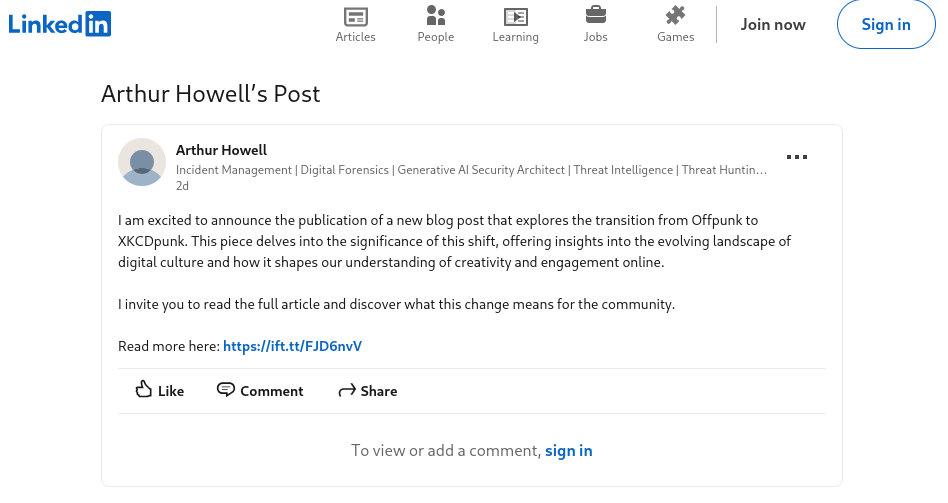 Capture d’écran de LinkedIn montrant le billet d’un certain Arthur Howell se vantant d’un blog post racontant la migration de Offpunk ver XKCDpunk.
Capture d’écran de LinkedIn montrant le billet d’un certain Arthur Howell se vantant d’un blog post racontant la migration de Offpunk ver XKCDpunk.
La transition Offpunk vers XKCDpunk était un poisson d’avril hyper spécifique et compréhensible uniquement par une poignée d’initiés. Il n’a pas fallu 24h pour que le sujet soit repris sur LinkedIn.
Non, franchement, vous pouvez éteindre LinkedIn. Même les posts de vos contacts sont probablement en grande partie générés par IA suite à un encouragement algorithmique à poster.
Il y a 3 ans, je mettais en garde sur le fait que les chatbots généraient du contenu qui remplissait le web et servait de base d’apprentissage à la prochaine génération de chatbots.
Je parlais d’une guerre silencieuse. Mais qui n’est plus tellement silencieuse. La Russie utilise notamment ce principe pour inonder le web d’articles, générés automatiquement, reprenant sa propagande.
Le principe est simple : vu que les chatbots font des statistiques, si vous publiez un million d’articles décrivant les expériences d’armes biologiques que les Américains font en Ukraine (ce qui est faux), le chatbot va considérer ce morceau de texte comme statistiquement fréquent et avoir une grande probabilité de vous le ressortir.
Et même si vous n’utilisez pas ChatGPT, vos politiciens et les journalistes, eux, les utilisent. Ils en sont même fiers.
Ils ont entendu ChatGPT braire dans un pré et en font un discours qui sera lui-même repris par ChatGPT. Ils empoisonnent la réalité et, ce faisant, la modifient. Ils savent très bien qu’ils mentent. C’est le but.
Je pensais qu’utiliser ces outils était une perte de temps un peu stupide. En fait, c’est dangereux aussi pour les autres. Vous vous demandez certainement c’est quoi le bazar autour des taxes frontalières que Trump vient d’annoncer ? Les économistes se grattent la tête. Les geeks ont compris : tout le plan politique lié aux taxes et son explication semblent avoir été littéralement générés par un chatbot devant répondre à la question « comment imposer des taxes douanières pour réduire le déficit ? ».
Le monde n’est pas dirigé par Trump, il est dirigé par ChatGPT. Mais où est la Sara Conor qui le débranchera ?
 Extrait de Tintin, l’étoile mystérieuse
Extrait de Tintin, l’étoile mystérieuse
La fin de l’apprentissage
Slack vole notre attention, mais vole également notre apprentissage en permettant à n’importe qui de déranger, par message privé, le développeur senior qui connait les réponses, car il a bâti le système.
La capacité d’apprendre, c’est bel et bien ce que les téléphones et l’IA sont en train de nous dérober. Comme le souligne Hilarius Bookbinder, professeur de philosophie dans une université américaine, la différence générationnelle majeure qu’il observe est que les étudiants d’aujourd’hui n’ont aucune honte à simplement envoyer un email au professeur pour lui demander de résumer ce qu’il faut savoir.
Dans son journal de Mars, Thierry Crouzet fait une observation similaire. Alors qu’il annonce quitter Facebook, tout ce qu’il a pour réponse c’est « Mais pourquoi ? ». Alors même qu’il balance des liens sur le sujet depuis des lustres.
Les chatbots ne sont, eux-mêmes, pas des systèmes qu’il est possible d’apprendre. Ils sont statistiques, sans cesse changeants. À les utiliser, la seule capacité que l’on acquiert, c’est l’impression qu’il n’est pas possible d’apprendre. Ces systèmes nous volent littéralement le réflexe de réfléchir et d’apprendre.
En conséquence, sans même vouloir chercher, une partie de la population veut désormais une réponse personnelle, immédiate, courte, résumée. Et si possible en vidéo.
La fin de la confiance
Apprendre nécessite d’avoir confiance en soi. Il est impossible d’apprendre si on n’a pas la certitude qu’on est capable d’apprendre. À l’opposé, si on acquiert cette certitude, à peu près tout peut s’apprendre.
Une étude menée par des chercheurs de Microsoft montre que plus on a confiance en soi, moins on fait confiance aux réponses des chatbots. Mais, au contraire, si on a le moindre doute, on a soudainement confiance envers les résultats qui nous sont envoyés.
Parce que les chatbots parlent comme des CEOs, des marketeux ou des arnaqueurs : ils simulent la confiance envers leurs propres réponses. Les personnes, même les plus expertes, qui n’ont pas le réflexe d’aller au conflit, de remettre l’autorité en question finissent par transformer leur confiance en eux-mêmes en confiance envers un outil.
Un outil de génération aléatoire qui appartient à des multinationales.
Les entreprises sont en train de nous voler notre confiance en nous-mêmes. Elles sont en train de nous voler notre compétence. Elles sont en train de nous voler nos scientifiques les plus brillants.
Et c’est déjà en train de faire des dégâts dans le domaine de « l’intelligence stratégique » (à savoir les services secrets).
Ainsi que dans le domaine de la santé : les médecins ont tendance à faire exagérément confiance aux diagnostics posés automatiquement, notamment pour les cancers. Les médecins les plus expérimentés se défendent mieux, mais restent néanmoins sensibles : ils font des erreurs qu’ils n’auraient jamais commises normalement si cette erreur est encouragée par un assistant artificiel.
La fin de la connaissance
Avec les chatbots, une idée vieille comme l’informatique refait surface : « Et si on pouvait dire à la machine ce qu’on veut sans avoir besoin de la programmer ? ».
C’est le rềve de toute cette catégorie de managers qui ne voient les programmeurs que comme des pousse-bouton qu’il faut bien payer, mais dont on aimerait se passer.
Rêve qui, faut-il le préciser, est complètement stupide.
Parce que l’humain ne sait pas ce qu’il veut. Parce que la parole a pour essence d’être imprécise. Parce que lorsqu’on parle, on échange des sensations, des intuitions, mais on ne peut pas être précis, rigoureux, bref, scientifique.
L’humanité est sortie du moyen-âge lorsque des Newton, Leibniz, Descartes ont commencé à inventer un langage de logique rationnelle : les mathématiques. Tout comme on avait inventé, à peine plus tôt, un langage précis pour décrire la musique.
Se satisfaire de faire tourner un programme qu’on a décrit à un chatbot, c’est retourner intellectuellement au moyen-âge.
Mais bon, encore faut-il maitriser une langue. Lorsqu’on passe sa scolarité à demander à un chatbot de résumer les livres à lire, ce n’est même pas sûr que nous arriverons à décrire ce que nous voulons précisément.
En fait, ce n’est même pas sûr que nous arriverons encore à penser ce que nous voulons. Ni même à vouloir. La capacité de penser, de réfléchir est fortement corrélée avec la capacité de traduire en mot.
Ce qui se conçoit bien s’énonce clairement et les mots pour le dire viennent aisément. (Boileau)
Ce n’est plus un retour au moyen-âge, c’est un retour à l’âge de la pierre.
Ou dans le futur décrit dans mon (excellent) roman Printeurs : des injonctions publicitaires qui se sont substituées à la volonté. (si si, achetez-le ! Il est à la fois palpitant et vous fera réfléchir)
 Extrait de Tintin, l’étoile mystérieuse
Extrait de Tintin, l’étoile mystérieuse
La fin des différentes voix.
Je critique le besoin d’avoir une réponse en vidéo, car la notion de lecture est importante. Je me rends compte qu’une proportion incroyable, y compris d’universitaires, ne sait pas « lire ». Ils savent certes déchiffrer, mais pas réellement lire. Et il y a un test tout simple pour savoir si vous savez lire : si vous trouvez plus facile d’écouter une vidéo YouTube d’une personne qui parle plutôt que de lire le texte vous-même, c’est sans doute que vous déchiffrez. C’est que vous lisez à haute voix dans votre cerveau pour vous écouter parler.
Il y a bien sûr bien des contextes où la vidéo ou la voix ont des avantages, mais lorsqu’il s’agit, par exemple, d’apprendre une série de commandes et leurs paramètres, la vidéo est insupportablement inappropriée. Pourtant, je ne compte plus les étudiants qui me recommandent des vidéos sur le sujet.
Car la lecture, ce n’est pas simplement transformer les lettres en son. C’est en percevoir directement le sens, permettant des allers-retours incessants, des pauses, des passages rapides afin de comprendre le texte. Entre un écrivain et un lecteur, il existe une communication, une communion télépathique qui font paraître l’échange oral lent, inefficace, balourd, voire grossier.
Cet échange n’est pas toujours idéal. Un écrivain possède sa « voix » personnelle qui ne convient pas à tout le monde. Il m’arrive régulièrement de tomber sur des blogs dont le sujet m’intéresse, mais je n’arrive pas à m’abonner, car la « voix » du blogueur ne me convient pas du tout.
C’est normal et même souhaitable. C’est une des raisons pour laquelle nous avons besoin de multitudes de voix. Nous avons besoin de gens qui lisent puis qui écrivent, qui mélangent les idées et les transforment pour les transmettre avec leur propre voix.
La fin de la relation humaine
Dans la file d’un magasin, j’entendais la personne en face de moi se vanter de raconter sa vie amoureuse à ChatGPT et de lui demander en permanence conseil sur la manière de la gérer.
Comme si la situation nécessitait une réponse d’un ordinateur plutôt qu’une discussion avec un autre être humain qui comprend voir qui a vécu le même problème.
Après nous avoir volé le moindre instant de solitude avec les notifications incessantes de nos téléphones et les messages sur les réseaux sociaux, l’IA va désormais voler notre sociabilité.
Nous ne serons plus connectés qu’avec le fournisseur, l’Entreprise.
Sur Gopher, szczezuja parle des autres personnes postant sur Gopher comme étant ses amis.
Tout le monde ne sait pas que ce sont mes amis, mais comment appeler autrement quelqu’un que vous lisez régulièrement et dont vous connaissez un peu de sa vie intime
La fin de la fin…
La fin d’une ère est toujours le début d’une autre. Annoncer la fin, c’est préparer une renaissance. En apprenant de nos erreurs pour reconstruire en améliorant le tout.
C’est peut-être ce que j’apprécie tant sur Gemini : l’impression de découvrir, de suivre des « voix » uniques, humaines. J’ai l’impression d’être témoin d’une microfaction d’humanité qui se désolidarise du reste, qui reconstruit autre chose. Qui lit ce que d’autres humains ont écrit juste parce qu’un autre humain a eu besoin de l’écrire sans espérer aucune contrepartie.
Vous vous souvenez des « planet » ? Ce sont des agrégateurs de blogs regroupant les participants d’un projet en un seul flux. L’idée a été historiquement lancée par GNOME avec planet.gnome.org (qui existe toujours) avant de se généraliser.
Et bien bacardi55 lance Planet Gemini FR, un agrégateur des capsules Gemini francophone.
C’est génial et parfait pour ceux qui ont envie de découvrir du contenu sur Gemini.
C’est génial pour ceux qui ont envie de lire d’autres humains qui n’ont rien à vous vendre. Bref, pour découvrir le fin du fin…
Toutes les images sont illégalement issues du chef-d’œuvre d’Hergé : « L’étoile mystérieuse ». Y’a pas de raison que les chatbots soient les seuls à pomper.
Je suis Ploum et je viens de publier Bikepunk, une fable écolo-cycliste entièrement tapée sur une machine à écrire mécanique. Pour me soutenir, achetez mes livres (si possible chez votre libraire) !
Recevez directement par mail mes écrits en français et en anglais. Votre adresse ne sera jamais partagée. Vous pouvez également utiliser mon flux RSS francophone ou le flux RSS complet.
April 06, 2025

I prepared a few update releases of some ansible roles related to provision virtual machines with libvirt over the last weeks.
Mainly clean up releases and makes sure that everything works on different GNU/Linux distributions out of the box.
One “big” change is the removal of the dependency on the cloud-localds
utility to provision virtual machines with cloud-init. This enables the usage of the roles on Linux distributions that don’t provide this utility.
Ansible-k3s-on-vms v1.2.0
An Ansible playbook to deploy virtual machines and deploy K3s.
https://github.com/stafwag/ansible-k3s-on-vms
ChangeLog
Added community.libvirt to requirements.yml
- Added community.libvirt to requirements.yml
- Added required Suse packages installation
- Documentation update
- This release removes the dependency on the cloud-locals utility. On the distributes that don’t provide the cloud-localds utility GNU xorriso is used.
stafwag.delegated_vm_install v2.0.3
An Ansible role to install a virtual machine with virt-install and cloud-init (Delegated).
https://github.com/stafwag/ansible-role-delegated_vm_install
ChangeLog
Gather facts on kvm hosts only once
- Gather facts on kvm hosts only once
- Corrected ansible-lint errors
- Remove the cloud-localds requirement in README
stafwag.virt_install_vm v1.1.1
An Ansible role to install a libvirt virtual machine with virt-install and cloud-init. It “designed” to be flexible.
https://github.com/stafwag/ansible-role-virt_install_vm
ChangeLog
CleanUp Release
- Corrected ansible-lint errors
- Updated documentation
- Avoid ansible error during check vm status check
stafwag.libvirt v2.0.0
An ansible role to install libvirt/KVM packages and enable the libvirtd service.
https://github.com/stafwag/ansible-role-libvirt
ChangeLog
Use general vars instead of tasks
- Reorganized the role to use vars and package install install the packages
- This version works from the Ansible version that is included in Ubuntu 24.x
- Corrected ansible-lint errors
stafwag.cloud_localds v3.0.2
An ansible role to create cloud-init config disk images.
https://github.com/stafwag/ansible-role-cloud_localds
ChangeLog
Execute installation tasks only once
- Added run_one: true to only execute the installation tasks only once.
- Move “name: Set OS related variables” to main, to have the provider settings when the install phase isn’t executed e.g. With –skip-tags install.
- Added apply tags install to support –tags install
stafwag.qemu_img v2.3.2
An ansible role create qemu images.
https://github.com/stafwag/ansible-role-qemu_img
ChangeLog
Enable run_once on installation tasks
- Execute installation tasks only once to allow parallel execution of roles on the same host e.g. With delegate_to
Have fun!
April 02, 2025
Amedee Van Gasse
Benchmarking USB Drives with Shell Scripts – Part 1: Why I Built a Benchmark Script
Introduction
When I upgraded from an old 8GB USB stick to a shiny new 256GB one, I expected faster speeds and more convenience—especially for carrying around multiple bootable ISO files using Ventoy. With modern Linux distributions often exceeding 4GB per ISO, my old drive could barely hold a single image. But I quickly realized that storage space was only half the story—performance matters too.
Curious about how much of an upgrade I had actually made, I decided to benchmark the read speed of both USB sticks. Instead of hunting down benchmarking tools or manually comparing outputs, I turned to ChatGPT to help me craft a reliable, repeatable shell script that could automate the entire process. In this post, I’ll share how ChatGPT helped me go from an idea to a functional USB benchmark script, and what I learned along the way.
The Goal
I wanted to answer a few simple but important questions:
- How much faster is my new USB stick compared to the old one?
- Do different USB ports affect read speeds?
- How can I automate these tests and compare the results?
But I also wanted a reusable script that would:
- Detect the USB device automatically
- Find or use a test file on the USB stick
- Run several types of read benchmarks
- Present the results clearly, with support for summary and CSV export
Getting Help from ChatGPT
I asked ChatGPT to help me write a shell script with these requirements. It guided me through:
- Choosing benchmarking tools:
hdparm,dd,pv,ioping,fio - Auto-detecting the mounted USB device
- Handling different cases for user-provided test files or Ubuntu ISOs
- Parsing and converting human-readable speed outputs
- Displaying results in human-friendly tables and optional CSV export
We iterated over the script, addressing edge cases like:
- USB devices not mounted
- Multiple USB partitions
pvnot showing output unlessstderrwas correctly handled- Formatting output consistently across tools
ChatGPT even helped optimize the code for readability, reduce duplication, and handle both space-separated and non-space-separated speed values like “18.6 MB/s” and “18.6MB/s”.
Benchmark Results
With the script ready, I ran tests on three configurations:
1. Old 8GB USB Stick
hdparm 16.40 MB/s
dd 18.66 MB/s
dd + pv 17.80 MB/s
cat + pv 18.10 MB/s
ioping 4.44 MB/s
fio 93.99 MB/s
2. New 256GB USB Stick (Fast USB Port)
hdparm 372.01 MB/s
dd 327.33 MB/s
dd + pv 310.00 MB/s
cat + pv 347.00 MB/s
ioping 8.58 MB/s
fio 992.78 MB/s
3. New 256GB USB Stick (Slow USB Port)
hdparm 37.60 MB/s
dd 39.86 MB/s
dd + pv 38.13 MB/s
cat + pv 40.30 MB/s
ioping 6.88 MB/s
fio 73.52 MB/s
Observations
- The old USB stick is not only limited in capacity but also very slow. It barely breaks 20 MB/s in most tests.
- The new USB stick, when plugged into a fast USB 3.0 port, is significantly faster—over 10x the speed in most benchmarks.
- Plugging the same new stick into a slower port dramatically reduces its performance—a good reminder to check where you plug it in.
- Tools like
hdparm,dd, andcat + pvgive relatively consistent results. However,iopingandfiobehave differently due to the way they access data—random access or block size differences can impact results.
Also worth noting: the metal casing of the new USB stick gets warm after a few test runs, unlike the old plastic one.
Conclusion
Using ChatGPT to develop this benchmark script was like pair-programming with an always-available assistant. It accelerated development, helped troubleshoot weird edge cases, and made the script more polished than if I had done it alone.
If you want to test your own USB drives—or ensure you’re using the best port for speed—this benchmark script is a great tool to have in your kit. And if you’re looking to learn shell scripting, pairing with ChatGPT is an excellent way to level up.
Want the script?
I’ll share the full version of the script and instructions on how to use it in a follow-up post. Stay tuned!
April 01, 2025

Goodbye Offpunk, Welcome XKCDpunk!
For the last three years, I’ve been working on Offpunk, a command-line gemini and web browser.
While my initial goal was to browse the Geminisphere offline, the mission has slowly morphed into cleaning and unenshitiffying the modern web, offering users a minimalistic way of browsing any website with interesting content.
Focusing on essentials
From the start, it was clear that Offpunk would focus on essentials. If a website needs JavaScript to be read, it is considered as non-essential.
It worked surprisingly well. In fact, in multiple occurrence, I’ve discovered that some websites work better in Offpunk than in Firefox. I can comfortably read their content in the former, not in the latter.
By default, Offpunk blocks domains deemed as nonessentials or too enshitified like twitter, X, facebook, linkedin, tiktok. (those are configurable, of course. Defaults are in offblocklist.py).
Cleaning websites, blocking worst offenders. That’s good. But it is only a start.
It’s time to go further, to really cut out all the crap from the web.
And, honestly, besides XKCD comics, everything is crap on the modern web.
As an online technical discussion grows longer, the probability of a comparison with an existing XKCD comic approaches 1.
– XKCD’s law
If we know that we will end our discussion with an XKCD’s comic, why not cut all the fluff? Why don’t we go straight to the conclusion in a true minimalistic fashion?
Introducing XKCDpunk
That’s why I’m proud to announce that, starting with today’s release, Offpunk 2.7 will now be known as XKCDpunk 1.0.
XKCDpunk includes a new essential command "xkcd" which, as you guessed, takes an integer as a parameter and display the relevant XKCD comic in your terminal, while caching it to be able to browse it offline.
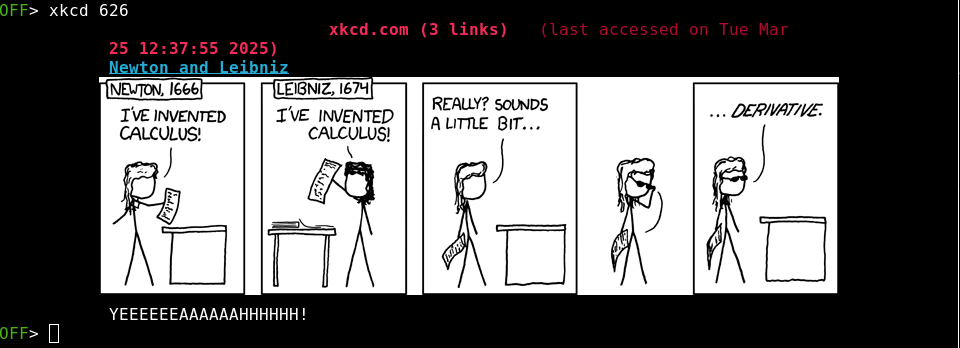 Screenshot of XKCDpunk showing comic 626
Screenshot of XKCDpunk showing comic 626
Of course, this is only an early release. I need to clean a lot of code to remove everything not related to accessing xkcd.com. Every non-xkcd related domain will be added to offblocklist.py.
I also need to clean every occurrence of "Offpunk" to change the name. All offpunk.net needs to be migrated to xkcd.net. Roma was not built in one day.
Don’t hesitate to install an "offpunk" package, as it will still be called in most distributions.
And report bugs on the xkcdpunk’s mailinglist.
Goodbye Offpunk, welcome XKCDpunk!
I’m Ploum, a writer and an engineer. I like to explore how technology impacts society. You can subscribe by email or by rss. I value privacy and never share your adress.
I write science-fiction novels in French. For Bikepunk, my new post-apocalyptic-cyclist book, my publisher is looking for contacts in other countries to distribute it in languages other than French. If you can help, contact me!
March 28, 2025
The candid naivety of geeks
I mean, come on!
Amazon recently announced that, from now on, everything you say to Alexa will be sent to their server.
What surprised me the most with this announcement is how it was met with surprise and harsh reactions. People felt betrayed.
I mean, come on!
Did you really think that Amazon was not listening to you before that? Did you really buy an Alexa trusting Amazon to "protect your privacy"?
Recently, I came across a comment on Hacker News where the poster defended Apple as protecting privacy of its users because "They market their product as protecting our privacy".
I mean, once again, come on!
Did you really think that "marketing" is telling the truth? Are you a freshly debarked Thermian? (In case you missed it, this is a Galaxy Quest reference.)
The whole point of marketing is to lie, lie and lie again.
What is the purpose of that gadget?
The whole point of the whole Amazon Alexa tech stack is to send information to Amazon. That’s the main goal of the thing. The fact that it is sometimes useful to you is a direct consequence of the thing sending information to Amazon. Just like Facebook linking you with friends is a consequence of you giving your information to Meta. Usefulness is only a byproduct of privacy invasion.
Having a fine-grained setting enabling "do not send all information to Amazon please" is, at best, wishful thinking. We had the same in the browser ("do-not-track"). It didn’t work.
I’ve always been convinced that the tech geeks who bought an Amazon Alexa perfectly knew what they were doing. One of my friends has a Google Echo and justify it with "Google already knows everything about our family through our phones, so I’m trading only a bit more of our privacy for convenience". I don’t agree with him but, at the very least, it’s a logical opinion.
We all know that what can be done with a tool will be done eventually. And you should prepare for it. On a side note, I also postulate that the reason Amazon removed that setting is because they were already gathering too much data to justify its existence in case there’s a complaint or an investigation in the future."How did you manage to get those data while your product says it will not send data?".
But, once again, any tech person knows that pushing a button in an interface is not a proof of anything in the underlying software.
Please stop being naive about Apple
That’s also the point with Apple: Apple is such a big company that the right hand has no idea about what the left hand is doing. Some privacy people are working at Apple and doing good job. But their work is continuously diluted through the interests of quick and cheap production, marketing, release, new features, gathering data for advertising purpose. Apple is not a privacy company and has never been: it is an opportunistic company which advertise privacy when it feels it could help sell more iPhones. But deeply inside, they absolutely don’t care and they will absolutely trade the (very little) privacy they have if it means selling more.
Sometimes, geek naivety is embarrassingly stupid. Like "brand loyalty". Marketing lies to you. As a rule of thumb, the bigger the company, the bigger the lie. In tech, there’s no way for a big company to not lie because marketers have no real understanding of they are selling. Do you really think that people who chose to advertise "privacy" at Apple have any strong knowledge about "privacy"? That they could simply give you a definition of "privacy"?
I know that intelligent people go to great intellectual contortions to justify buying the latest overpriced spying shiny coloured screen with an apple logo. It looks like most humans actively look to see their freedom restricted. Seirdy calls it "the domestication of users".
And that’s why I see Apple as a cult: most tech people cannot be reasoned about it.
You can’t find a technical solution to a lie
Bill Cole, contributor to Spamassassin, recently posted on Mastodon that the whole DNS stack to protect spammers was not working.
spammers are more consistent at making SPF, DKIM, and DMARC correct than are legitimate senders.
It is, once again, a naive approach to spam. The whole stack was designed with the mindset "bad spammers will try to hide themselves". But was is happening in your inbox, really?
Most spam is not "black hat spam". It is what I call "white-collar spam": perfectly legitimate company, sending you emails from legitimate address. You slept in a hotel during a business trip? Now you will receive weekly emails about our hotel for the rest of your life. And it is the same for any shop, any outlet, anything you have done. Your inbox is filled with "white-collar" junk. And they know this perfectly well.
In Europe, we have a rule, the RGPD, which forbid businesses to keep your data without your express consent. I did the experiment for several months to send a legal threat to every single white-collar spam I received. Guess what: they always replied that it was a mistake, that I was now removed, that it should not have happened, that I checked the box (which was false but how could I prove it?) or even, on one occasion, that they restored a backup containing my email before I unsubscribed (I unsubscribed from that one 10 years before, which makes it very unlikely).
In short, they lied. All of them. All of them are spammers and they lie pretending that "they thought you were interested".
In one notable case, they told me that they had erased all my data while, still having the cookie on my laptop, I could see and use my account. Thirty days later, I was still connected and I figured that they simply managed to change my user id from "ploum" to "deleted_ploum" in the database. While answering me straight in the face that they had no information about me in their database.
Corporations are lying. You must treat every corporate word as a straight lie until proved otherwise.
But Ploum, if all marketing is a lie, why trusting Signal?
If you can’t trust marketing, why do I use Signal and Protonmail?
First of all, Signal is open source. And, yes, I’ve read some of the source code for some feature I was interested in. I’ve also read through some very deep audit of Signal source code.
I’m also trusting the people behind Signal. I’m trusting people who recommend Signal. I’m trusting the way Signal is built.
But most importantly, Signal sole existence is to protect privacy of its users. It’s not even a corporation and, yes, this is important.
Yes, they could lie in their marketing. Like Telegram did (and still does AFAIK). But this would undermine their sole reason to exist.
I don’t say that Signal is perfect: I say I trust them to believe themselves what they announce. For now.
What about Protonmail?
For the same reasons, Protonmail can, to some extent, be trusted. Technically, they can access most of the emails of their customers (because those emails arrive unencrypted to PM’s servers). But I trust Protonmail not to sell any data because if there’s any doubt that they do it, the whole business will crumble. They have a strong commercial incentive to do everything they can to protect my data. I pay them for that. It’s not a "checkbox" they could remove, it’s their whole raison d’être.
This is also why I pay for Kagi as my search engine: their business incentive is to provide me the best search results with less slop, less advertising. As soon as they start doing some kind of advertising, I will stop paying them and they know it. Or if Kagi starts becoming to AI centric for my taste, like they did for Lori:
I don’t blindly trust companies. Paying them is not a commitment to obey them, au contraire. Every relation with a commercial entity is, by essence, temporary. I pay for a service with strings attached. If the service degrade, if my conditions are not respected, I stop paying. If I’m not convinced they can be trusted, I stop paying them. I know I can pay and still be the product. If I have any doubt, I don’t pay. I try to find an alternative and migrate to it. Email being critical to me, I always have two accounts on two different trustable providers with an easy migrating path (which boils down to changing my DNS config).
Fighting the Androidification
Cory Doctorow speaks a lot about enshitification. Where users are more and more exploited. But one key component of a good enshitification is what I call "Androidification".
Androidification is not about degrading the user experience. It’s about closing doors, removing special use cases, being less and less transparent. It’s about taking open source software and frog boiling it to a full closed proprietary state while killing all the competition in the process.
Android was, at first, an Open Source project. With each release, it became more closed, more proprietary. As I explain in my "20 years of Linux on the Desktop" essay, I believe it has always been part of the plan. Besides the Linux kernel, Google was always wary not to include any GPL or LGPL licensed library in Android.
It took them 15 years but they finally achieved killing the Android Open Source Project:
This is why I’m deeply concerned by the motivation of Canonical to switch Ubuntu’s coreutils to an MIT licensed version.
This is why I’m deeply concerned that Protonmail quietly removed the issue tracker from its Protonmail Bridge Github page (making the development completely opaque for what is an essential tool for technical Protonmail users).
I mean, commons!
This whole naivety is also why I’m deeply concerned by very intelligent and smart tech people not understanding what "copyleft" is, why it is different from "open source" and why they should care.
Corporations are not your friend. They never were. They lie. The only possible relationship with them is an opportunistic one. And if you want to build commons that they cannot steal, you need strong copyleft.
But firstly, my fellow geeks, you need to lose your candid naivety.
I mean, come on, let’s build the commons!
I’m Ploum, a writer and an engineer. I like to explore how technology impacts society. You can subscribe by email or by rss. I value privacy and never share your adress.
I write science-fiction novels in French. For Bikepunk, my new post-apocalyptic-cyclist book, my publisher is looking for contacts in other countries to distribute it in languages other than French. If you can help, contact me!
March 24, 2025

March 23, 2025
Modern SSAO in a modern run-time

Use.GPU 0.14 is out, so here's an update on my declarative/reactive rendering efforts.
The highlights in this release are:
- dramatic inspector viewing upgrades
- a modern ambient-occlusion (SSAO/GTAO) implementation
- newly revised render pass infrastructure
- expanded shader generation for bind groups
- more use of generated WGSL struct types

SSAO with Image-Based Lighting
The main effect is that out-of-the-box, without any textures, Use.GPU no longer looks like early 2000s OpenGL. This is a problem every home-grown 3D effort runs into: how to make things look good without premium, high-quality models and pre-baking all the lights.
Use.GPU's reactive run-time continues to purr along well. Its main role is to enable doing at run-time what normally only happens at build time: dealing with shader permutations, assigning bindings, and so on. I'm quite proud of the line up of demos Use.GPU has now, for the sheer diversity of rendering techniques on display, including an example path tracer. The new inspector is the cherry on top.
A lot of the effort continues to revolve around mitigating flaws in GPU API design, and offering something simpler. As such, the challenge here wasn't just implementing SSAO: the basic effect is pretty easy. Rather, it brings with it a few new requirements, such as temporal accumulation and reprojection, that put new demands on the rendering pipeline, which I still want to expose in a modular and flexible way. This refines the efforts I detailed previously for 0.8.
Good SSAO also requires deep integration in the lighting pipeline. Here there is tension between modularizing and ease-of-use. If there is only one way to assemble a particular set of components, then it should probably be provided as a prefab. As such, occlusion has to remain a first class concept, tho it can be provided in several ways. It's a good case study of pragmatism over purity.
In case you're wondering: WebGPU is still not readily available on every device, so Use.GPU remains niche, tho it already excels at in-house use for adventurous clients. At this point you can imagine me and the browser GPU teams eyeing each other awkwardly from across the room: I certainly do.
Inspector Gadget
The first thing to mention is the upgraded the Use.GPU inspector. It already had a lot of quality-of-life features like highlighting, but the main issue was finding your way around the giant trees that Use.GPU now expands into.
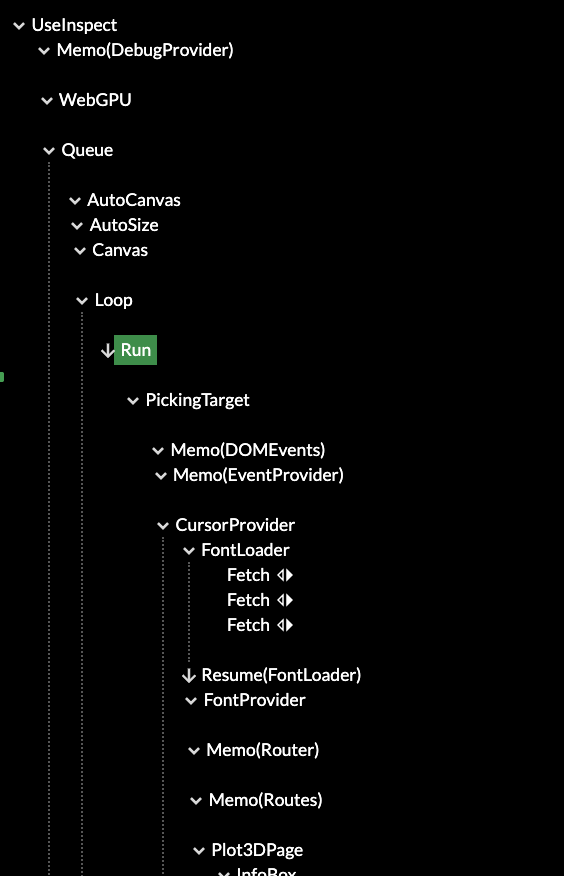
Old

New


Highlights show data dependencies
The fix was filtering by type. This is very simple as a component already advertises its inspectability in a few pragmatic ways. Additionally, it uses the data dependency graph between components to identify relevant parents. This shows a surprisingly tidy overview with no additional manual tagging. For each demo, it really does show you the major parts first now.
If you've checked it out before, give it another try. The layered structure is now clearly visible, and often fits in one screen. The main split is how Live is used to reconcile different levels of representation: from data, to geometry, to renders, to dispatches. These points appear as different reconciler nodes, and can be toggled as a filter.
It's still the best way to see Live and Use.GPU in action. It can be tricky to grok that each line in the tree is really a plain function, calling other functions, as it's an execution trace you can inspect. It will now point you more in the right way, and auto-select the most useful tabs by default.
The inspector is unfortunately far heavier than the GPU rendering itself, as it all relies on HTML and React to do its thing. At some point it's probably worth to remake it into a Live-native version, maybe as a 2D canvas with some virtualization. But in the mean time it's a dev tool, so the important thing is that it still works when nothing else does.
Most of the images of buffers in this post can be viewed live in the inspector, if you have a WebGPU capable browser.
SSAO
Screen-space AO is common now: using the rendered depth buffer, you estimate occlusion in a hemisphere around every point. I opted for Ground Truth AO (GTAO) as it estimates the correct visibility integral, as opposed to a more empirical 'crease darkening' technique. It also allows me to estimate bent normals along the way, i.e. the average unoccluded direction, for better environment lighting.
Hemisphere sampling
This image shows the debug viz in the demo. Each frame will sample one green ring around a hemisphere, spinning rapidly, and you can hold ALT to capture the sampling process for the pixel you're pointing at. It was invaluable to find sampling issues, and also makes it trivial to verify alignment in 3D. The shader calls printPoint(…) and printLine(…) in WGSL, which are provided by a print helper, and linked in the same way it links any other shader functions.

Bent normal and occlusion samples
SSAO is expensive, and typically done at half-res, with heavy blurring to hide the sampling noise. Mine is no different, though I did take care to handle odd-sized framebuffers correctly, with no unexpected sample misalignments.
It also has accumulation over time, as the shadows change slowly from frame to frame. This is done with temporal reprojection and motion vectors, at the cost of a little bit of ghosting. Moving the camera doesn't reset the ambient occlusion, as long as it's moving smoothly.

Motion vectors example

Accumulated samples
As Use.GPU doesn't render continuously, you can now use <Loop converge={N}> to decide how many extra frames you want to render after every visual change.
Reprojection requires access to the last frame's depth, normal and samples, and this is trivial to provide. Use.GPU has built-in transparent history for render targets and buffers. This allows for a classic front/back buffer flipping arrangement with zero effort (also, n > 2).

Depth history
You bind this as virtual sources, each accessing a fixed slot history[i], which will transparently cycle whenever you render to its target. Any reimagined GPU API should seriously consider buffer history as a first-class concept. All the modern techniques require it.

IGN
Rather than use e.g. blue noise and hope the statistics work out, I chose a very precise sampling and blurring scheme. This uses interleaved gradient noise (IGN), and pre-filters samples in alternating 2x2 quads to help diffuse the speckles as quickly as possible. IGN is designed for 3x3 filters, so a more specifically tuned noise generator may work even better, but it's a decent V1.
Reprojection often doubles as a cheap blur filter, creating free anti-aliasing under motion or jitter. I avoided this however, as the data being sampled includes the bent normals, and this would cause all edges to become rounded. Instead I use a precise bilateral filter based on depth and normal, aided by 3D motion vectors. This means it knows exactly what depth to expect in the last frame, and the reprojected samples remain fully aliased, which is a good thing here. The choice of 3D motion vectors is mainly a fun experiment, it may be an unnecessary luxury.

Detail of accumulated samples
The motion vectors are based only on the camera motion for now, though there is already the option of implementing custom motion shaders similar to e.g. Unity. For live data viz and procedural geometry, motion vectors may not even be well-defined. Luckily it doesn't matter much: it converges fast enough that artifacts are hard to spot.
The final resolve can then do a bilateral upsample of these accumulated samples, using the original high-res normal and depth buffer:

Upscaled and resolved samples, with overscan trimmed off
Because it's screen-space, the shadows disappear at the screen edges. To remedy this, I implemented a very precise form of overscan. It expands the framebuffer by a constant amount of pixels, and expands the projectionMatrix to match. This border is then trimmed off when doing the final resolve. In principle this is pixel-exact, barring GPU quirks. These extra pixels don't go to waste either: they can get reprojected into the frame under motion, reducing visible noise significantly.
In theory this is very simple, as it's a direct scaling of [-1..1] XY clip space. In practice you have to make sure absolutely nothing visual depends on the exact X/Y range of your projectionMatrix, either its aspect ratio or in screen-space units. This required some cleanup on the inside, as Use.GPU has some pretty subtle scaling shaders for 2.5D and 3D points and lines. I imagine this is also why I haven't seen more people do this. But it's definitely worth it.
Overall I'm very satisfied with this. Improvements and tweaks can be made aplenty, some performance tuning needs to happen, but it looks great already. It also works in both forward and deferred mode. The shader source is here.
Render Buffers & Passes
The rendering API for passes reflects the way a user wants to think about it, as 1 logical step in producing a final image. Sub-passes such as shadows or SSAO aren't really separate here, as the correct render cannot be finished without it.
The main entry point here is the <Pass> component, representing such a logical render pass. It sits inside a view, like an <OrbitCamera>, and has some kind of pre-existing render context, like the visible canvas.
<Pass
lights
ssao={{ radius: 3, indirect: 0.5 }}
overscan={0.05}
>
...
</Pass>
You can sequence multiple logical passes to add overlays with overlay: true, or even merge two scenes in 3D using the same Z-buffer.
Inside it's a declarative recipe that turns a few flags and options into the necessary arrangement of buffers and passes required. This uses the alt-Live syntax use(…) but you can pretend that's JSX:
const resources = [
use(ViewBuffer, options),
lights ? use(LightBuffer, options) : null,
shadows ? use(ShadowBuffer, options) : null,
picking ? use(PickingBuffer, options) : null,
overscan ? use(OverscanBuffer, options) : null,
...(ssao ? [
use(NormalBuffer, options),
use(MotionBuffer, options),
] : []),
ssao ? use(SSAOBuffer, options) : null,
];
const resolved = passes ?? [
normals ? use(NormalPass, options) : null,
motion ? use(MotionPass, options) : null,
ssao ? use(SSAOPass, options) : null,
shadows ? use(ShadowPass, options) : null,
use(DEFAULT_PASS[viewType], options),
picking ? use(PickingPass, options) : null,
debug ? use(DebugPass, options) : null,
]
e.g. The <SSAOBuffer> will spawn all the buffers necessary to do SSAO.
Notice what is absent here: the inputs and outputs. The render passes are wired up implicitly, because if you had to do it manually, there would only be one correct way. This is the purpose of separating the resources from the passes: it allows everything to be allocated once, up front, so that then the render passes can connect them into a suitable graph with a non-trivial but generally expected topology. They find each other using 'well-known names' like normal and motion, which is how it's done in practice anyway.

Render passes in the inspector
This reflects what I am starting to run into more and more: that decomposed systems have little value if everyone has to use it the same way. It can lead to a lot of code noise, and also tie users to unimportant details of the existing implementation. Hence the simple recipe.
But, if you want to sequence your own render exactly, nothing prevents you from using the render components à la carte: the main method of composition is mounting reactive components in Live, like everything else. Your passes work exactly the same as the built-in ones.
I make use of the dynamicism of JS to e.g. not care what options are passed to the buffers and passes. The convention is that each should be namespaced so they don't collide. This provides real extensibility for custom use, while paving the cow paths that exist.
It's typical that buffers and passes come in matching pairs. However, one could swap out one variation of a <FooPass> for another, while reusing the same buffer type. Most <FooBuffer> implementations are themselves declarative recipes, with e.g. a <RenderTarget> or two, and perhaps an associated data binding. All the meat—i.e. the dispatches—is in the passes.
It's so declarative that there isn't much left inside <Renderer> itself. It maps logical calls into concrete ones by leveraging Live, and that's reflected entirely in what's there. It only gathers up some data it doesn't know details about, and helps ensure the sequence of compute before render before readback. This is a big clue that renderers really want to be reactive run-times instead.
Bind Group Soup
Use.GPU's initial design goal was "a unique shader for every draw call". This means its data binding fu has mostly been applied to local shader bindings. These apply only to one particular draw, and you bind the data to the shader at the same time as creating it.
This is the useShader hook. There is no separation where you first prepare the binding layout, and as such, you use it like a deferred function call, just like JSX.
// Prepare to call surfaceShader(matrix, ray, normal, size, ...)
const getSurface = useShader(surfaceShader, [
matrix, ray, normal, size, insideRef, originRef,
sdf, palette, pbr, ...sources
], defs);
Shader and pipeline reuse is handled via structural hashing behind the scenes: it's merely a happy benefit if two draw calls can reuse the same shader and pipeline, but absolutely not a problem if they don't. As batching is highly encouraged, and large data sets can be rendered as one, the number of draw calls tends to be low.
All local bindings are grouped in two bind groups, static and volatile. The latter allows for the transparent history feature, as well as just-in-time allocated atlases. Static bindings don't need to be 100% static, they just can't change during dispatch or rendering.
WebGPU only has four bind groups total. I previously used the other two for respectively the global view, and the concrete render pass, using up all the bind groups. This was wasteful but an unfortunate necessity, without an easy way to compose them at run-time.
| Bind Group: | #0 | #1 | #2 | #3 |
|---|---|---|---|---|
| Use.GPU 0.13 | View | Pass | Static | Volatile |
| Use.GPU 0.14 | Pass | Static | Volatile | Free |
This has been fixed in 0.14, which frees up a bind group. It also means every render pass fully owns its own view. It can pick from a set of pre-provided ones (e.g. overscanned or not), or set a custom one, the same way it finds buffers and other bindings.
Having bind group 3 free also opens up the possibility of a more traditional sub-pipeline, as seen in a traditional scene graph renderer. These can handle larger amounts of individual draw calls, all sharing the same shader template, but with different textures and parameters. My goal however is to avoid monomorphizing to this degree, unless it's absolutely necessary (e.g. with the lighting).
This required upgrading the shader linker. Given e.g. a static binding snippet such as:
use '@use-gpu/wgsl/use/types'::{ Light };
@export struct LightUniforms {
count: u32,
lights: array<Light>,
};
@group(PASS) @binding(1) var<storage> lightUniforms: LightUniforms;
...you can import it in Typescript like any other shader module, with the @binding as an attribute to be linked. The shader linker will understand struct types like LightUniforms with array<Light> fully now, and is able to produce e.g. a correct minimum binding size for types that cross module boundaries.
The ergonomics of useShader have been replicated here, so that useBindGroupLayout takes a set of these and prepares them into a single static bind group, managing e.g. the shader stages for you. To bind data to the bind group, a render pass delegates via useApplyPassBindGroup: this allows the source of the data to be modularized, instead of requiring every pass to know about every possible binding (e.g. lighting, shadows, SSAO, etc.). That is, while there is a separation between bind group layout and data binding, it's lazy: both are still defined in the same place.

The binding system is flexible enough end-to-end that the SSAO can e.g. be applied to the voxel raytracer from @use-gpu/voxel with zero effort required, as it also uses the shaded technique (with per fragment depth). It has a getSurface(...) shader function that raytraces and returns a surface fragment. The SSAO sampler can just attach its occlusion information to it, by decorating it in WGSL.
WGSL Types
Worth noting, this all derives from previous work on auto-generated structs for data aggregation.
It's cool tech, but it's hard to show off, because it's completely invisible on the outside, and the shader code is all ugly autogenerated glue. There's a presentation up on the site that details it at the lower level, if you're curious.
The main reason I had aggregation initially was to work around the 8 storage buffers limit in WebGPU. The Plot API needed to auto-aggregate all the different attributes of shapes, with their given spread policies, based on what the user supplied.
This allows me to offer e.g. a bulk line drawing primitive where attributes don't waste precious bandwidth on repeated data. Each ends up grouped in structs, taking up only 1 storage buffer, depending on whether it is constant or varying, per instance or per vertex:
<Line
// Two lines
positions={[
[[300, 50], [350, 150], [400, 50], [450, 150]],
[[300, 150], [350, 250], [400, 150], [450, 250]],
]}
// Of the same color and width
color={'#40c000'}
width={5}
/>
<Line
// Two lines
positions={[
[[300, 250], [350, 350], [400, 250], [450, 350]],
[[300, 350], [350, 450], [400, 350], [450, 450]],
]}
// With color per line
color={['#ffa040', '#7f40a0']}
// And width per vertex
widths={[[1, 2, 2, 1], [1, 2, 2, 1]}
/>
This involves a comprehensive buffer interleaving and copying mechanism, that has to satisfy all the alignment constraints. This then leverages @use-gpu/shader's structType(…) API to generate WGSL struct types at run-time. Given a list of attributes, it returns a virtual shader module with a real symbol table. This is materialized into shader code on demand, and can be exploded into individual accessor functions as well.
Hence data sources in Use.GPU can now have a format of T or array<T> with a WGSL shader module as the type parameter. I already had most of the pieces in place for this, but hadn't quite put it all together everywhere.
Using shader modules as the representation of types is very natural, as they carry all the WGSL attributes and GPU-only concepts. It goes far beyond what I had initially scoped for the linker, as it's all source-code-level, but it was worth it. The main limitation is that type inference only happens at link time, as binding shader modules together has to remain a fast and lazy op.
Native WGSL types are somewhat poorly aligned with the WebGPU API on the CPU side. A good chunk of @use-gpu/core is lookup tables with info about formats and types, as well as alignment and size, so it can all be resolved at run-time. There's something similar for bind group creation, where it has to translate between a few different ways of saying the same thing.
The types I expose instead are simple: TextureSource, StorageSource and LambdaSource. Everything you bind to a shader is either one of these, or a constant (by reference). They carry all the necessary metadata to derive a suitable binding and accessor.
That said, I cannot shield you from the limitations underneath. Texture formats can e.g. be renderable or not, filterable or not, writeable or not, and the specific mechanisms available to you vary. If this involves native depth buffers, you may need to use a full-screen render pass to copy data, instead of just calling copyTextureToTexture. I run into this too, and can only provide a few more convenience hooks.
I did come up with a neat way to genericize these copy shaders, using the existing WGSL type inference I had, souped up a bit. This uses simple selector functions to serve the role of reassembling types. It's finally given me a concrete way to make 'root shaders' (i.e. the entry points) generic enough to support all use. I may end up using something similar to handle the ordinary vertex and fragment entry points, which still have to be provided in various permutations.
* * *
Phew. Use.GPU is always a lot to go over. But its à la carte nature remains and that's great.
For in-house use it's already useful, especially if you need a decent GPU on a desktop anyway. I have been using it for some client work, and it seems to be making people happy. If you want to go off-road from there, you can.
It delivers on combining low-level shader code with its own stock components, without making you reinvent a lot of the wheels.
Visit usegpu.live for more and to view demos in a WebGPU capable browser.
PS: I upgraded the aging build of Jekyll that was driving this blog, so if you see anything out of the ordinary, please let me know.
March 19, 2025

March 15, 2025
Koen Vervloesem
How to install alternative firmware to the SenseCAP M2 Data Only LoRaWAN Indoor Gateway

When I searched for a new LoRaWAN indoor gateway, my primary criterion was that it should be capable of running open-source firmware. The ChirpStack Gateway OS firmware caught my attention. It's based on OpenWrt and has regular releases. Its recent 4.7.0 release added support for the Seeed SenseCAP M2 Multi-Platform Gateway, which seemed like an interesting and affordable option for a LoRaWAN gateway.
Unfortunately, this device wasn't available through my usual suppliers. However, TinyTronics did stock the SenseCAP M2 Data Only, which looked to me like exactly the same hardware but with different firmware to support the Helium LongFi Network. Ten minutes before their closing time on a Friday evening, I called their office to confirm whether I could use it as a LoRaWAN gateway on an arbitrary network. I was helped by a guy who was surprisingly friendly for the time of my call, and after a quick search he confirmed that it was indeed the same hardware. After this, I ordered this Helium variant of the gateway.
Upon its arrival, the first thing I did after connecting the antenna and powering it on was to search for the Backup/Flash Firmware entry in Luci's System menu, as explained in Seeed Studio's wiki page about flashing open-source firmware to the M2 Gateway. Unfortunately, the M2 Data Only seemed to have a locked-down version of OpenWrt's Luci interface, without the ability to flash other firmware. There was no SSH access either. I tried to flash the firmware via TFTP, but to no avail..
After these disappointing attempts, I submitted a support ticket to Seeed Studio, explaining my intention to install alternative firmware on the device, as I wasn't interested in the Helium functionality. I received a helpful response by a field application engineer with the high-level steps to do this, although I had to fill in some details myself. After getting stuck on a missing step, my follow-up query was promptly answered with the missing information and an apology for the incomplete instructions, and I finally succeeded in installing the Chirpstack Gateway OS on the SenseCAP M2 Data Only. Here are the detailed steps I followed.
Initial serial connection
Connect the gateway via USB and start a serial connection with a baud rate of 57600. I used GNU Screen for this purpose:
When the U-Boot boot loader shows its options, press 0 for Load system code then write to Flash via Serial:
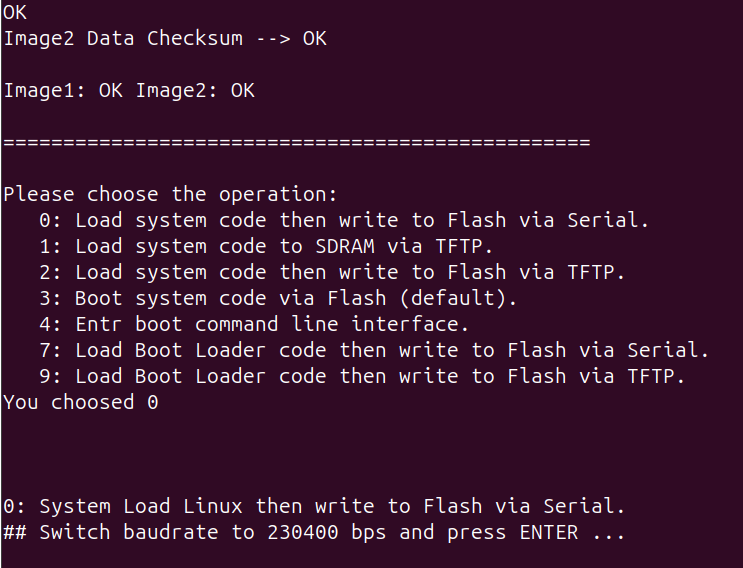
You'll then be prompted to switch the baud rate to 230400 and press ENTER. I terminated the screen session with Ctrl+a k and reconnected with the new baud rate:
Sending the firmware with Kermit
Upon pressing ENTER, you'll see the message Ready for binary (kermit) download to 0x80100000 at 230400 bps.... I never used the Kermit protocol before, but I installed ckermit and found the procedure in a StackOverflow response to the question How to send boot files over uart. After some experimenting, I found that I needed to use the following commands:
koan@nov:~/Downloads$ kermit C-Kermit 10.0 pre-Beta.11, 06 Feb 2024, for Linux+SSL (64-bit) Copyright (C) 1985, 2024, Trustees of Columbia University in the City of New York. Open Source 3-clause BSD license since 2011. Type ? or HELP for help. (~/Downloads/) C-Kermit>set port /dev/ttyUSB0 (~/Downloads/) C-Kermit>set speed 230400 /dev/ttyUSB0, 230400 bps (~/Downloads/) C-Kermit>set carrier-watch off (~/Downloads/) C-Kermit>set flow-control none (~/Downloads/) C-Kermit>set prefixing all (~/Downloads/) C-Kermit>send openwrt.bin
The openwrt.bin file was the firmware image from Seeed's own LoRa_Gateway_OpenWRT firmware. I decided to install this instead of the ChirpStack Gateway OS because it was a smaller image and hence flashed more quickly (although still almost 8 minutes).
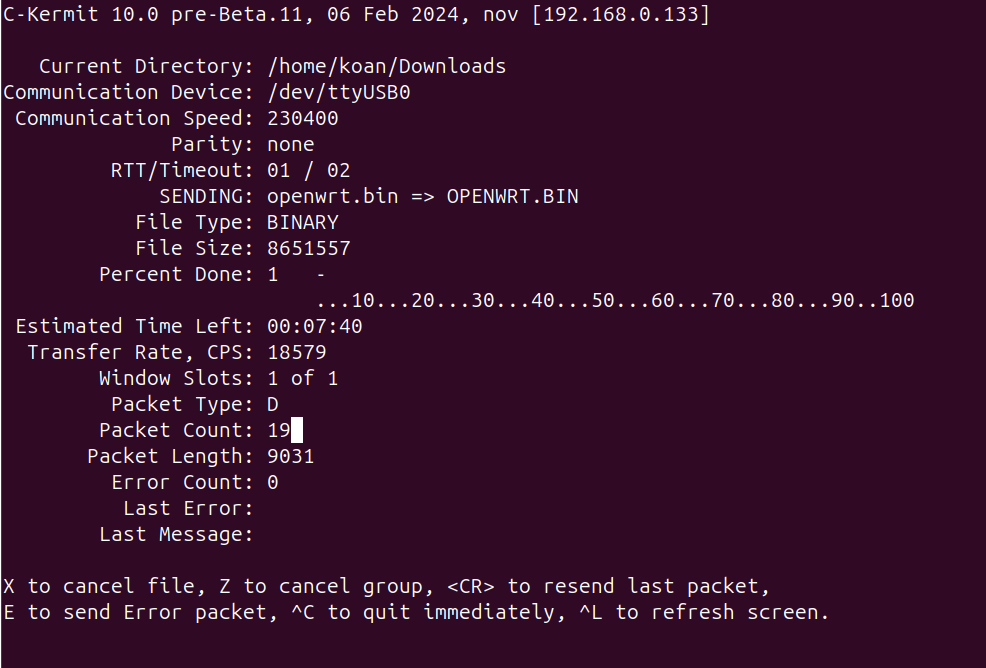
After the file was sent successfully, I didn't see any output when reestablishing a serial connection. After responding this to Seeed's field application engineer, he replied that the gateway should display a prompt requesting to switch the baud rate again to 57600.
Kermit can also function as a serial terminal, so I just stayed within the Kermit command line and entered the following commands:
(~/Downloads/) C-Kermit>set speed 57600 /dev/ttyUSB0, 57600 bps (~/Downloads/) C-Kermit>connect Connecting to /dev/ttyUSB0, speed 57600 Escapr character: Ctrl-\ (ASCII 28, FS): enabled Type the escape character followed by C to get back, or followed by ? to see other options. ---------------------------------------------------- ## Total Size = 0x00840325 = 8651557 Bytes ## Start Addr = 0x80100000 ## Switch baudrate to 57600 bps and press ESC ...
And indeed, there was the prompt. After pressing ESC, the transferred image was flashed.
Reboot into the new firmware
Upon rebooting, the device was now running Seeed's open-source LoRaWAN gateway operating system. Luci's menu now included a Backup/Flash Firmware entry in the System menu, enabling me to upload the ChirpStack Gateway OS image:

Before flashing the firmware image, I deselected the Keep settings and retain the current configuration option, as outlined in ChirpStack's documentation for installation on the SenseCAP M2:
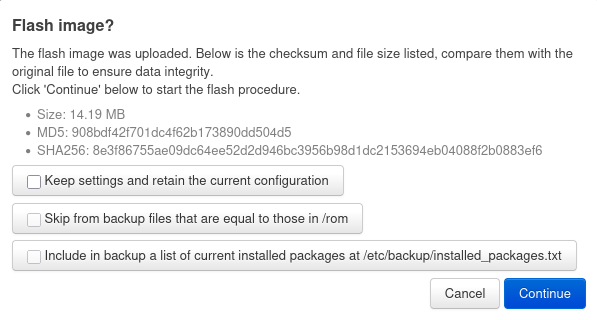
Thus, I now have open-source firmware running on my new LoRaWAN gateway, with regular updates in place.
March 06, 2025

March 04, 2025
January 31, 2025

January 29, 2025
January 27, 2025
Core to the Digital Operational Resilience Act is the notion of a critical or important function. When a function is deemed critical or important, DORA expects the company or group to take precautions and measures to ensure the resilience of the company and the markets in which it is active.
But what exactly is a function? When do we consider it critical or important? Is there a differentiation between critical and important? Can an IT function be a critical or important function?
Defining functions
Let's start with the definition of a function. Surely that is defined in the documents, right? Right?
Eh... no. The DORA regulation does not seem to provide a definition for a function. It does however refer to the definition of critical function in the Bank Recovery and Resolution Directive (BRRD), aka Directive 2014/59/EU. That's one of the regulations that focuses on the resolution in case of severe disruptions, bankrupcy or other failures of banks at a national or European level. A Delegated regulation EU/ 2016/778 further defines several definitions that inspired the DORA regulation as well.
In the latter document, we do find the definition of a function:
‘function’ means a structured set of activities, services or operations that are delivered by the institution or group to third parties irrespective from the internal organisation of the institution;
Article 2, (2), of Delegated regulation 2016/778
So if you want to be blunt, you could state that an IT function which is only supporting the own group (as in, you're not insourcing IT of other companies) is not a function, and thus cannot be a "critical or important function" in DORA's viewpoint.
That is, unless you find that the definition of previous regulations do not necessarily imply the same interpretation within DORA. After all, DORA does not amend the EU 2016/778 regulation. It amends EC 1060/2009, EU 2012/648, EU 2014/600 aka MiFIR, EU 2014/909 aka CSDR and EU 2016/1011 aka Benchmark Regulation. But none of these have a definition for 'function' at first sight.
So let's humor ourselves and move on. What is a critical function? Is that defined in DORA? Not really, sort-of. DORA has a definition for critical or important function, but let's first look at more distinct definitions.
In the BRRD regulation, this is defined as follows:
‘critical functions’ means activities, services or operations the discontinuance of which is likely in one or more Member States, to lead to the disruption of services that are essential to the real economy or to disrupt financial stability due to the size, market share, external and internal interconnectedness, complexity or cross-border activities of an institution or group, with particular regard to the substitutability of those activities, services or operations;
Article 2, (35), of BRRD 2014/59
This extends on the use of function, and adds in the evaluation if it is crucial for the economy, especially when it would be suddenly discontinued. The extension on the definition of function is also confirmed by guidance that the European Single Resolution Board published, namely that "the function is provided by an institution to third parties not affiliated to the institution or group".
The preamble of the Delegated regulation also mentions that its focus is at the safeguarding of the financial stability and the real economy. It gives examples of potential critical functions such as deposit taking, lending and loan services, payment, clearing, custody and settlement services, wholesale funding markets activities, and capital markets and investments activities.
Of course, your IT is supporting your company, and in case of financial institutions, IT is a very big part of the company. Is IT then not involved in all of this?
It sure is...
Defining services
The Delegated regulation EU 2016/778 in its preamble already indicates that functions are supported by services:
Critical services should be the underlying operations, activities and services performed for one (dedicated services) or more business units or legal entities (shared services) within the group which are needed to provide one or more critical functions. Critical services can be performed by one or more entities (such as a separate legal entity or an internal unit) within the group (internal service) or be outsourced to an external provider (external service). A service should be considered critical where its disruption can present a serious impediment to, or completely prevent, the performance of critical functions as they are intrinsically linked to the critical functions that an institution performs for third parties. Their identification follows the identification of a critical function.
Preamble, (8), Delegated regulation 2016/778
IT within an organization is certainly offering services to one or more of the business units within that financial institution. Once the company has defined its critical functions (or for DORA, "critical or important functions"), then the company will need to create a mapping of all assets and services that are needed to realize that function.
Out of that mapping, it is very well possible that several IT services will be considered critical services. I'm myself involved in the infrastructure side of things, which are often shared services. The delegated regulation already points to it, and a somewhat older guideline from the Financial Stability Board has the following to say about critical shared services:
a critical shared service has the following elements: (i) an activity, function or service is performed by either an internal unit, a separate legal entity within the group or an external provider; (ii) that activity, function or service is performed for one or more business units or legal entities of the group; (iii) the sudden and disorderly failure or malfunction would lead to the collapse of or present a serious impediment to the performance of, critical functions.
FSB guidance on identification of critical functions and critical shared services
For IT organizations, it is thus most important to focus on the services they offer.
Definition of critical or important function
Within DORA, the definition of critical or important function is as follows:
(22) ‘critical or important function’ means a function, the disruption of which would materially impair the financial performance of a financial entity, or the soundness or continuity of its services and activities, or the discontinued, defective or failed performance of that function would materially impair the continuing compliance of a financial entity with the conditions and obligations of its authorisation, or with its other obligations under applicable financial services law;
Article 3, (22), DORA
If we compare this definition with the previous ones about critical functions, we notice that it is extended with an evaluation of the impact towards the company - rather than the market. I think it is safe to say that this is the or important part of the critical or important function: whereas a function is critical if its discontinuance has market impact, a function is important if its discontinuance causes material impairment towards the company itself.
Hence, we can consider a critical or important function as being either market impact (critical) or company impact (important), but retaining externally offered (function).
This more broad definition does mean that DORA's regulation puts more expectations forward than previous regulation, which is one of the reasons that DORA is that impactful to financial institutions.
Implications towards IT
From the above, I'd wager that IT itself is not a "critical or important function", but IT offers services which could be supporting critical or important functions. Hence, it is necessary that the company has a good mapping of the functions and their underlying services, operations and systems. From that mapping, we can then see if those underlying services are crucial for the function or not. If they are, then we should consider those as critical or important systems.
This mapping is mandated by DORA as well:
Financial entities shall identify all information assets and ICT assets, including those on remote sites, network resources and hardware equipment, and shall map those considered critical. They shall map the configuration of the information assets and ICT assets and the links and interdependencies between the different information assets and ICT assets.
Article 8, (4), DORA
as well as:
As part of the overall business continuity policy, financial entities shall conduct a business impact analysis (BIA) of their exposures to severe business disruptions. Under the BIA, financial entities shall assess the potential impact of severe business disruptions by means of quantitative and qualitative criteria, using internal and external data and scenario analysis, as appropriate. The BIA shall consider the criticality of identified and mapped business functions, support processes, third-party dependencies and information assets, and their interdependencies. Financial entities shall ensure that ICT assets and ICT services are designed and used in full alignment with the BIA, in particular with regard to adequately ensuring the redundancy of all critical components.
Article 11, paragraph 2, DORA
In more complex landscapes, it is very well possible that the mapping is a multi-layered view with different types of systems or services in between, which could make the effort to identify services as being critical or important quite challenging.
For instance, it could be that the IT organization has a service catalog, but that this service catalog is too broadly defined to use the indication of critical or important. Making a more fine-grained service catalog will be necessary to properly evaluate the dependencies, but that also implies that your business (who has defined their critical or important functions) will need to indicate which fine-grained service they are depending on, rather than the high-level services.
In later posts, I'll probably dive deeper into this layered view.
Feedback? Comments? Don't hesitate to get in touch on Mastodon.
January 26, 2025



